Solid-State Li-S Batteries and Methods of Making Same
WACHSMAN; Eric D. ; et al.
U.S. patent application number 15/779930 was filed with the patent office on 2020-03-05 for solid-state li-s batteries and methods of making same. This patent application is currently assigned to University of Maryland, College Park. The applicant listed for this patent is University of Maryland, College Park. Invention is credited to Kun FU, Fudong HAN, Liangbing HU, Eric D. WACHSMAN, Chunsheng WANG, Yang WEN.
| Application Number | 20200075960 15/779930 |
| Document ID | / |
| Family ID | 59227394 |
| Filed Date | 2020-03-05 |
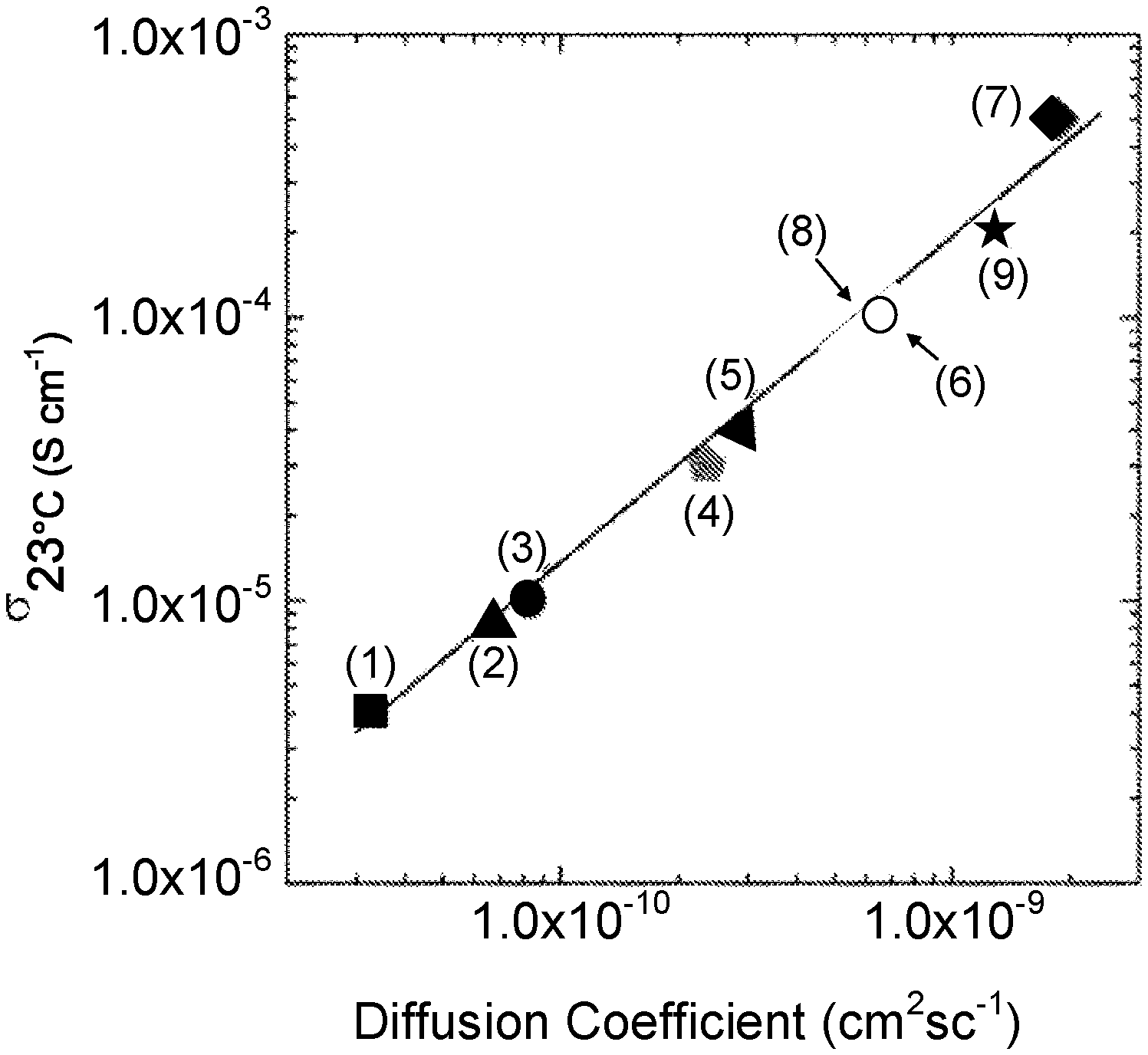
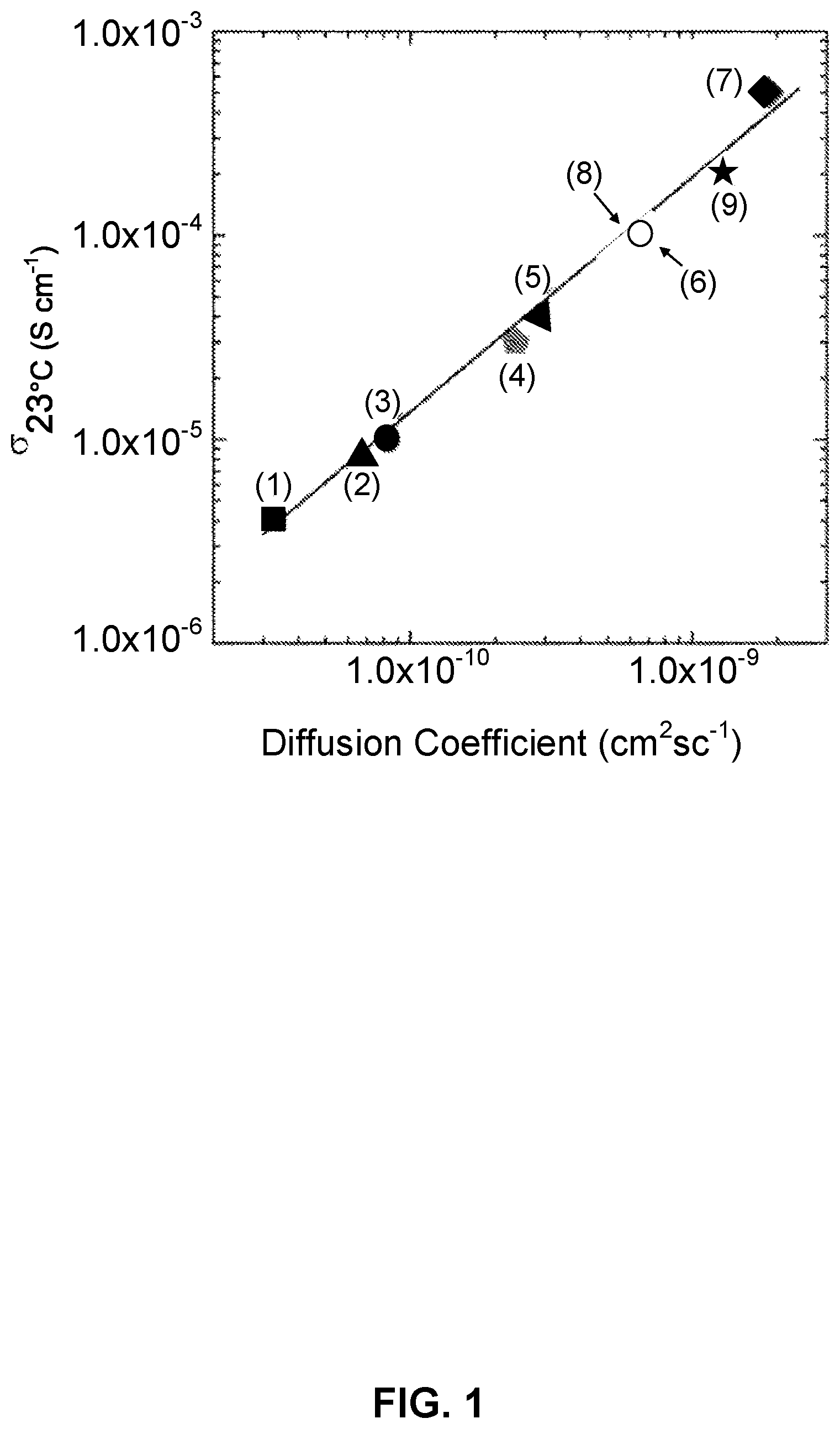
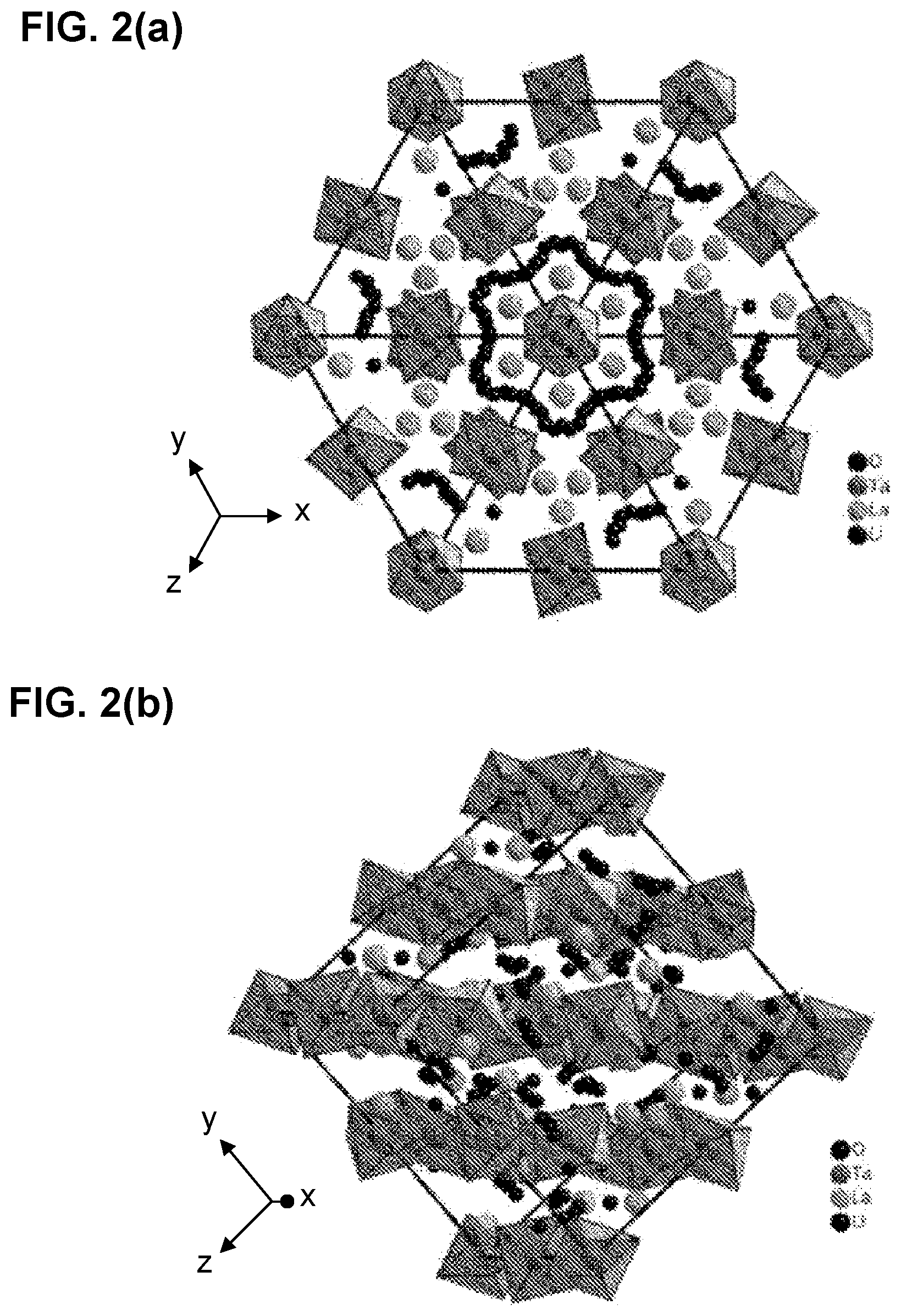
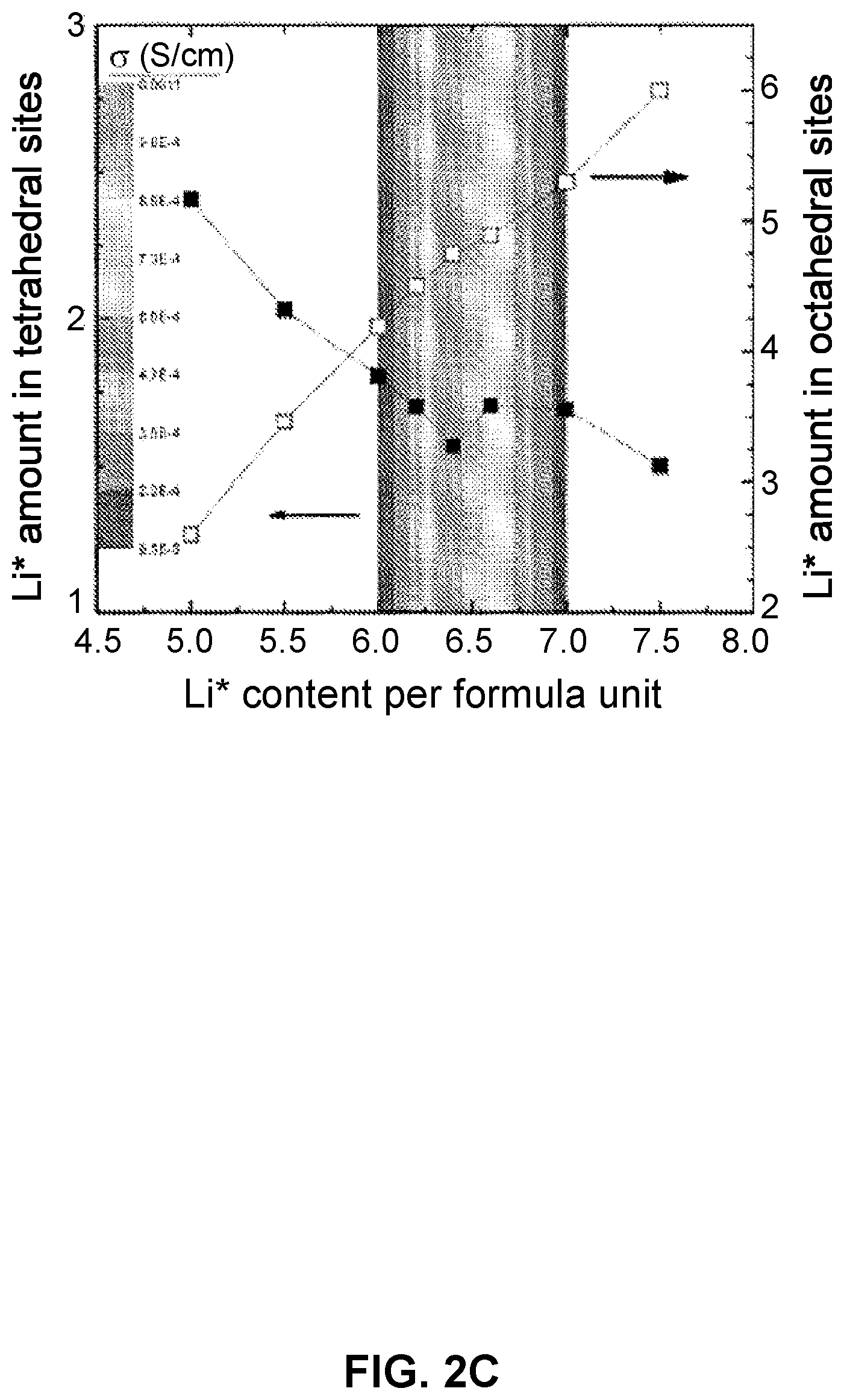
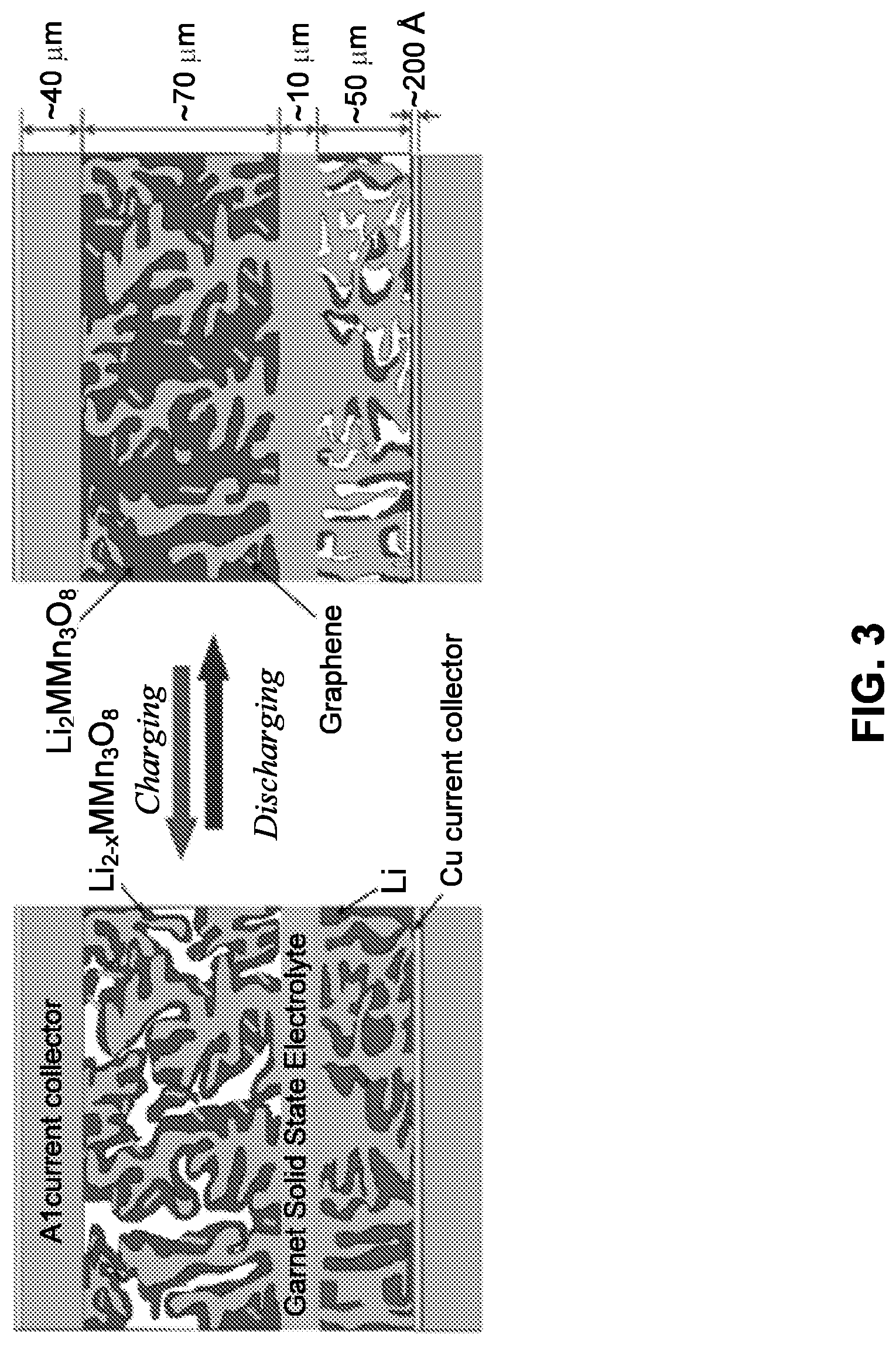
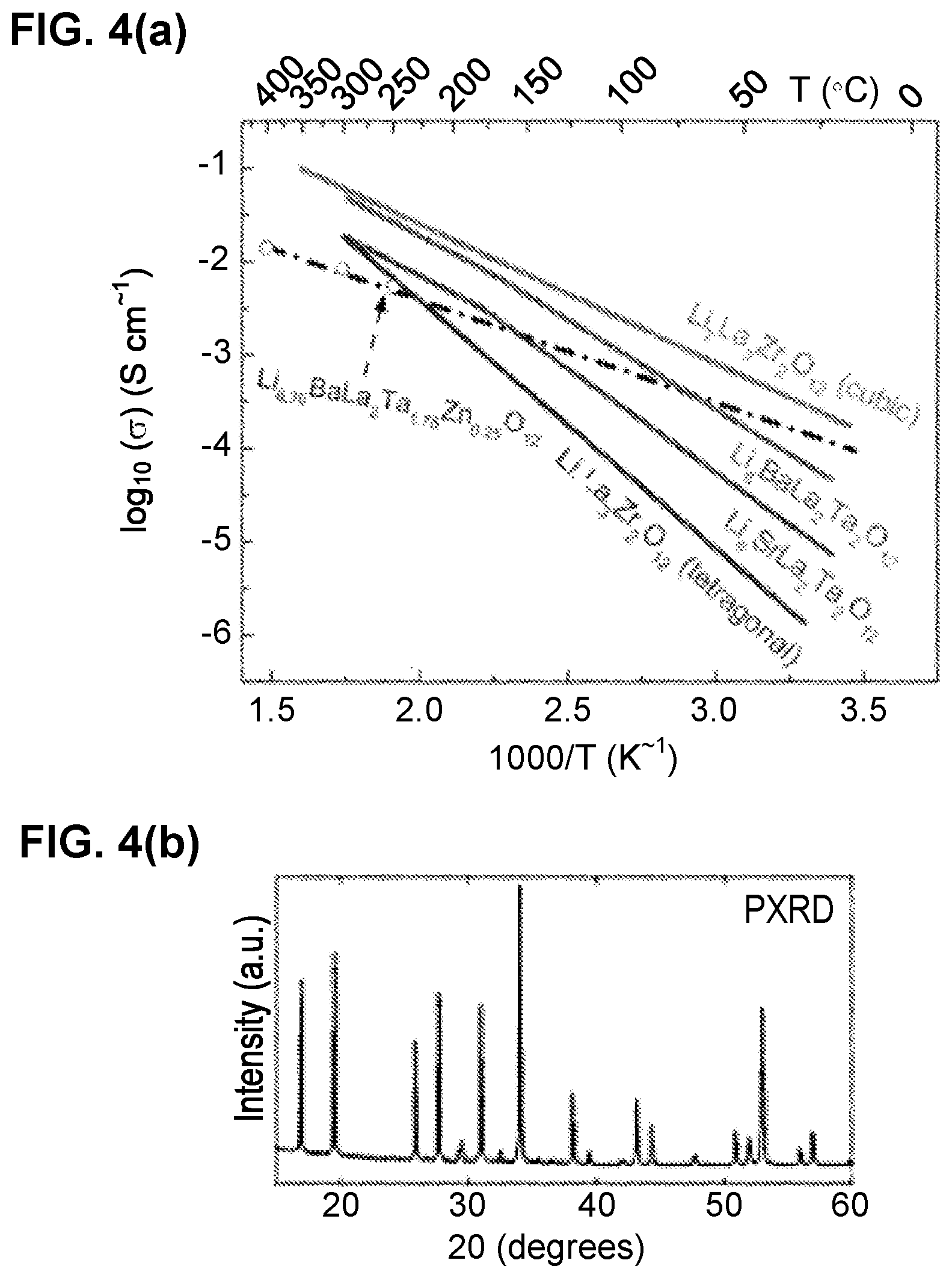
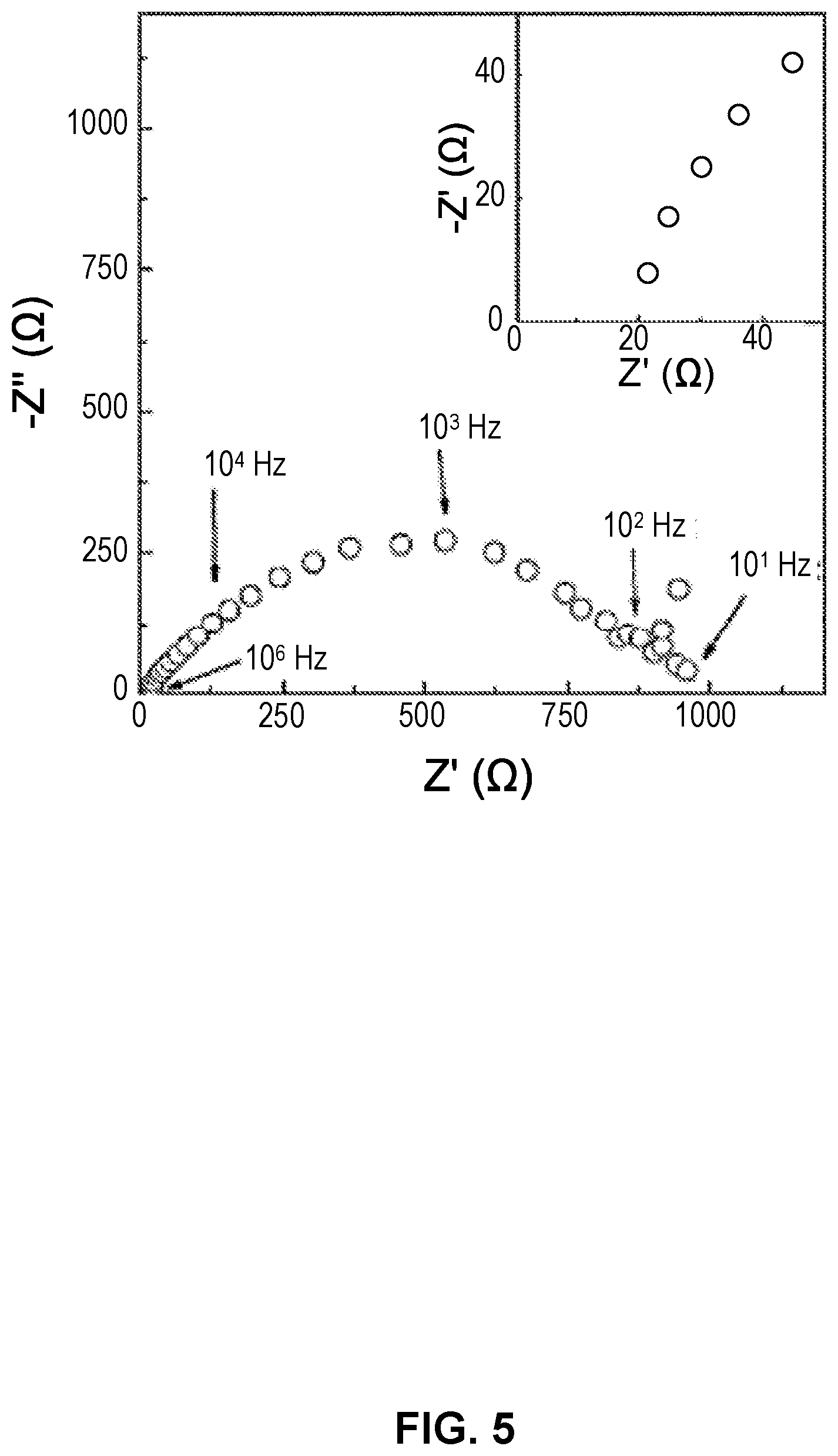
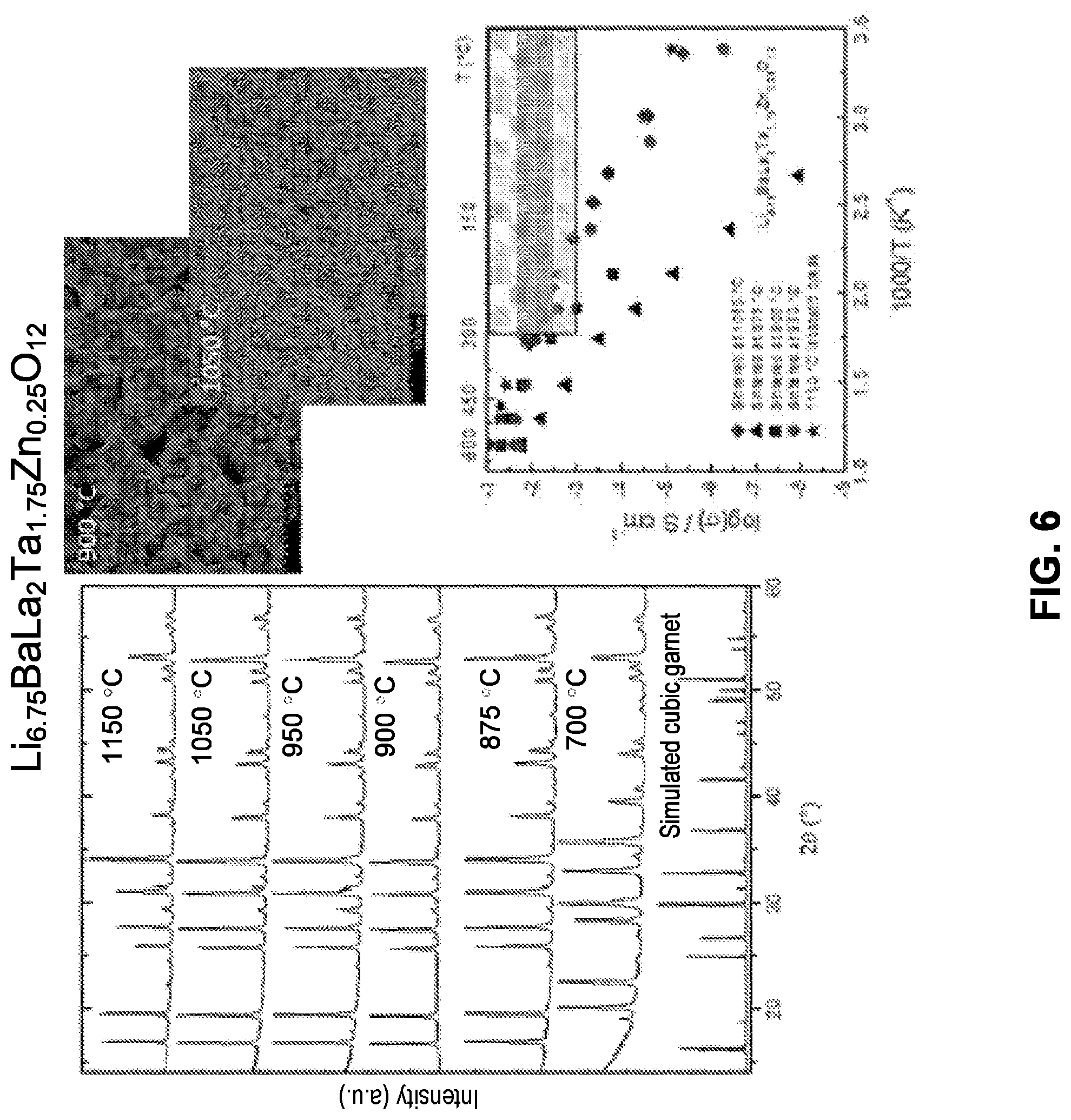


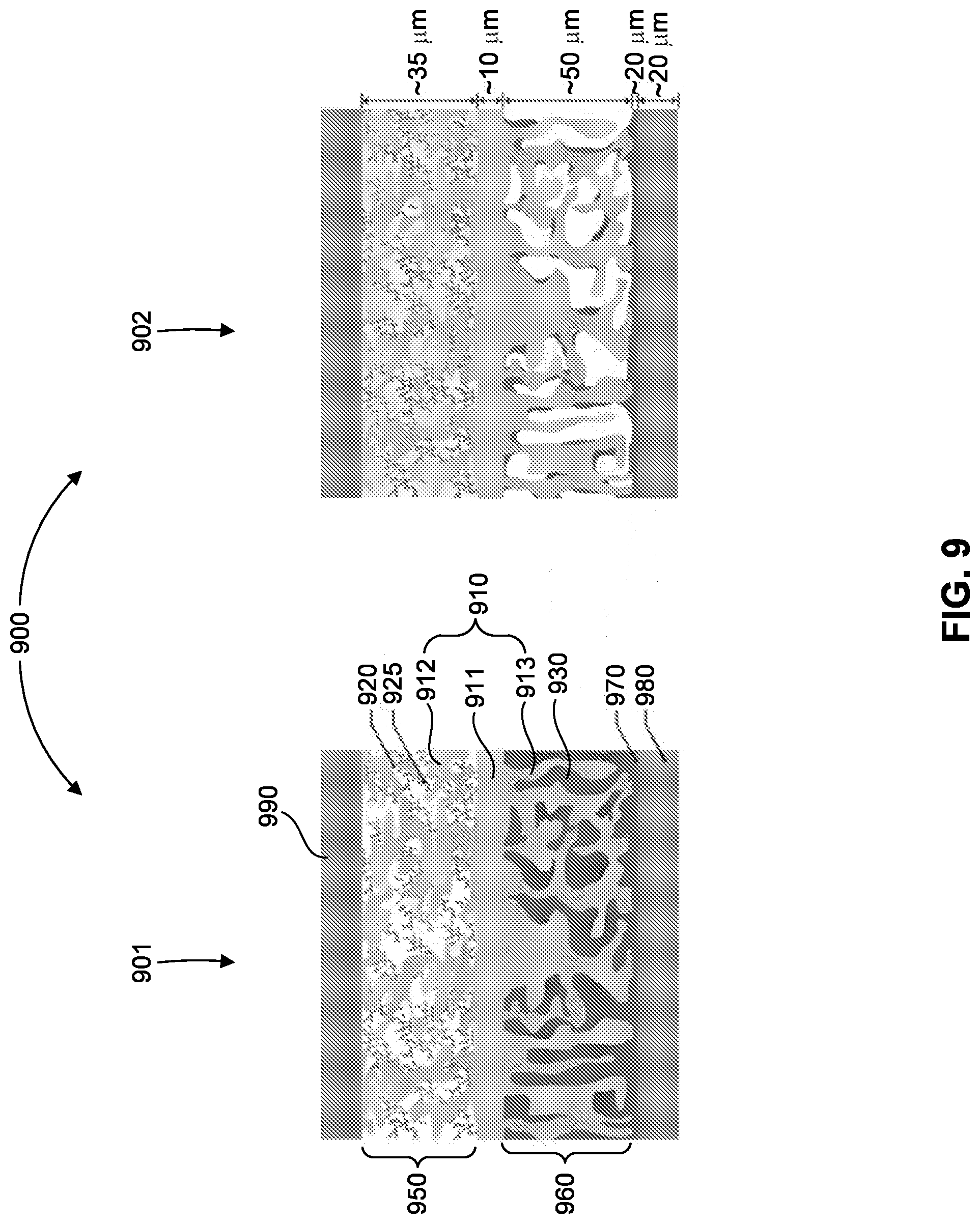

View All Diagrams
| United States Patent Application | 20200075960 |
| Kind Code | A1 |
| WACHSMAN; Eric D. ; et al. | March 5, 2020 |
Solid-State Li-S Batteries and Methods of Making Same
Abstract
Disclosed is a method of fabricating a battery or battery component having a solid state electrolyte. A scaffold is provided, the scaffold comprising: a dense central layer comprising a dense electrolyte material, the dense central layer having a first surface, and a second surface opposite the first surface; a first porous layer comprising a first porous electrolyte material, the first porous layer disposed on the first surface of the dense central layer, the porous electrolyte material having a first network of pores therein; wherein each of the dense electrolyte material and the first porous electrolyte material are independently selected from garnet materials. Carbon is infiltrated into the first porous layer. Sulfur is also infiltrated into the first porous layer. The battery component may be used in a variety of battery configurations.
| Inventors: | WACHSMAN; Eric D.; (Fulton, MD) ; HU; Liangbing; (Hyattsville, MD) ; WANG; Chunsheng; (Silver Spring, MD) ; WEN; Yang; (Hyattsville, MD) ; FU; Kun; (College Park, MD) ; HAN; Fudong; (Greenbelt, MD) | ||||||||||
| Applicant: |
|
||||||||||
|---|---|---|---|---|---|---|---|---|---|---|---|
| Assignee: | University of Maryland, College
Park College Park MD |
||||||||||
| Family ID: | 59227394 | ||||||||||
| Appl. No.: | 15/779930 | ||||||||||
| Filed: | November 30, 2016 | ||||||||||
| PCT Filed: | November 30, 2016 | ||||||||||
| PCT NO: | PCT/US2016/064232 | ||||||||||
| 371 Date: | May 30, 2018 |
Related U.S. Patent Documents
| Application Number | Filing Date | Patent Number | ||
|---|---|---|---|---|
| 62260955 | Nov 30, 2015 | |||
| Current U.S. Class: | 1/1 |
| Current CPC Class: | H01M 4/382 20130101; H01M 4/8621 20130101; H01M 4/663 20130101; H01M 10/0562 20130101; H01M 4/38 20130101; H01M 10/052 20130101; H01M 2004/021 20130101; H01M 2300/0071 20130101; H01M 2/162 20130101; H01M 4/13 20130101 |
| International Class: | H01M 4/86 20060101 H01M004/86; H01M 4/13 20060101 H01M004/13; H01M 4/66 20060101 H01M004/66; H01M 2/16 20060101 H01M002/16 |
Goverment Interests
STATEMENT REGARDING FEDERALLY-SPONSORED RESEARCH OR DEVELOPMENT
[0004] The invention was made with government support under NNC14CA27C awarded by NASA. The government has certain rights in the invention.
Claims
1. A battery, comprising: a dense central layer comprising a dense electrolyte material, the dense central layer having a first surface, and a second surface opposite the first surface; a first electrode disposed on the first surface of the dense central layer, the first electrode comprising: a first porous electrolyte material having a first network of pores therein; a cathode material infiltrated throughout the first network of pores, the cathode material comprising sulfur, wherein each of the first porous electrolyte material and the cathode material percolate through the first electrode; a second electrode disposed on the second surface of the dense central layer, the second electrode comprising: a second porous electrolyte material having a second network of pores therein; an anode material infiltrated throughout the second network of pores, the anode material comprising lithium, wherein each of the second porous electrolyte material and the anode material percolate through the second electrode; wherein each of the dense electrolyte material, the first porous electrolyte material, and the second porous electrolyte material are independently selected from garnet materials wherein the cathode material comprising sulfur is selected from S, Li.sub.2S, and combinations thereof.
2. The battery of claim 1, wherein each of the dense electrolyte material, the first porous electrolyte material, and the second porous electrolyte material are the same.
3. The battery of claim 1, wherein each of the dense electrolyte material, the first porous electrolyte material, and the second porous electrolyte material are different.
4. The battery of claim 1, wherein the dense central layer has a thickness of 1 to 30 microns, the first electrode has a thickness of 10 to 200 microns, and the second electrode has a thickness of 10 to 200 microns.
5. The battery of claim 1, wherein each of the dense electrolyte material, the first porous electrolyte material, and the second porous electrolyte material are independently selected from cation-doped Li.sub.5La.sub.3M.sup.1.sub.2O.sub.12, where M.sup.1 is Nb, Zr, Ta, or combinations thereof, cation-doped Li.sub.6La.sub.2BaTa.sub.2O.sub.12, cation-doped Li.sub.7La.sub.3Zr.sub.2O.sub.12, and cation-doped Li.sub.6BaY.sub.2M.sup.1.sub.2O.sub.12, where cation dopants are barium, yttrium, zinc, iron, gallium, and combinations thereof.
6. The battery of claim 1, wherein each of the dense electrolyte material, the first porous electrolyte material, and the second porous electrolyte material are independently selected from Li.sub.5LaNb.sub.2O.sub.12, Li.sub.5La.sub.3Ta.sub.2O.sub.12, Li.sub.7La.sub.3Zr.sub.2O.sub.12, Li.sub.6La.sub.2SiNb.sub.2O.sub.12, Li.sub.6La.sub.2BaNb.sub.2O.sub.12, Li.sub.6La.sub.2SrTa.sub.2O.sub.12, Li.sub.6La.sub.2BaTa.sub.2O.sub.12, Li.sub.7Y.sub.3Zr.sub.2O.sub.12, Li.sub.6.4Y.sup.3Z.sub.1.4Ta.sub.0.6O.sub.12, Li.sub.6.5La.sub.2.5Ba.sub.0.5TaZrO.sub.12, Li.sub.6BaY.sub.2M.sup.1.sub.2O.sub.12, Li.sub.7Y.sub.3Zr.sub.2O.sub.12, Li.sub.6.75BaLa.sub.2Nb.sub.1.75Zn.sub.0.25O.sub.12, or Li.sub.6.75BaLa.sub.2Ta.sub.1.75Zn.sub.0.25O.sub.12, and combinations thereof.
7. The battery of claim 1, wherein the anode material is Li metal.
8. The battery of claim 1, wherein the cathode material is S.
9. The battery of claim 1, wherein the cathode material is selected from the group consisting of: S, Li.sub.2S, Li.sub.2S .sub.2, Li.sub.2S.sub.3, Li.sub.2S.sub.4, Li.sub.7S.sub.6, and Li.sub.7S.sub.8, and combinations thereof.
10. The battery of claim 1, wherein the cathode further comprises a conductive material comprising carbon.
11. The battery of claim 10, wherein the conductive material is selected from the group consisting of conductive polymers, carbon nanotubes, and carbon fibers.
12. The battery of claim 10, wherein the anode material and the conductive material comprising carbon together fill 40 to 60 percent of the volume of pores in the a first porous electrolyte.
13. The battery of claim 10, wherein the anode material has a density of 0.4 to 0.6 mg/cm.sup.2 in the first electrode, and the conductive material comprising carbon has a density of 0.4 to 0.6 mg/cm.sup.2 in the first electrode.
14. A method of fabricating a battery or a battery component having a solid state electrolyte, the method comprising: providing a scaffold comprising: a dense central layer comprising a dense electrolyte material, the dense central layer having a first surface, and a second surface opposite the first surface; a first porous layer comprising a first porous electrolyte material, the first porous layer disposed on the first surface of the dense central layer, the first porous electrolyte material having a first network of pores therein; wherein each of the dense electrolyte material and the first porous electrolyte material are independently selected from garnet materials; infiltrating carbon into the first porous layer; infiltrating sulfur into the first porous layer.
15. The method of claim 14, wherein infiltrating sulfur into the first porous layer is performed after infiltrating carbon into the first porous layer.
16. The method of claim 15, wherein infiltrating carbon into the first porous layer comprises exposing the first porous layer to carbon nanotubes in solution.
17. The method of claim 15, wherein infiltrating carbon into the first porous layer comprises exposing the first porous layer to graphene flakes in solution.
18. The method of claim 15, wherein infiltrating carbon into the first porous layer comprises: exposing the first porous layer to a solution of polyacrylonitrile in dimethylformamide, and subsequently carbonizing the polyacrylonitrile by exposure to heat.
19. The method of claim 18, wherein the polyacrylonitrile is carbonized by exposure to a temperature of a temperature of 500 to 700.degree. C. for a time period in the range 30 minutes to 3 hours.
20. The method of claim 18, wherein carbon nanofibers are grown inside the first porous layer by microwave synthesis.
21. The method of claim 15, wherein infiltrating sulfur into the first porous layer is performed by vapor deposition.
22. The method of claim 21, wherein infiltrating sulfur into the first porous layer is performed by exposure to gaseous sulfur.
23. The method of claim 22, wherein infiltrating sulfur into the first porous layer is performed by exposure to gaseous sulfur in an inert atmosphere or vacuum for a time period of 30 minutes to 6 hours.
24. The method of claim 23, wherein infiltrating sulfur into the first porous layer is performed by exposure to gaseous sulfur in an inert atmosphere or vacuum for a time period of 30 minutes to 6 hours at a temperature of 225 to 700.degree. C.
25. The method of claim 24, wherein exposing the first porous layer to gaseous sulfur during infiltrating sulfur into the first porous layer comprises exposing the first porous layer to gaseous sulfur in an argon atmosphere at a temperature of 200 to 300.degree. C. for a time period in the range 30 minutes to 2 hours.
26. The method of claim 15, wherein infiltrating sulfur into the first porous layer is performed by contacting the first porous layer with a sulfur-containing liquid.
27. The method of claim 26, wherein infiltrating sulfur into the first porous layer comprises exposing the first porous layer to a solution of S dissolved in CS.sub.2.
28. The method of claim 27, further comprising, after exposing the first porous layer to a solution of S dissolved in CS.sub.2, evaporating the CS.sub.2 by vacuum drying.
29. The method of claim 14, wherein, after infiltrating carbon into the first porous layer and infiltrating sulfur into the first porous layer, the anode material and the conductive material comprising carbon together fill 40 to 60 percent of the volume of pores in the a first porous electrolyte.
30. The method of claim 14, wherein, after infiltrating carbon into the first porous layer and infiltrating sulfur into the first porous layer, the anode material has a density of 0.4 to 0.6 mg/cm.sup.2 in the first electrode, and the conductive material comprising carbon has a density of 0.4 to 0.6 mg/cm.sup.2 in the first electrode.
31. The method of claim 14, wherein: the scaffold further comprises a second porous layer comprising a second porous electrolyte material, the second porous layer disposed on the second surface of the dense central layer, the second porous electrolyte material having a second network of pores therein; the method further comprises infiltrating lithium into the second porous layer.
32. The method of claim 14, wherein the sulfur infiltrated into the first porous layer is S, Li.sub.2S, and combinations thereof.
Description
CROSS-REFERENCE TO RELATED APPLICATIONS
[0001] The following documents are incorporated by reference in their entirety:
[0002] U.S. Appl. 62/260,955, filed on Nov. 30, 2015.
[0003] U.S. Pub. No. US 2014/0287305, filed on Mar. 21, 2014.
FIELD OF THE DISCLOSURE
[0005] This disclosure relates to batteries with solid state electrolytes. More particularly, the disclosure relates to solid state batteries having a unique solid state electrolyte and combinations of materials, and methods of making such batteries.
BACKGROUND OF THE DISCLOSURE
[0006] Lithium ion batteries (LiBs) have the highest volumetric and gravimetric energy densities compared to all other rechargeable batteries making LiBs the prime candidate for a wide range of applications, from portable electronics to electric vehicles (EVs). Current LiBs are based mainly on LiCoO.sub.2 or LiFePO.sub.4 type positive electrodes, a Li.sup.+ conducting organic electrolyte (e.g., LiPF.sub.6 dissolved in ethylene carbonate-diethyl carbonate), and a Li metal or graphitic anode. Unfortunately, there are several technological problems that exist with current state-of-the art LiBs: safety due to combustible organic components; degradation due to the formation of reaction products at the anode and cathode electrolyte, interfaces (solid electrolyte interphase--SEI); and power/energy density limitations by poor electrochemical stability of the organic electrolyte. Other batteries based sodium, magnesium, and other ion conducting electrolytes have similar issues.
[0007] Sulfur is a promising cathode for lithium batteries due to its high theoretical specific capacity (1673 mAh/g), low cost and environmental friendliness. With a high theoretical specific energy density of 2500 Wh/kg that is 10 times greater energy density than conventional Li-ion battery, Li--S battery hold great potential for next-generation high energy storage system. However, wide-scale commercial use is so far limited because of some key challenges, such as the dissolution of the intermediate discharge product (Li.sub.2Sx, 2<X<8) in conventional liquid electrolytes, remained unsolved. On the other hand, all-solid-state batteries (SSB) are considered to be ultimate power supply for pure electric vehicles (EVs). SSB system demonstrates a new approach for novel Li--S battery. Replacing the organic electrolyte with solid state electrolyte (SSEs) will intrinsically eliminate the dissolution of polysulfide. However, all of the solid state Li--S batteries incorporating current state-of-the-art SSEs suffer from high interfacial impedance due to their low surface area.
SUMMARY
[0008] Provided is a solid-state, ion-conducting battery comprising: (a) cathode material or anode material; (b) a solid-state electrolyte (SSE) material comprising a porous region having a plurality of pores, and a dense region, where the cathode material or the anode material is disposed on at least a portion of the porous region and the dense region is free of the cathode material and the anode material, and a current collector disposed on at least a portion of the cathode material or the anode material.
[0009] In one embodiment, the SSE material comprises two porous regions, the battery comprises a cathode material and an anode material, wherein the cathode material is disposed on at least a portion of one of the porous regions forming a cathode-side porous region and the anode material is disposed on at least a portion of the other porous region forming an anode-side porous region, and the cathode-side region and the anode-side region are disposed on opposite sides of the dense region, and wherein the battery further comprises a cathode-side current collector and an anode-side current collector.
[0010] In one embodiment, the cathode material is a lithium-containing material, a sodium-containing cathode material, or a magnesium-containing cathode material. In another embodiment, the cathode material comprises a conducting carbon material, and the cathode material, optionally, further comprises an organic or gel ion-conducting electrolyte. In another embodiment, the lithium-containing electrode material is a lithium-containing, ion-conducting cathode material selected from LiCoO.sub.2, LiFePO.sub.4, Li.sub.2MMn.sub.3O.sub.8, wherein M is selected from Fe, Co, and combinations thereof. In another embodiment, the sodium-containing cathode material is a sodium-containing, ion-conducting cathode material selected from Na.sub.2V.sub.2O.sub.5, P2-Na.sub.2/3Fe.sub.1/2Mn.sub.1/2O.sub.2, Na.sub.3V.sub.2(PO.sub.4).sub.3, NaMn.sub.1/3CO.sub.1/3Ni.sub.1/3PO.sub.4, and Na.sub.2/3Fe.sub.1/2Mn.sub.1/2O.sub.2 graphene composite. In another embodiment, the magnesium-containing cathode material is a magnesium-containing, ion-conducting cathode material. In another embodiment, the magnesium-containing cathode material is a doped manganese oxide.
[0011] In one embodiment, the anode material is a lithium-containing anode material, a sodium-containing anode material, or a magnesium-containing anode material. In another embodiment, the lithium-containing anode material is lithium metal. In another embodiment, the sodium-containing anode material is sodium metal or an ion-conducting, sodium-containing anode material selected from Na.sub.2C.sub.8H.sub.4O.sub.4 and Na.sub.0.66Li.sub.0.22Ti.sub.0.78O.sub.2. In an embodiment, the magnesium-containing anode material is magnesium metal.
[0012] In one embodiment, the SSE material is a lithium-containing SSE material, a sodium-containing SSE material, or a magnesium-containing SSE material. In another embodiment, the lithium-containing SSE material is a Li-garnet SSE material. In another embodiment, the Li-garnet SSE material is cation-doped Li.sub.5La.sub.3M.sup.1.sub.2O.sub.12, where M.sup.1 is Nb, Zr, Ta, or combinations thereof, cation-doped Li.sub.6La.sub.2BaTa.sub.2O.sub.12, cation-doped Li.sub.7La.sub.3Zr.sub.2O.sub.12, and cation-doped Li.sub.6BaY.sub.2M.sup.1.sub.2O.sub.12, where cation dopants are barium, yttrium, zinc, iron, gallium or combinations thereof. In an embodiment, the Li-garnet SSE material is Li.sub.5La.sub.3Nb.sub.2O.sub.12, Li.sub.5La.sub.3Ta.sub.2O.sub.12, Li.sub.7La.sub.3Zr.sub.2O.sub.12, Li.sub.6La.sub.2SrNb.sub.2O.sub.12, Li.sub.6La.sub.2BaNb.sub.2O.sub.12, Li.sub.6La.sub.2SrTa.sub.2O.sub.12, Li.sub.6La.sub.2BaTa.sub.2O.sub.12, Li.sub.7Y.sub.3Zr.sub.2O.sub.12, Li.sub.6.4Y.sub.3Zr.sub.1.4Ta.sub.0.6O.sub.12, Li.sub.6.5La.sub.2.5Ba.sub.0.5TaZrO.sub.12, Li.sub.6BaY.sub.2M.sup.1.sub.2O.sub.12, Li.sub.7Y.sub.3Zr.sub.2O.sub.12, Li.sub.6.75BaLa.sub.2Nb.sub.1.75Zn.sub.0.25O.sub.12, or Li.sub.6.75BaLa.sub.2Ta.sub.1.75Zn.sub.0.25O.sub.12.
[0013] In one embodiment, the current collector is a conducting metal or metal alloy.
[0014] In one embodiment, the dense region of the SSE material has a thickness of 1 .mu.m to 100 .mu.m. In another embodiment, the porous region of the SSE material that has the cathode material disposed thereon has a thickness of 20 .mu.m to 200 .mu.m. In another embodiment, the porous region of the SSE material that has the anode material disposed thereon has a thickness of 20 .mu.m to 200 .mu.m.
[0015] In one embodiment, the ion-conducting cathode material, the ion-conducting anode material, the SSE material, the current collector form a cell, and the solid-state, ion-conducting battery comprises a plurality of the cells, each adjacent pair of the cells is separated by a plate. In one embodiment, the plate is a bipolar plate.
[0016] Also provided is a solid-state, ion-conducting battery comprising a solid-state electrolyte (SSE) material comprising a porous region of electrolyte material disposed on a dense region of electrolyte material, the SSE material configured such that ions diffuse into and out of the porous region of the SSE material during charging and/or discharging of the battery. In one embodiment, the SSE material comprises two porous regions disposed on opposite sides of the dense region of the SSE material.
[0017] In some embodiments, the battery comprises a dense central layer. The dense central layer comprises a dense electrolyte material, and has a first surface and a second surface opposite the first surface. A first electrode is disposed on the first surface of the dense central layer. The first electrode comprises a first porous electrolyte material having a first network of pores therein, and a cathode material infiltrated throughout the first network of pores. The cathode material comprises sulfur. Each of the first porous electrolyte material and the cathode material infiltrate the first electrode. A second electrode is disposed on the second surface of the dense central layer. The second electrode comprises a second porous electrolyte material having a second network of pores therein, and an anode material infiltrated throughout the second network of pores. The anode material comprises lithium. Each of the second porous electrolyte material and the anode material infiltrate the second electrode. Each of the dense electrolyte material, the first porous electrolyte material, and the second porous electrolyte material are independently selected from garnet materials.
[0018] In some embodiments, in addition to the features described in any combination of the preceding paragraphs, each of the dense electrolyte material, the first porous electrolyte material, and the second porous electrolyte material are the same.
[0019] In some embodiments, in addition to the features described in any combination of the preceding paragraphs, each of the dense electrolyte material, the first porous electrolyte material, and the second porous electrolyte material are different.
[0020] In some embodiments, in addition to the features described in any combination of the preceding paragraphs, the dense central layer has a thickness of 1 to 30 microns, the first electrode has a thickness of 10 to 200 microns, and the second electrode has a thickness of 10 to 200 microns.
[0021] In some embodiments, in addition to the features described in any combination of the preceding paragraphs, each of the dense electrolyte material, the first porous electrolyte material, and the second porous electrolyte material are independently selected from canon-doped Li.sub.5La.sub.3M.sup.1.sub.2O.sub.12, where M.sup.1 is Nb, Zr, Ta, or combinations thereof, cation-doped Li.sub.6La.sub.2BaTa.sub.2O.sub.12, cation-doped Li.sub.7La.sub.3Zr.sub.2O.sub.12, and cation-doped Li.sub.6BaY.sub.2M.sup.1.sub.2O.sub.12, where cation dopants are barium, yttrium, zinc, iron, gallium and combinations thereof.
[0022] In some embodiments, in addition to the features described in any combination of the preceding paragraphs, each of the dense electrolyte material, the first porous electrolyte material, and the second porous electrolyte material are independently selected from Li.sub.5La.sub.3Nb.sub.2O.sub.12, Li.sub.5La.sub.3Ta.sub.2O.sub.12, Li.sub.7La.sub.3Zr.sub.2O.sub.12, Li.sub.6La.sub.2SrNb.sub.2O.sub.12, Li.sub.6La.sub.2BaNb.sub.2O.sub.12, Li.sub.6La.sub.2SrTa.sub.2O.sub.12, Li.sub.6La.sub.2BaTa.sub.2O.sub.12, Li.sub.7Y.sub.3Zr.sub.2O.sub.12, Li.sub.6.4Y.sub.3Z.sub.1.4Ta.sub.0.6O.sub.12, Li.sub.6.5La.sub.2.5Ba.sub.0.5TaZrO.sub.12, Li.sub.6BaY.sub.2M.sup.1.sub.2O.sub.12, Li.sub.7Y.sub.3Zr.sub.2O.sub.12, Li.sub.6.75BaLa.sub.2Nb.sub.1.75Zn.sub.0.25O.sub.12, or Li.sub.6.75BaLa.sub.2Ta.sub.1.75Zn.sub.0.25O.sub.12, and combinations thereof.
[0023] In some embodiments, the anode material is lithium metal.
[0024] In some embodiments, in addition to the features described in any combination of the preceding paragraphs, the cathode material is selected from the group consisting of: S and Li--S compounds (Li.sub.2S.sub.2 Li.sub.2S.sub.2, Li.sub.2S.sub.3, Li.sub.2S.sub.4, Li.sub.2S.sub.6, Li.sub.2S.sub.8), and combinations thereof. In some embodiments, the cathode material is S. In some embodiments, the cathode material is selected from the group consisting of: Li.sub.2S, Li.sub.2S.sub.2, Li.sub.2S.sub.3, Li.sub.2S.sub.4, Li.sub.2S.sub.6, and Li.sub.2S.sub.8, and combinations thereof.
[0025] In some embodiments, in addition to the features described in any combination of the preceding paragraphs, the cathode further comprises a conductive material comprising carbon.
[0026] In some embodiments, in addition to the features described in any combination of the preceding paragraphs, the conductive material is selected from the group consisting of conductive polymers, carbon nanotubes, and carbon fibers.
[0027] In some embodiments, in addition to the features described in any combination of the preceding paragraphs, the anode material and the conductive material comprising carbon together fill 40 to 60 percent of the volume of pores in the a first porous electrolyte.
[0028] In some embodiments, in addition to the features described in any combination of the preceding paragraphs, the anode material has a density of 0.4 to 0.6 mg/cm.sup.2 in the first electrode, and the conductive material comprising carbon has a density of 0.4 to 0.6 mg/cm.sup.2 in the first electrode.
[0029] In some embodiments, in addition to the features described in any combination of the preceding paragraphs, a method of fabricating a battery having a solid state electrolyte is provided. A scaffold is provided, the scaffold comprising: a dense central layer comprising a dense electrolyte material, the dense central layer having a first surface, and a second surface opposite the first surface; a first porous layer comprising a first porous electrolyte material, the first porous layer disposed on the first surface of the dense central layer, the first porous electrolyte material having a first network of pores therein; wherein each of the dense electrolyte material and the first porous electrolyte material are independently selected from garnet materials. Carbon is infiltrated into the first porous layer. Sulfur is also infiltrated into the first porous layer.
[0030] In some embodiments, in addition to the features described in any combination of the preceding paragraphs, infiltrating sulfur into the first porous layer is performed after infiltrating carbon into the first porous layer.
[0031] In some embodiments, in addition to the features described in any combination of the preceding paragraphs, infiltrating carbon into the first porous layer comprises exposing the first porous layer to carbon nanotubes in suspension or solution.
[0032] In some embodiments, in addition to the features described in any combination of the preceding paragraphs, infiltrating carbon into the first porous layer comprises exposing the first porous layer to graphene flakes in suspension or solution.
[0033] In some embodiments, in addition to the features described in any combination of the preceding paragraphs, infiltrating carbon into the first porous layer comprises: exposing the first porous layer to a solution of polyacrylonitrile in dimethylformamide, and subsequently carbonizing the polyacrylonitrile by exposure to heat.
[0034] In some embodiments, in addition to the features described in any combination of the preceding paragraphs, the polyacrylonitrile is carbonized by exposure to a temperature of a temperature of 500 to 700.degree. C. for a time period in the range 30 minutes to 3 hours.
[0035] In some embodiments, in addition to the features described in any combination of the preceding paragraphs, carbon nanofibers are grown inside the first porous layer by microwave synthesis.
[0036] In some embodiments, in addition to the features described in any combination of the preceding paragraphs, infiltrating sulfur into the first porous layer is performed by a vapor deposition.
[0037] In some embodiments, in addition to the features described in any combination of the preceding paragraphs, infiltrating sulfur into the first porous layer is performed by exposure to gaseous sulfur.
[0038] In some embodiments, in addition to the features described in any combination of the preceding paragraphs, infiltrating sulfur into the first porous layer is performed by exposure to gaseous sulfur in an inert atmosphere or vacuum for a time period of 30 minutes to 6 hours.
[0039] In some embodiments, in addition to the features described in any combination of the preceding paragraphs, infiltrating sulfur into the first porous layer is performed by exposure to gaseous sulfur in an inert atmosphere or vacuum for a time period of 30 minutes to 6 hours at a temperature of 225 to 700.degree. C.
[0040] In some embodiments, in addition to the features described in any combination of the preceding paragraphs, exposing the first porous layer to gaseous sulfur during infiltrating sulfur into the first porous layer comprises exposing the first porous layer to gaseous sulfur in an argon atmosphere at a temperature of 200 to 300.degree. C. for a time period in the range 30 minutes to 2 hours.
[0041] In some embodiments, in addition to the features described in any combination of the preceding paragraphs, infiltrating sulfur into the first porous layer is performed by contacting the first porous layer with a sulfur-containing liquid.
[0042] In some embodiments, in addition to the features described in any combination of the preceding paragraphs, infiltrating sulfur into the first porous layer comprises contacting the first porous layer to a solution of S dissolved in CS.sub.2.
[0043] In some embodiments, in addition to the features described in any combination of the preceding paragraphs, the method further comprises, after contacting the first porous layer to a solution of S dissolved in CS.sub.2, evaporating the CS.sub.2 by vacuum drying.
[0044] In some embodiments, in addition to the features described in any combination of the preceding paragraphs, after infiltrating carbon into the first porous layer and infiltrating sulfur into the first porous layer, the anode material and the conductive material comprising carbon together fill 40 to 60 percent of the volume of pores in the a first porous electrolyte.
[0045] In some embodiments, in addition to the features described in any combination of the preceding paragraphs, after infiltrating carbon into the first porous layer and infiltrating sulfur into the first porous layer, the anode material has a density of 0.4 to 0.6 mg/cm.sup.2 in the first electrode, and the conductive material comprising carbon has a density of 0.4 to 0.6 mg/cm.sup.2 in the first electrode.
[0046] In some embodiments, in addition to the features described in any combination of the preceding paragraphs, the scaffold further comprises a second porous layer comprising a second porous electrolyte material, the second porous layer disposed on the second surface of the dense central layer, the second porous electrolyte material having a second network of pores therein. And, the method further comprises infiltrating lithium into the second porous layer.
[0047] In some embodiments, in addition to the features described in any combination of the preceding paragraphs, the sulfur infiltrated into the first porous layer is S, Li.sub.2S, and combinations thereof.
DESCRIPTION OF THE DRAWINGS
[0048] The following figures are given by way of illustration only, and thus are not intended to limit the scope of the present disclosure.
[0049] FIG. 1 is a graph showing ionic conductivity vs. diffusion coefficient of garnet-type compounds: (1) Li.sub.5La.sub.3Ta.sub.2O.sub.12, (2) Li.sub.5La.sub.3Sb.sub.2O.sub.12, (3) Li.sub.5La.sub.3Nb.sub.2O.sub.12, (4) Li.sub.5.5BaLa.sub.2Ta.sub.2O.sub.11.75, (5) Li.sub.6La.sub.2BaTaO.sub.12, (6) Li.sub.6.5BaLa.sub.2Ta.sub.2O.sub.12.25, (7) Li.sub.7La.sub.3Zr.sub.2O.sub.12, (8) Li.sub.6.5La.sub.2.5Ba.sub.0.5TaZrO.sub.12 (sintered at 900.degree. C.), and (9) Li.sub.6.5La.sub.2.5Ba.sub.0.5TaZrO.sub.12 (sintered at 1100.degree. C.).
[0050] FIGS. 2(a)-2(c)depict garnet-type solid-state electrolytes (SSEs) with optimized Li ion conduction: FIG. 2(a) and FIG. 2(b) path of Li.sup.+ conduction and FIG. 2(c) effect of Li.sup.+ site occupancy on conductivity.
[0051] FIG. 3 is a schematic of an example of the solid-state lithium battery (SSLiB) showing thin (.about.10 .mu.m) garnet SSE layer extending as a tailored nano/microstructured scaffold into (Li metal filled) anode and (Li.sub.2MMn.sub.3O.sub.8, M=Fe, Co, mixed with graphene) cathode to provide structural support for solid-state electrolyte (SSE) layer, and high surface area and continuous ion transport path for reduced polarization. The multi-purpose .about.40 .mu.m Al current collector (with .about.200 .ANG. Cu on anode side) provides strength and thermal and electrical conduction. The .about.170 .mu.m repeat units are stacked in series to provide desired battery pack voltage and strength (300V pack would be <1 cm thick). Highly porous SSE scaffold creates large interface area significantly decreasing cell impedance.
[0052] FIG. 4(a) depicts a graph showing ionic conductivity of examples of Li-garnets. FIG. 4(b) depicts a PXRD showing an example of a Li.sub.6.75La.sub.2BaTa.sub.1.75Zn.sub.0.25O.sub.12.
[0053] FIG. 5. depicts an electrochemical impedance spectroscopy (EIS) of an example of a SSE battery with LiFePO.sub.4 cathode (20% carbon black), dense SSE, Li infiltrated SSE scaffold, and Al current collector. The absence of additional low-frequency intercept indicates electrolyte interface is reversible for Li ions.
[0054] FIG. 6 depicts a PXRD showing the formation of a garnet-type Li.sub.6.75La.sub.2BaTa.sub.1.75Zn.sub.0.25O.sub.12 as a function of temperature, SEM images and conductivity show sintering temperature can control the density, particle size, and conductivity.
[0055] FIGS. 7(a)-(c) depict examples of multilayer ceramic processing: FIG. 7(a) tape cast support; FIG. 7(b) thin electrolyte on layered porous anode support with bimodally integrated anode functional layer (BI-AFL); and FIG. 7(c) magnification of BI-AFL showing ability to integrate nano-scale features for reduced interfacial impedance with conventional ceramic processing.
[0056] FIGS. 8(a)-8(d) depict micrograph of SSE scaffold: FIG. 8(a) Cross section and FIG. 8(b) top view of an example of a SSE with porous scaffold, in which anode and cathode materials will be filled. FIG. 8(c) Cross-section of SSE scaffold after Li metal infiltration. FIG. 8(d) Cross section at Li-metal-dense SSE interface. Images demonstrate excellent Li wetting of SSE was obtained.
[0057] FIG. 9 shows a schematic of solid state batteries showing thin garnet SSE layer extending as a tailored nano/micro-structured scaffold into (Li metal filled) anode and sulfur cathode to provide structural support for solid state electrolyte layer, and high surface area and continuous ion transport path for reduced polarization. A highly porous SSE scaffold creates large interface area significantly decreasing cell impedance.
[0058] FIG. 10(a) shows a cross-section SEM image of Li-infiltrated porous garnet.
[0059] FIG. 10(b) shows an elemental mapping of S/C co-infiltration.
[0060] FIG. 10(c) shows a schematic of a cell assembly for electrochemical testing.
[0061] FIG. 11(a) shows a graph of cycling performance for a trilayer SSE enabled Li--S battery under a constant current density of 1 mA/mg.
[0062] FIG. 11(b) shows a graph of extended cycling stability for the Li-S battery of FIG. 11(a).
[0063] FIG. 12 shows a schematic of a solid state battery with a thin (10 .mu.m) garnet SSE layer extending as a tailored nano/micro-structured scaffold into Li.sub.metal filled anode and sulfur filled cathode to provide structural support for SSE layer, and high surface area and continuous ion transport path for reduced polarization. A multi-purpose 10 .mu.m Ti current collector provides strength and thermal and electrical conduction. The highly porous SSE scaffold creates large interface area significantly decreasing cell impedance.
[0064] FIG. 13 shows Arrhenius conductivity plots for Li.sub.6.4La.sub.3Zr.sub.1.4T.sub.0.6-xNb.sub.xO.sub.12 (0<=x<=0.3), Li.sub.6.65La.sub.2.75Ba.sub.0.25Zr.sub.1.4Ta.sub.0.5Nb.sub.0.1O.sub.12, and undoped Li.sub.7La.sub.3Zr.sub.2O.sub.12 (LLZ).
[0065] FIG. 14(a) shows a photograph of a large garnet tape. The inserted image shows the flexibility of the tape.
[0066] FIG. 14(b) shows a laminated tri-layer tape.
[0067] FIG. 14(c) shows a sintered trilayer pellet.
[0068] FIG. 14(d) shows an SEM image of a sintered tri-layer showing a dense central SSE layer and porous outer layers.
[0069] FIG. 15(a) shows schematics of symmetric cells with and without a 1 nm ALD-AL.sub.2O.sub.3 coating on LLCZN.
[0070] FIG. 15(b) shows Nyquist electrochemical impedence spectroscopy (EIS) plots for the cells of FIG. 15(a). The inset in FIG. 15(b) shows the magnified EIS at high frequency.
[0071] FIG. 15(c) shows a plot illustrating galvanostatic cycling with a current density of 71 .mu.A/cm.sup.2.
[0072] FIG. 16(a) shows SEM images of a triple-layer garnet structure with Li.sub.metal filling (and wetting) the pores, after 360 cycles at a current density of 3 mA/cm.sup.2.
[0073] FIG. 16(b) shows a plot of measurements taken during galvanostatic cycling of the structure of FIG. 16(a) at current densities of 1, 2, and 3 mA/cm.sup.2, demonstrating stable voltage response corresponding to an ASR of .about.2.OMEGA. cm .sup.2 independent of current density and without Li dendrite formation.
[0074] FIG. 17(a) shows a SEM image of carbon and sulfur infiltrated triple-layer garnet.
[0075] FIG. 17(b) shows element mapping of the structure of FIG. 17(a).
[0076] FIG. 17(c) shows Raman spectroscopy results for the structure of FIG. 17(a).
[0077] FIG. 17(d) shows an XRD pattern for the structure of FIG. 17(a).
[0078] FIG. 18(a) is a photograph showing a working Li--S cell with a garnet electrolyte that lights up a LED device.
[0079] FIG. 18(b) shows the voltage-capacity profile of the Li--S cell of FIG. 18(a).
[0080] FIG. 19(a) shows the structure of a 28 V stack having 14 cells in series with titanium bipolar layers between cells.
[0081] FIG. 19(b) shows an assembly of stack layers of FIG. 19(a) in a pile.
[0082] FIG. 19(c) shows a fully assembled pile.
[0083] FIG. 19(d) shows a 100 kg device consisting of 9 piles.
[0084] FIG. 20(a) shows a SEM of a carbon nanotube sponge.
[0085] FIG. 20(b) shows a first picture of a compressible carbon nanotube (CNT) sponge.
[0086] FIG. 20(c) shows a second picture of a compressible carbon nanotube (CNT) sponge.
[0087] FIG. 21(a) is a schematic of 10 cm.times.10 cm Li--S cell with tri-layer Garnet.
[0088] FIG. 21(b) is a picture of a 10 cm.times.10 cm solid oxide fuel cell (SOFC) fabricated by the inventors.
[0089] FIG. 22 is a schematic showing a packaging design for stacked cells in series.
[0090] FIG. 23(a) is a picture of a dilatometer.
[0091] FIG. 23(b) shows carbon nanotube (CNT) growth on metal plate.
[0092] FIGS. 24 (a)-(d) shows measured results on the stability window of garnet electrolyte and stability of C/S cathodes.
[0093] FIG. 25(a) is a picture of Garnet electrolyte sintered at 1050.degree. C. and its dense microstructure.
[0094] FIG. 25(b) is a first SEM of a dense layer of the electrolyte of FIG. 25(a).
[0095] FIG. 25(c) is a second SEM of a dense layer of the electrolyte of FIG. 25(a).
[0096] FIG. 26(a) shows XRD patterns of LLCZN.
[0097] FIG. 26(b) is a graph showing impedance measured from room temperature to 50.degree. C. for LLCZN.
[0098] FIG. 26(c) is a graph showing lithium ion conductivity as function of temperature for LLCZN.
[0099] FIG. 27(a) is a picture of a large Garnet tape fabricated by tape casting.
[0100] FIG. 27(b) is an SEM image of highly porous Garnet.
[0101] FIG. 28(a) shows an SEM image of conformal CNT coating on a porous Garnet surface.
[0102] FIG. 28(b) is an SEM image of CNF grown by microwave method.
[0103] FIG. 29(a) is a first SEM image of sulfur infusion in a nanocarbon coated Garnet electrolyte.
[0104] FIG. 29(b) is a second SEM image of sulfur infusion in a nanocarbon coated Garnet electrolyte.
[0105] FIG. 29(c) is an XRD measurement after infilling S in Garnet electrolyte, which confirms there is no reactions between S and Garnet.
[0106] FIG. 30(a) is an SEM image of lithium-infiltrated lithium garnet scaffold showing metallic lithium (dark) conformally coating the porous garnet scaffold (light).
[0107] FIG. 30(b) is a cross section at Li-metal-dense SSE interface. The images show that excellent Li wetting of the SSE was obtained.
[0108] FIG. 31 shows a plot of current vs. voltage for a Garnet electrolyte with a configuration of Gold.parallel.Garnet.parallel.Lithium, which shows Li is stable up to 5.5 V.
[0109] FIG. 32(a) is an SEM image of sulfur and carbon co-infiltrated into the cathode porous side of a triple-layer garnet electrolyte.
[0110] FIG. 32(b) shows element mapping of sulfur in the structure of FIG. 32(a).
[0111] FIG. 32(c) shows element mapping of zirconium in the structure of FIG. 32(a).
[0112] FIG. 32(d) shows an overlap of S and C mapping of cathode materials with Zrfor the structure of FIG. 32(a).
[0113] FIG. 33(a) is a graph showing cell performance of a lithium-sulfur garnet electrolyte battery. The 3rd, 4th, 5th and 10th charge-discharge curves of the cell are shown.
[0114] FIG. 33(b) is a graph showing the specific capacity and coulombic efficiency with cycle number dependence for the cell of FIG. 33(a).
[0115] FIG. 34(a) is a plot of electrochemical impedance spectroscopy (EIS) for a Li.parallel.triple-layer garnet.parallel.Li electrode cell at room temperature. The equivalent circuit fitting result is shown as a solid line in FIG. 34(a). But, the line overlaps the measured data so closely that it may not be easily visible.
[0116] FIG. 34(b) is a plot of electrochemical impedance spectroscopy (EIS) for a Li.parallel.triple-layer garnet.parallel.S cell at room temperature. The equivalent circuit fitting result is shown as a solid line in FIG. 34(b). But, the line overlaps the measured data so closely that it may not be easily visible, except at higher values on the X-axis where the equivalent circuit fitting result line deviates and becomes visible.
[0117] FIG. 35(a) is a graph showing cycling stability for the first 27 cycles of a battery cell. The cell was cycled between 1V-3V at constant current of 10 uA in total.
[0118] FIG. 35(b) is a graph showing a charge-discharge curve for the 26th cycle and discharge curve for the 27th cycle.
[0119] FIG. 36 is a graph showing pre-charge-discharge curves for a battery cell. The total testing current was 50 uA for the 1st discharge and 2nd charge, and 10 uA for the 2nd discharge.
DETAILED DESCRIPTION OF THE DISCLOSURE
[0120] The present disclosure provides ion conducting batteries having a solid state electrolyte (SSE). For example, the batteries are lithium-ion, solid-state electrolyte batteries, sodium-ion, solid-state electrolyte batteries, or magnesium-ion solid-state electrolyte batteries. Lithium-ion (Li.sup.+) batteries are used, for example, in portable electronics and electric cars, sodium-ion (Na.sup.+) batteries are used, for example, for electric grid storage to enable intermittent renewable energy deployment such as solar and wind, and magnesium-ion (Mg.sup.2+) batteries are expected to have higher performance than Li.sup.+ and Na.sup.+ because Mg.sup.2+ carries twice the charge for each ion.
[0121] The solid-state batteries have advantages over previous batteries. For example, the solid electrolyte is non-flammable providing enhanced safety, and also provides greater stability to allow high voltage electrodes for greater energy density. The battery design (FIG. 3) provides additional advantages in that it allows for a thin electrolyte layer and a larger electrolyte/electrode interfacial area, both resulting in lower resistance and thus greater power and energy density. In addition, the structure eliminates mechanical stress from ion intercalation during charging and discharging cycles and the formation of solid electrolyte interphase (SEI) layers, thus removing the capacity fade degradation mechanisms that limit lifetime of current battery technology.
[0122] The solid state batteries comprise a cathode material, an anode material, and an ion-conducting, solid-state electrolyte material. The solid-state electrolyte material has a dense region (e.g. a layer) and one or two porous regions (layers). The porous region(s) can be disposed on one side of the dense region or disposed on opposite sides of the dense region. The dense region and porous region(s) are fabricated from the same solid-state electrolyte material. The batteries conduct ions such as, for example, lithium ions, sodium ions, or magnesium ions.
[0123] The cathode comprises cathode material in electrical contact with the porous region of the ion-conducting, solid-state electrolyte material. For example, the cathode material is an ion-conducting material that stores ions by mechanisms such as intercalation or reacts with the ion to form a secondary phase (e.g., an air or sulfide electrode). Examples of suitable cathode materials are known in the art.
[0124] The cathode material is disposed on at least a portion of a surface (e.g., a pore surface of one of the pores) of a porous region of the ion-conducting, solid-state electrolyte material. The cathode material, when present, at least partially fills one or more pores (e.g., a majority of the pores) of a porous region or one of the porous regions of the ion-conducting, solid-state electrolyte material. In one embodiment, the cathode material is infiltrated into at least a portion of the pores of the porous region of the ion-conducting, solid-state electrolyte material.
[0125] In an embodiment, the cathode material is disposed on at least a portion of the pore surface of the cathode side of the porous region of the ion-conducting, SSE material, where the cathode side of the porous region of ion-conducting, SSE material is opposed to an anode side of the porous region of ion-conducting, SSE material on which the anode material is disposed.
[0126] In an embodiment, the cathode material is a lithium ion-conducting material. For example, the lithium ion-conducting cathode material is, lithium nickel manganese cobalt oxides (NMC, LiNi.sub.xMn.sub.yCo.sub.zO.sub.2, where x+y+z=1), such as LiCoO.sub.2, LiNi.sub.1/3Co.sub.1/3Mn.sub.1/3O.sub.2, LiNi.sub.0.5Co.sub.0.2Mn.sub.0.3O.sub.2, lithium manganese oxides (LMOs), such as LiMn.sub.2O.sub.4, LiNi.sub.0.5Mn.sub.1.5O.sub.4, lithium iron phosphates (LFPs) such as LiFePO.sub.4, LiMnPO.sub.4, and LiCoPO.sub.4, and Li.sub.2MMn.sub.3O.sub.8, where M is selected from Fe, Co, and combinations thereof. In an embodiment, the ion-conducting cathode material is a high energy ion-conducting cathode material such as Li.sub.2MMn.sub.3O.sub.8, wherein M is selected from Fe, Co, and combinations thereof.
[0127] In an embodiment, the cathode material is a sodium ion-conducting material. For example, the sodium ion-conducting cathode material is Na.sub.2V.sub.2O.sub.5, P2-Na.sub.2/3Fe.sub.1/2Mn.sub.1/2O.sub.2, Na.sub.3V.sub.2(PO.sub.4).sub.3, NaMn.sub.1/3Co.sub.1/3Ni.sub.1/3PO.sub.4 and composite materials (e.g., composites with carbon black) thereof such as Na.sub.2/3Fe.sub.1/2Mn.sub.1/2O.sub.2 graphene composite.
[0128] In an embodiment, the cathode material is a magnesium ion-conducting material. For example, the magnesium ion-conducting cathode material is doped manganese oxide (e.g., Mg.sub.xMnO.sub.2..sub.yH.sub.2O).
[0129] In an embodiment, the cathode material is an organic sulfide or polysulfide. Examples of organic sulfides include carbynepolysulfide and copolymerized sulfur.
[0130] In an embodiment, the cathode material is an air electrode. Examples of materials suitable for air electrodes include those used in solid-state lithium ion batteries with air cathodes such as large surface area carbon particles (e.g., Super P which is a conductive carbon black) and catalyst particles (e.g., alpha-MnO.sub.2 nanorods) bound in a mesh (e.g., a polymer binder such as PVDF binder).
[0131] It may be desirable to use an electrically conductive material as part of the ion-conducting cathode material. In one embodiment, the ion-conducting cathode material also comprises an electrically conducting carbon material (e.g., graphene or carbon black), and the ion-conducting cathode material, optionally, further comprises a organic or gel ion-conducting electrolyte. The electrically conductive material may separate from the ion-conducting cathode material. For example, electrically conductive material (e.g., graphene) is disposed on at least a portion of a surface (e.g., a pore surface) of the porous region of the ion-conducting, SSE electrolyte material and the ion-conducting cathode material is disposed on at least a portion of the electrically conductive material (e.g., graphene).
[0132] The anode comprises anode material in electrical contact with the porous region of the ion-conducting, SSE material. For example, the anode material is the metallic form of the ion conducted in the solid state electrolyte (e.g., metallic lithium for a lithium-ion battery) or a compound that intercalates the conducting ion (e.g., lithium carbide, Li.sub.6C, for a lithium-ion battery). Examples of suitable anode materials are known in the art.
[0133] The anode material is disposed on at least a portion of a surface (e.g., a pore surface of one of the pores) of the porous region of the ion-conducting, SSE material. The anode material, when present, at least partially fills one or more pores (e.g., a majority of the pores) of the porous region of ion-conducting, SSE electrolyte material. In an embodiment, the anode material is infiltrated into at least a portion of the pores of the porous region of the ion-conducting, solid-state electrolyte material.
[0134] In one embodiment, the anode material is disposed on at least a portion of the pore surface of an anode-side porous region of the ion-conducting, SSE electrolyte material, where the anode side of the ion-conducting, solid-state electrolyte material is opposed to a cathode side of the porous, ion-conducting, SSE on which the cathode material is disposed.
[0135] In one embodiment, the anode material is a lithium-containing material. For example, the anode material is lithium metal, or an ion-conducting lithium-containing anode material such as lithium titanates (LTOs) such as Li.sub.4Ti.sub.5O.sub.12.
[0136] In one embodiment, the anode material is a sodium-containing material. For example, the anode material is sodium metal, or an ion-conducting sodium-containing anode material such as Na.sub.2C.sub.8H.sub.4O.sub.4 and Na.sub.0.66Li.sub.0.22Ti.sub.0.78O.sub.2.
[0137] In one embodiment, the anode material is a magnesium-containing material. For example, the anode material is magnesium metal.
[0138] In one embodiment, the anode material is a conducting material such as graphite, hard carbon, porous hollow carbon spheres and tubes, and tin and its alloys, tin/carbon, tin/cobalt alloy, or silicon/carbon.
[0139] The ion-conducting, solid-state electrolyte material has a dense regions (e.g., a dense layer) and one or two porous regions (e.g., porous layer(s)). The porosity of the dense region is less than that of the porous region(s). In one embodiment, the dense region is not porous. The cathode material and/or anode material is disposed on a porous region of the SSE material forming a discrete cathode material containing region and/or a discrete anode material containing region of the ion-conducting, solid-state electrolyte material. For example, each of these regions of the ion-conducting, solid-state electrolyte material has, independently, a thickness (e.g., a thickness perpendicular to the longest dimension of the material) of 20 .mu.m to 200 .mu.m, including all integer micron values and ranges there between.
[0140] The dense regions and porous regions described herein can be discrete dense layers and discrete porous layers. Accordingly, in an embodiment, the ion-conducting, solid-state electrolyte material has a dense layer and one or two porous layers.
[0141] The ion-conducting, solid-state electrolyte material conducts ions (e.g., lithium ions, sodium ions, or magnesium ions) between the anode and cathode. The ion-conducting, solid-state electrolyte material is free of pin-hole defects. The ion-conducting solid-state electrolyte material for the battery or battery cell has a dense region (e.g., a dense layer) that is supported by one or more porous regions (e.g., porous layer(s)) (the porous region(s)/layer(s) are also referred to herein as a scaffold structure(s)) comprised of the same ion-conducting, solid-state electrolyte material.
[0142] In an embodiment, the ion-conducting solid state electrolyte has a dense region (e.g., a dense layer) and two porous regions (e.g., porous layers), where the porous regions are disposed on opposite sides of the dense region and cathode material is disposed in one of the porous regions and the anode material in the other porous region.
[0143] The porous region (e.g., porous layer) of the ion-conducting, solid-state electrolyte material has a porous structure. The porous structure has microstructural features (e.g., microporosity) and/or nanostructural features (e.g., nanoporosity). For example, each porous region, independently, has a porosity of 10% to 90%, including all integer % values and ranges there between. In another example, each porous region, independently, has a porosity of 30% to 70%, including all integer % values and ranges therebetween. Where two porous regions are present the porosity of the two layers may be the same or different. The porosity of the individual regions can be selected to, for example, accommodate processing steps (e.g., higher porosity is easier to fill with electrode material (e.g., charge storage material) (e.g., cathode)) in subsequent screen-printing or infiltration step, and achieve a desired electrode material capacity, i.e., how much of the conducting material (e.g., Li, Na, Mg) is stored in the electrode materials. The porous region (e.g., layer) provide structural support to the dense layer so that the thickness of the dense layer can be reduced, thus reducing its resistance. The porous layer also extends ion conduction of the dense phase (solid electrolyte) into the electrode layer to reduce electrode resistance both in terms of ion conduction through electrode and interfacial resistance due to charge transfer reaction at electrode/electrolyte interface, the later improved by having more electrode/electrolyte interfacial area.
[0144] In an embodiment, the solid-state, ion-conducting electrolyte material is a solid-state electrolyte, lithium-containing material. For example, the solid-state electrolyte, lithium-containing material is a lithium-garnet SSE material.
[0145] In an embodiment, the solid-state, ion-conducting electrolyte material is a Li-garnet SSE material comprising cation-doped Li.sub.5La.sub.3M'.sub.2O.sub.12, cation-doped Li.sub.6La.sub.2BaTa.sub.2O.sub.12, cation-doped Li.sub.7La.sub.3Zr.sub.2O.sub.12, and cation-doped Li.sub.6BaY.sub.2M'.sub.2O.sub.12. The cation dopants are barium, yttrium, zinc, iron, gallium, or combinations thereof and M' is Nb, Zr, Ta, or combinations thereof.
[0146] In an embodiment, the Li-garnet SSE material comprises Li.sub.5La.sub.3Nb.sub.2O.sub.12, Li.sub.5La.sub.3Ta.sub.2O.sub.12, Li.sub.7La.sub.3Zr.sub.2O.sub.12, Li.sub.6La.sub.2SrNb.sub.2O.sub.12, Li.sub.6La.sub.2BaNb.sub.2O.sub.12, Li.sub.6La.sub.2SrTa.sub.2O.sub.12, Li.sub.6La.sub.2BaTa.sub.2O.sub.12, Li.sub.7Y.sub.3Zr.sub.2O.sub.12, Li.sub.6 4Y.sub.3Zr.sub.1.4Ta.sub.0.6O.sub.12, Li.sub.6.5La.sub.2.5Ba.sub.0.5TaZrO.sub.12, Li.sub.6BaY.sub.2M.sup.1.sub.2O.sub.12, Li.sub.7Y.sub.3Zr.sub.2O.sub.12, Li.sub.6.75BaLa.sub.2Nb.sub.1.75Zn.sub.0.25O.sub.12, or Li.sub.6.75BaLa.sub.2Ta.sub.1.75Zn.sub.0.25O.sub.12.
[0147] In an embodiment, the, solid-state, ion-conducting electrolyte material sodium-containing, solid-state electrolyte, material. For example, the sodium-containing, solid-state electrolyte is Na.sub.3Zr.sub.2Si.sub.2PO.sub.12 (NASICON) or beta-alumina.
[0148] In an embodiment, the, solid-state, ion-conducting electrolyte material is a, solid-state electrolyte, magnesium-containing material. For example, the magnesium ion-conducting electrolyte material is MgZr.sub.4P.sub.6O.sub.24.
[0149] The ion-conducting, solid-state electrolyte material has a dense region that free of the cathode material and anode material. For example, this region has a thickness (e.g., a thickness perpendicular to the longest dimension of the material) of 1 .mu.m to 100 .mu.m, including all integer micron values and ranges there between. In another example, this region has a thickness of 5 .mu.m to 40 .mu.m.
[0150] In one embodiment, the solid state battery comprises a lithium-containing cathode material and/or a lithium-containing anode material, and a lithium-containing, ion-conducting, solid-state electrolyte material. In an embodiment, the solid state battery comprises a sodium-containing cathode material and/or a sodium-containing anode material, and a sodium-containing, ion-conducting, solid-state electrolyte material. In another embodiment, the solid state battery comprises a magnesium-containing cathode material and/or a magnesium-containing anode material, and a magnesium-containing, ion-conducting, solid-state electrolyte material.
[0151] The solid-state, ion-conducting electrolyte material is configured such that ions (e.g., lithium ions, sodium ions, or magnesium ions) diffuse into and out of the porous region(s) (e.g., porous layer(s)) of the solid-state, ion-conducting electrolyte material during charging and/or discharging of the battery. In one embodiment, the solid-state, ion-conducting battery comprises a solid-state, ion-conducting electrolyte material comprising one or two porous regions (e.g., porous layer(s)) configured such that ions (e.g., lithium ions, sodium ions, or magnesium ions) diffuse into and out of the porous region(s) of solid-state, ion-conducting electrolyte material during charging and/or discharging of the battery.
[0152] One of ordinary skill in the art would understand that a number of processing methods are known for processing/forming the porous, solid-state, ion-conducting electrolyte material such as high temperature solid-state reaction processes, co-precipitation processes, hydrothermal processes, sol-gel processes.
[0153] The material can be systematically synthesized by solid-state mixing techniques. For example, a mixture of starting materials may be mixed in an organic solvent (e.g., ethanol or methanol) and the mixture of starting materials dried to evolve the organic solvent. The mixture of starting materials may be ball milled. The ball milled mixture may be calcined. For example, the ball milled mixture is calcined at a temperature between 500.degree. C. and 2000.degree. C., including all integer .degree. C. values and ranges there between, for least 30 minutes to at least 50 hours. The calcined mixture may be milled with media such as stabilized-zirconia or alumina or another media known to one of ordinary skill in the art to achieve the prerequisite particle size distribution. The calcined mixture may be sintered. For example, the calcined mixture is sintered at a temperature between 500.degree. C. and 2000.degree. C., including all integer .degree. C. values and ranges therebetween, for at least 30 minutes to at least 50 hours. To achieve the prerequisite particle size distribution, the calcined mixture may be milled using a technique such as vibratory milling, attrition milling, jet milling, ball milling, or another technique known to one of ordinary skill in the art, using media such as stabilized-zirconia, alumina, or another media known to one of ordinary skill in the art.
[0154] One of ordinary skill in the art would understand that a number of conventional fabrication processing methods are known for processing the ion-conducting SSE materials such as those set forth above in a green-form. Such methods include, but are not limited to, tape casting, calendaring, embossing, punching, laser-cutting, solvent bonding, lamination, heat lamination, extrusion, co-extrusion, centrifugal casting, slip casting, gel casting, die casting, pressing, isostatic pressing, hot isostatic pressing, uniaxial pressing, and sol gel processing. The resulting green-form material may then be sintered to form the ion-conducting SSE materials using a technique known to one of ordinary skill in the art, such as conventional thermal processing in air, or controlled atmospheres to minimize loss of individual components of the ion-conducting SSE materials. In some embodiments of the present invention it is advantageous to fabricate ion-conducting SSE materials in a green-form by die-pressing, optionally followed by isostatic pressing. In other embodiments it is advantageous to fabricate ion-conducting SSE materials as a multi-channel device in a green-form using a combination of techniques such as tape casting, punching, laser-cutting, solvent bonding, heat lamination, or other techniques known to one of ordinary skill in the art.
[0155] Standard x-ray diffraction analysis techniques may be performed to identify the crystal structure and phase purity of the solid sodium electrolytes in the sintered ceramic membrane.
[0156] The solid state batteries (e.g., lithium-ion solid state electrolyte batteries, sodium-ion solid state electrolyte batteries, or magnesium-ion solid state electrolyte batteries) comprise current collector(s). The batteries have a cathode-side (first) current collector disposed on the cathode-side of the porous, solid-state electrolyte material and an anode-side (second) current collector disposed on the anode-side of the porous, solid-state electrolyte material. The current collector are each independently fabricated of a metal (e.g., aluminum, copper, or titanium) or metal alloy (aluminum alloy, copper alloy, or titanium alloy).
[0157] The solid-state batteries (e.g., lithium-ion solid state electrolyte batteries, sodium-ion solid state electrolyte batteries, or magnesium-ion solid state electrolyte batteries) may comprise various additional structural components (such as bipolar plates, external packaging, and electrical contacts/leads to connect wires. In an embodiment, the battery further comprises bipolar plates. In an embodiment, the battery further comprises bipolar plates and external packaging, and electrical contacts/leads to connect wires. In an embodiment, repeat battery cell units are separated by a bipolar plate.
[0158] The cathode material, the anode material, the SSE material, the cathode-side (first) current collector (if present), and the anode-side (second) current collector (if present) may form a cell. In this case, the solid-state, ion-conducting battery comprises a plurality of cells separated by one or more bipolar plates. The number of cells in the battery is determined by the performance requirements (e.g., voltage output) of the battery and is limited only by fabrication constraints. For example, the solid-state, ion-conducting battery comprises 1 to 500 cells, including all integer number of cells and ranges there between.
[0159] In an embodiment, the ion-conducting, solid-state battery or battery cell has one planar cathode and/or anode electrolyte interface or no planar cathode and/or anode electrolyte interfaces. In an embodiment, the battery or battery cell does not exhibit solid electrolyte interphase (SEI).
[0160] The following examples are presented to illustrate the present disclosure. They are not intended to limiting in any manner.
EXAMPLE 1
[0161] The following is an example describing the solid-state lithium ion batteries of the present disclosure and making same.
[0162] The flammable organic electrolytes of conventional batteries can be replaced with non-flammable ceramic-based solid-state electrolytes (SSEs) that exhibit, for example, room temperature ionic conductivity of .gtoreq.10.sup.-3 Scm.sup.-1 and electrochemical stability up to 6V. This can further allow replacement of typical LiCoO.sub.2 cathodes with higher voltage cathode materials to increase power/energy densities. Moreover, the integration of these ceramic electrolytes in a planar stacked structure with metal current collectors will provide battery strength.
[0163] Intrinsically safe, robust, low-cost, high-energy-density all-solid-state Li-ion batteries (SSLiBs), can be fabricated by integrating high conductivity garnet-type solid Li ion electrolytes and high voltage cathodes in tailored micro/nano-structures, fabricated by low-cost supported thin-film ceramic techniques. Such batteries can be used in electric vehicles.
[0164] Li-garnet solid-state electrolytes (SSEs) that have, for example, a room temperature (RT) conductivity of .about.10.sup.-3 Scm.sup.-1 (comparable to organic electrolytes) can be used. The conductivity can be increased to .about.10.sup.-2 Scm.sup.-1 by increasing the disorder of the Li-sublattice. The highly stable garnet SSE allows use of Li.sub.2MMn.sub.3O.sub.8 (M=Fe, Co) high voltage (.about.6V) cathodes and Li metal anodes without stability or flammability concerns.
[0165] Known fabrication techniques can be used to form electrode supported thin-film (.about.10 micron) SSEs, resulting in an area specific resistance (ASR) of only .about.0.01 .OMEGA.cm.sup.-2. Use of scaleable multilayer ceramic fabrication techniques, without need for dry rooms or vacuum equipment, provide dramatically reduced manufacturing cost.
[0166] Moreover, the tailored micro/nanostructured electrode support (scaffold) will increase interfacial area, overcoming the high impedance typical of planar geometry solid-state lithium ion batteries (SSLiBs), resulting in a C/3 IR drop of only 5.02 mV. In addition, charge/discharge of the Li-anode and Li.sub.2MMn.sub.3O.sub.8 cathode scaffolds by pore-filling provides high depth of discharge ability without mechanical cycling fatigue seen with typical electrodes.
[0167] At .about.170 micron/repeat unit, a 300V battery pack would only be <1 cm thick. This form factor with high strength due to Al bipolar plates allows synergistic placement between framing elements, reducing effective weight and volume. Based on the SSLiB rational design, targeted SSE conductivity, high voltage cathode, and high capacity electrodes the expected effective specific energy, including structural bipolar plate, is .about.600 Wh/kg at C/3. Since bipolar plates provide strength and no temperature control is necessary this is essentially a full battery pack specification other than the external can. The corresponding effective energy density is 1810 Wh/L.
[0168] All the fabrication processes can be done with conventional ceramic processing equipment in ambient air without the need of dry rooms, vacuum deposition, or glove boxes, dramatically reducing cost of manufacturing.
[0169] For the all solid-state battery with no SEI or other performance degradation mechanisms inherent in current state-of-art Li-batteries, the calendar life of the instant battery is expected to exceed 10 years and cycle life is expected to exceed 5000 cycles.
[0170] Solid-state Li-garnet electrolytes (SSEs) have unique properties for SSLiBs, including room temperature (RT) conductivity of .about.10.sup.-3 Scm.sup.-1 (comparable to organic electrolytes) and stability to high voltage (.about.6V) cathodes and Li-metal anodes without flammability concerns.
[0171] Use of SSE oxide powders can enable use of low-cost scaleable multilayer ceramic fabrication techniques to form electrode supported thin-film (.about.10 .mu.m) SSEs without need for dry rooms or vacuum equipment, as well as engineered micro/nano-structured electrode supports to dramatically increase interfacial area. The later will overcome the high interfacial impedance typical of planar geometry SSLiBs, provide high depth of discharge ability without mechanical cycling fatigue seen with typical electrodes, as well as avoid SEI layer formation.
[0172] The SSE scaffold/electrolyte/scaffold structure will also provide mechanical strength, allowing for the integration of structural metal interconnects (bipolar plates) between planar cells, to improve strength, weight, thermal uniformity, and form factor. The resulting strength and form factor provides potential for the battery pack to be load bearing.
[0173] Highly Li.sup.+ conducting and high voltage stable garnet type solid electrolytes can be made by doping specific cations for Ta and Zr in Li.sub.5La.sub.3Ta.sub.2O.sub.12, Li.sub.6La.sub.2BaTa.sub.2O.sub.12 and Li.sub.7La.sub.3Zr.sub.2O.sub.12, to extend RT conductivity from .about.10.sup.-3 to .about.10.sup.-2 Scm.sup.-1. Compositions having desirable conductivity, ionic transference number, and electrochemical stability up to 6V against elemental Li can be determined.
[0174] Electrode supported thin film SSEs can be fabricated. Submicron SSE powders and SSE ink/paste formulations thereof can be made. Tape casting, colloidal deposition, and sintering conditions can be developed to prepare dense thin-film (.about.10 .mu.m) garnet SSEs on porous scaffolds.
[0175] Cathode and anode can be integrated. Electrode-SSE interface structure and SSE surface can be optimized to minimize interfacial impedance for targeted electrode compositions. High voltage cathode inks can be made to fabricate SSLiBs with high voltage cathode and Li-metal anode incorporated into the SSE scaffold. The SSLiB electrochemical performance can be determined by measurements including CV, energy/power density and cycling performance.
[0176] Stacked multi-cell SSLiBs with Al/Cu bipolar plates can be assembled. Energy/power density, cycle life, and mechanical strength as a function of layer thicknesses and area for the stacked multi-cell SSLiBs can be determined.
[0177] Li-Stuffed Garnets SSEs. Conductivity of Li-Garnet SSEs can be improved doping to increase the Li content ("stuffing") of the garnet structure. Li-stuffed garnets exhibit desirable physical and chemical properties for SSEs including: [0178] RT bulk conductivity (.about.10.sup.-3 S/cm) for cubic Li.sub.7La.sub.3Zr.sub.2O.sub.12. [0179] High electrochemical stability for high voltage cathodes (up to 6 V), about 2 V higher than current organic electrolytes and about 1 V higher than the more popular LiPON. [0180] Excellent chemical stability in contact with elemental and molten Li anodes up to 400.degree. C. [0181] Li.sup.+ transference number close to the maximum of 1.00, which is important to battery cycle efficiency, while typical polymer electrolytes are only .about.0.35. [0182] Wide operating temperature capability, electrical conductivity that increases with increasing temperature reaching 0.1 Scm.sup.-1 at 300.degree. C., and maintains appreciable conductivity below 0.degree. C. In contrast, polymer electrolytes are flammable at high temperature [0183] Synthesizable as simple mixed oxide powders in air, hence easy scale up for bulk synthesis.
[0184] Li.sup.+ conductivity of garnet SSEs can be further increased. The Li ion conductivity of garnet is highly correlated to the concentration of Li.sup.+ in the crystal structure. FIG. 1 shows the relationship between the Li.sup.+ conductivity and diffusion coefficient for various Li-stuffed garnets. The conductivity increases with Li content, for example, the cubic Li.sub.7-phase (Li.sub.7La.sub.3Zr.sub.2O.sub.12) exhibits a RT conductivity of 5.times.10.sup.-4 S/cm. However, conductivity also depends on synthesis conditions, including sintering temperature. The effects of composition and synthesis method can be determined to achieve a minimum RT conductivity of .about.10.sup.-3 S/cm for the scaffold supported SSE layer. It is expected the RT conductivity can be increased to .about.10.sup.-2 S/cm through doping to increase the disorder of the Li sublattice. Ionic conduction in the garnet structure occurs around the metal-oxygen octahedron, and site occupancy of Li ions in tetrahedral vs. octahedral sites directly controls the Li ion conductivity (FIG. 2(a)-(c)). For example, in Li.sub.5La.sub.3Ta.sub.2O.sub.12, about 80% of Li ions occupy the tetrahedral sites while only 20% occupy octahedral sites. Increasing the Li.sup.+ concentration at octahedral sites while decreasing occupancy of the tetrahedral sides has been shown to result in an order of magnitude increase in ionic conductivity (FIG. 2(b)). Smaller-radii metal ions (e.g., Y3+), which are chemically stable in contact with elemental Li and isovalent with La, can be doped to develop a new series of garnets: Li.sub.6BaY.sub.2M.sub.2O.sub.12, Li.sub.6.4Y.sub.3Zr.sub.1.6Ta.sub.0.6O.sub.12, Li.sub.7Y.sub.3Zr.sub.2O.sub.12, and their solid solutions; to increase ionic conductivity. The enthalpy of formation of Y.sub.2O.sub.3 (-1932 kJ/mol) is lower than that of La.sub.2O.sub.3 (-1794 kJ/mol), hence, doping Y for La will increase Y--O bond strength and weaken Li--O bonds. Thus increasing Li.sup.+ mobility due to weaker lithium to oxygen interaction energy. Further, it is expected that Y will provide a smoother path for ionic conduction around the metal oxygen octahedral due to its smaller ionic radius (FIG. 2a).
[0185] In another approach, we can substitute M.sup.2+ cations (e.g., Zn.sup.2+, a 3d.degree. cation known to form distorted metal-oxygen octandera) for the M.sup.5+ sites in Li.sub.6BaY.sub.2M.sub.2O.sub.12. ZnO is expected to play a dual role of both further increasing the concentration of mobile Li ions in the structure and decreasing the final sintering temperature. Each M.sup.2+ will add three more Li.sup.+ for charge balance and these ions will occupy vacant Li.sup.- sites in the garnet structure. Thus, further increase Li.sup.+ conduction can be obtained by modifying the garnet composition to control the crystal structure, Li-site occupancy, and minimize the conduction path activation energy.
[0186] Due to the ceramic powder nature of Li-garnets, SSLiBs can be fabricated using conventional fabrication techniques. This has tremendous advantages in terms of both cost and performance. All the fabrication processes can be done with conventional ceramic processing equipment in ambient air without the need of dry rooms, vacuum deposition, or glove boxes, dramatically reducing cost of manufacturing.
[0187] The SSLiBs investigated to date suffer from high interfacial impedance due to their low surface area, planar electrode/electrolyte interfaces (e.g., LiPON based SSLiBs). Low area specific resistance (ASR) cathodes and anodes can be achieved by integration of electronic and ionic conducting phases to increase electrolyte/electrode interfacial area and extend the electrochemically active region farther from the electrolyte/electrode planar interface. It is expected that modification of the nano/microstructure of the electrolyte/electrode interface (for example, by colloidal deposition of powders or salt solution impregnation) can reduce overall cell area specific resistance (ASR), resulting in an increase in power density relative to identical composition and layer thickness cells. These same advances can be applied to decrease SSLiB interfacial impedance. The SSLiB will be made by known fabrication techniques Low-cost, high-speed, scaleable multi-layer ceramic processing can be used to fabricate supported thin-film (.about.10 .mu.m) SSEs on tailored nano/micro-structured electrode scaffolds. .about.50 and 70 .mu.m tailored porosity (nano/micro features) SSE garnet support layers (scaffolds) can be tape cast, followed by colloidal deposition of a .about.10 .mu.m dense garnet SSE layer and sintering. The resulting pinhole-free SSE layer is expected to be mechanically robust due to support layers and have a low area specific resistance ASR, for example, only 0.01 .OMEGA.cm.sup.-2. Li.sub.2MMn.sub.3O.sub.8 will be screen printed into the porous cathode scaffold and initial Li-metal will be impregnated in the porous anode scaffold (FIG. 3). For example, Li.sub.2(Co,Fe)Mn.sub.3O.sub.8 high voltage cathodes can be prepared in the form of nano-sized powders using wet chemical methods. The nano-sized electrode powders can be mixed with conductive materials such as graphene or carbon black and polymer binder in NMP solvent. Typical mass ratio for cathode, conductive additive or binder is 85%:10%:5% by weight. The slurry viscosity can be optimized for filling the porous SSE scaffold, infiltrated in and dried. An Li-metal flashing of Li nanoparticles may be infiltrated in the porous anode scaffold or the Li can be provided fully from the cathode composition so dry room processing can be avoided.
[0188] Another major advantage of this structure is that charge/discharge cycles will involve filling/emptying of the SSE scaffold pores (see FIG. 3), rather than intercalating and expanding carbon anode powders/fibers. As a result there will be no change in electrode dimensions between charged and discharged state. This is expected to remove both cycle fatigue and limitations on depth of discharge, the former allowing for greater cycle life and the later for greater actual battery capacity.
[0189] Moreover, there will be no change in overall cell dimensions allowing for the batteries to be stacked as a structural unit. Light-weight, .about.40 micron thick Al plates will serve not only as current collectors but also provide mechanical strength. .about.20 nm of Cu can be electrodeposited on the anode side for electrochemical compatibility with Li. The bipolar current collector plates can be applied before the slurry is fully dried and pressed to improve the electrical contact between bipolar current collector and the electrode materials.
[0190] Compared to current LiBs with organic electrolytes, the SSLiB with intrinsically safe solid state chemistry is expected to not only increase the specific energy density and decrease the cost on the cell level, but also avoid demanding packing level and system level engineering requirements. High specific energy density at both cell and system level can be achieved, relative to the state-of-the-art, by the following: [0191] Stable electrochemical voltage window of garnet SSE allows for high voltage cathodes resulting in high cell voltage (.about.6 V). [0192] Porous SSE scaffold allows use of high specific capacity Li-metal anode. [0193] Porous 3-dimensionally networked SSE scaffolds allows electrode materials to fill volume with a smaller charge transfer resistance, increasing mass percentage of active electrode materials. [0194] Bipolar plates will be made by electroplating .about.200 .ANG. Cu on .about.40 .mu.m Al plates. Given the 3.times. lower density of Al vs. Cu the resulting plate will have same weight as the sum of the .about.10 .mu.m Al and Cu foils used in conventional batteries. However, with 3.times. the strength (due to .about.9.times. higher strength-to-weight ratio of Al vs. Cu). [0195] The repeat unit (SSLiB/bipolar plate) will then be stacked in series to obtain desired battery pack voltage (e.g., fifty 6V SSLiBs for a 300V battery pac would be <1 cm thick). [0196] Thermal and electrical control/management systems are not needed as there is no thermal runaway concern. [0197] The proposed intrinsically safe SSLiBs also drastically reduces mechanical protection needs.
[0198] The energy density is calculated from component thicknesses of device structure (FIG. 4(a) and FIG. 4(b)) normalized to 1 cm.sup.2 area (see data in Table 1). The estimated SSE scaffold porosity is 70% for the cathode and 30% for the anode. The charge/capacity is balanced for the anode and cathode by: m.sub.Li.times.C.sub.Li=m.sub.LMFO.times.C.sub.LMFO, where LFMO stands for Li.sub.2FeMn.sub.3O.sub.8. Therefore, the total mass (cathode-scaffold/SSE/scaffold and bipolar plate) is calculated to be 50.92 mg per cm.sup.2 area. Note it is our intent to fabricate charged cells with all Li in cathode to avoid necessity of dry room. Thus, anode-scaffold would be empty of Li metal for energy density calculations.
TABLE-US-00001 TABLE 1 Material parameters for energy density calculation. Density Mass per cm.sup.2 Capacity Voltage (Vs. Li) Material (g/cm.sup.3) (mg) (mA/g) (V) Cathode LFMO 3.59 17.00 300 6 Anode Li 0.54 0 3800 0 SSE 5.00 27.5 N/A N/A Al 2.70 5.40 N/A N/A Cu 8.69 0.02 N/A N/A Carbon 1.00 1.00 N/A N/A additive Cell Total 50.92
The corresponding total energy is E.sub.tot=C.times.V=5.13 mAh.times.6 V=30.78 mWh. The total volume is 1.7.times.10.sup.-5 L for 1 cm.sup.2 area. Therefore, the theoretical effective specific energy, including structural bipolar plate, is .about.603.29 Wh/kg. As calculated below, the overpotential at C/3 is negligible compared with the cell voltage, leading to an energy density at this rate close to theoretical. Since the bipolar plate provides strength and no temperature control is necessary this is essential the full battery pack specification other than external can. (In contrast, state-of-art LiBs have a .about.40% decrease in energy density from cell level to pack level.) The corresponding effective energy density of the complete battery pack is .about.1810 Wh/L.
[0199] A desirable rate performance is expected with the SSLiBs due to 3-dimensional (3D) networked scaffold structures, comparable to organic electrolyte based ones, and much better than traditional planar solid state batteries. The reasons for this include the following: [0200] Porous SSE scaffolds provide extended 3D electrode-electrolyte interface, dramatically increasing the surface contact area and decreasing the charge-transfer impedance. [0201] Use of SSE having a conductivity of 10.sup.-3-10.sup.-2 S/cm in electrode scaffolds to provide continuous Li.sup.+ conductive path. [0202] Use of high aspect ratio (lateral dimension vs. thickness) graphene in electrode pores to provide continuous electron conductive path.
[0203] To calculate the rate performance, the overpotential of SSLiB, shown in FIG. 3, was estimated, including electrolyte impedance (Z.sub.SSE) and electrode-electrolyte-interface impedance (Z.sub.interface).
[0204] The porous SSE scaffold achieves a smaller interfacial impedance by: 1/Z.sub.interface=S*Gs, where S is the interfacial area close to the porous SSE and Gs is the interfacial conductance per specific area. The interfacial impedance is expected to be small since the porous SSE results in a large electrode-electrolyte interfacial area. For ion transport impedance through the entire SSE structure: ZSSE=Zcathode-scaffold+Zdense-SSE+Zanode-scaffold; and Z=(.rho.L)/(A*(1-.epsilon.)), where .rho.=100 .OMEGA.cm, L is thickness (FIG. 3), A is 1 cm.sup.2, and .epsilon. is porosity (70% for the cathode scaffold, 50% for the anode scaffold and 0% for the dense SSE layer). Therefore, Zcathode-scaffold=2.3 Ohm/cm.sup.2, Zdense-SSE=0.01 Ohm/cm.sup.2, and Zanode-scaffold=1 Ohm/cm.sup.2; resulting in Ztotal=3.31 Ohm/cm.sup.2. At C/3, the current density=1.71 mA/cm.sup.2 and the voltage drop is 5.02 mV/cm.sup.2, which is negligible compared with a 6 V cell voltage.
[0205] Desirable cycling performance is expected due to the following advantages: [0206] No structural challenges associated with intercalating and de-intercalating Li due to filling of 3D porous structure. [0207] Excellent mechanical and electrochemical electrolyte-electrode interface stability due to 3D porous SSE structure. [0208] No SEI formation inherent in current state-of-art LiBs, which consumes electrolyte and increase cell impedance. [0209] No Li dendrite formation (problematic for LiBs with Li anodes) due to dense ceramic SSE. Therefore, the calendar life should easily exceed 10 years and the cycle life should easily exceed 5000 cycles.
[0210] The SSLiB is an advancement in battery materials and architecture. It can provide the necessary transformational change in battery performance and cost to accelerate vehicle electrification. As a result it can improve vehicle energy efficiency, reduce energy related emissions, and reduce energy imports.
[0211] FIGS. 4(a) and 4(b) shows the conductivity for Li garnets, including Li.sub.6.75BaLa.sub.2Ta.sub.1.75Zn.sub.0.25O.sub.12. It is expected that the lower activation energy of this composition will provide a path to achieve RT conductivity of .about.10.sup.-2 Scm-1 when similar substitutions are made in Li.sub.7La.sub.3Zr.sub.2O.sub.12.
[0212] Since garnet SSEs can be synthesized as ceramic powders (unlike LiPON) high-speed, scaleable multilayer ceramic fabrication techniques can be used to fabricate supported thin-film (.about.10 .mu.m) SSEs on tailored nano/micro-structured electrode scaffolds (FIG. 3). Tape casting 50 and 70 .mu.m tailored porosity (nano/micro features) SSE support layers, followed by colloidal deposition of a .about.10 .mu.m dense SSE layer and sintering can be used. The resulting pinhole-free SSE layer will be mechanically robust due to support layers and have a low area specific resistance ASR, of only .about.0.01 .OMEGA.cm.sup.-2.
[0213] The .about.6.0 volt cathode compositions (Li.sub.2MMn.sub.3O.sub.8, M=Fe, Co) have been synthesized. These can be combined with SSE scaffold & graphene to increase ionic and electronic conduction, respectively, as well as to reduce interfacial impedance. Li.sub.2MMn.sub.3O.sub.8 can be screen printed into the porous cathode scaffold and Li-metal impregnated in the porous anode scaffold.
[0214] FIG. 5 shows EIS results for a solid state Li cell tested using the Li infiltrated porous scaffold anode, supporting a thin dense SSE layer, and screen printed LiFePO.sub.4 cathode. The high-frequency intercept corresponds to the dense SSE impedance and the low frequency intercept the entire cell impedance.
[0215] Bipolar plates can be fabricated by electroplating .about.200 .ANG. Cu on .about.40 .mu.m Al. Given the 3.times. lower density of Al vs. Cu the resulting plate will have same weight as the sum of the .about.10 .mu.m Al and Cu foils used in conventional batteries. However, with 3.times. the strength (due to .about.9.times. higher strength-to-weight ratio of Al vs. Cu). Increases in strength can be achieved by simply increasing Al plate thickness with negligible effect on gravimetric and volumetric energy density or cost. The repeat unit (SSLiB/bipolar plate) can be stacked in series to obtain desired battery pack voltage (e.g., fifty 6V SSLiBs for a 300V battery pack would be <1 cm thick).
[0216] In terms of performance and cost:
[0217] The energy density of SSLiBs shown in FIG. 3 is .about.600 Wh/kg based on a 6 V cell. A Li.sub.2FeMn.sub.3O.sub.8 cathode has a voltage of 5.5 V vs. Li. With this cathode, energy density of 550 Wh/kg can be achieved.
[0218] The calculation for energy density in Table 3 does not include packing for protection of thermal runaway and mechanical damage as this is not necessary for SSLiBs. If 20% packaging is included, the total energy density is still 500 Wh/kg. [0219] The voltage drop of .about.5 mV for C/3 was based on SSE with an ionic conductivity of .about.10.sup.-2 S/cm (using the porous SSE scaffold with dense SSE layer and corresponding small interfacial charge transfer resistance). At an ionic conductivity of 5.times.10.sup.-4 S/cm, the voltage drop for C/3 rate is only .about.0.1V, which is significantly less than the cell voltage of 6 V. [0220] The materials cost for SSLiBs is only .about.50 $/KWh due to the high SSLiB energy density and corresponding reduction in materials to achieve the same amount of energy. The non-material manufacturing cost is expected, without the need of dry room, for our SSLiBs to be lower than that for current state-of-art LiBs.
[0221] The SSE materials can be synthesized using solid state and wet chemical methods. For example, corresponding metal oxides or salts can be mixed as solid-state or solution precursors, dried, and synthesized powders calcined between 700 and 1200.degree. C. in air to obtain phase pure materials. Phase purity can be determined as a function of synthesis method and calcining temperature by powder X-ray diffraction (PXRD, D8, Bruker, Cuk.alpha.). The structure can be determined by Rietveld refinements. Using structural refinement data, the metal-oxygen bond length and Li--O bond distance can be estimated to determine role of dopant in garnet structure on conductivity. In-situ PXRD can be performed to identify any chemical reactivity between the garnet-SSEs and the Li.sub.2(Fe, Co)Mn.sub.3O.sub.8 high voltage cathodes as a function of temperature. The Li ion conductivity can be determined by electrochemical impedance spectroscopy (EIS-Solartron 1260) and DC (Solartron Potentiostat 1287) four-point methods. The electrical conductivity can be investigated using both Li.sup.+ blocking Au electrodes and reversible elemental Li electrodes. The Li reversible electrode measurement will provide information about the SSE/electrode interface impedance in addition to ionic conductivity of the electrolyte, while the blocking electrode will provide information as to any electronic conduction (transference number determination). The concentration of Li.sup.+ and other metal ions can be determined using inductively coupled plasma (ICP) and electron energy loss spectroscopy (EELS) to understand the role of Li content on ionic conductivity. The actual amount of Li and its distribution in the three different crystallographic sites of the garnet structure can be important to improve the conductivity and the concentration of mobile Li ions will be optimized to reach the RT conductivity value of 10.sup.-2 S/cm.
[0222] Sintering of low-density Li-garnet samples is responsible for a lot of the literature variability in conductivity (e.g., as shown in FIG. 6). The primary issue in obtaining dense SSEs is starting with submicron (or nano-scale) powders. By starting with nano-scale powders it is expected that the sintering temperature necessary to obtain fully dense electrolytes can be lowered. The nanoscale electrolyte and electrode powders can be made using co-precipitation, reverse-strike co-precipitation, glycine-nitrate, and other wet synthesis methods. These methods can be used to make desired Li-garnet compositions and to obtain submicron SSE powders. The submicron SSE powders can then be used in ink/paste formulations by mixing with appropriate binders and solvents to achieve desired viscosity and solids content. Dense thin-film (.about.10 .mu.m) garnet SSEs on porous SSE scaffolds (e.g., FIG. 9) can be formed by tape casting (FIG. 7(a)), colloidal deposition, and sintering. The methods described can be used to create nano-dimensional electrode/electrolyte interfacial areas to minimize interfacial polarization (e.g., FIG. 7(c)). The symmetric scaffold/SSE/scaffold structure shown in FIG. 3 can be achieved by laminating a scaffold/SSE layer with another scaffold layer in the green state (prior to sintering) using a heated lamination press.
[0223] Cathode and anode integration. Nanosized (.about.100 nm) cathode materials Li.sub.2MMn.sub.3O.sub.8 (M=Fe, Co) can be synthesized. With the SSE that is stable up to 6V, a specific capacity of 300 mAh/g is expected. Slurries of cathode materials can be prepared by dispersing nanoparticles in N-Methyl-2-pyrrolidone (NMP) solution, with 10% (weight) carbon black and 5% (weight) Polyvinylidene fluoride (PVDF) polymer binder. The battery slurry can be applied to cathode side of porous SSE scaffold by drop casting. SSE with cathode materials can be heated at 100.degree. C. for 2 hours to dry out the solvent and enhance electrode-electrolyte interfacial contact. Additional heat processing may be needed to optimize the interface. The viscosity of the slurry will be controlled by modifying solids content and binder/solvent concentrations to achieve a desired filling. The cathode particle size can be changed to control the pore filling in the SSE. In an example, all of the mobile Li will come from cathode (the anode SSE scaffold may be coated with a thin layer of graphitic material by solution processing to "start-up" electronic conduction in the cell). In another example, a thin layer of Li metal will be infiltrated and conformally coated inside anode SSE scaffold. Mild heating (.about.400.degree. C.) of Li metal foil or commercial nanoparticles can be used to melt and infiltrate the Li. Excellent wetting between Li-metal and SSE is important and was obtained by modifying the surface of the SSE scaffold (FIG. 8(a)-8(d)). To fill the SSE pores in the anode side with highly conductive graphitic materials, a graphene dispersion can be prepared by known methods. For example, 1 mg/mL graphene flakes can be dispersed in water/IPA solvent by matching the surface energy between graphene and the mixed solvent. Drop coating can be used to deposit conductive graphene with a thickness of .about.10 nm inside the porous SSE anode scaffold. After successfully filling the scaffold pores, the cell can be finished with metal current collectors. Al foil can be used for the cathode and Cu foil for the anode. Bipolar metals can be used for cell stacking and integration. To improve the electrical contact between electrodes and current collectors, a thin graphene layer may be applied. The finished device may be heated up to 100.degree. C. for 10 minutes to further improve the electrical contact between the layers. The electrochemical performance of the SSLiB can be evaluated by cyclic voltammetry, galvanostatic charge-discharge at different rates, electrochemical impedance spectroscopy (EIS), and cycling performance at C/3. EIS can be used in a broad frequency range, from 1 MHz to 0.1 mHz, to investigate the various contributions to the device impedance, and reveal the interfacial impedance between the cathode and SSE by comparing the EIS of symmetrical cells with Li-metal electrodes. The energy density, power density, rate dependence, and cycling performance of each cell, as a function of SSE, electrode, SSE-electrolyte interface, and current collector-electrode interface can be determined.
[0224] Multi-cell (2-3 cells in series) SSLiBs with Al/Cu bipolar plates can be fabricated. The energy/power density and mechanical strength can be determined as a function of layer thicknesses and area.
EXAMPLE 2
[0225] In some embodiments, 3D Li--S batteries are based on a tri-layer solid state electrolyte structure. This battery configuration is shown in FIG. 9.
[0226] FIG. 9 shows an example of a solid state lithium sulfur battery 900 in different states. Battery 901 is in a charging state. Battery 902 is in a discharging state.
[0227] Battery 900 includes a tri-layer solid state scaffold 910. Tri-layer solid state scaffold 910 includes a dense central layer 911, a first porous electrolyte material 912 having a first network of pores therein, and a second porous electrolyte material 913 having a second network of pores therein. Dense central layer 911 has a first surface on which first porous electrolyte material 912 is disposed, and a second surface opposite the first surface on which second porous electrolyte material 913 is disposed.
[0228] A cathode material 920 is infiltrated throughout the first network of pores. A carbon material 925, for example carbon nanofibers, is also infiltrated throughout the first network of pores. Collectively, first porous electrolyte material 912, cathode material 920, and carbon material 925 form a first electrode 950. Each of first porous electrode material 912 and cathode material 920 percolate through first electrode 950--in other words, there are conduction pathways through first electrode 950 in each of first porous electrode material 912 and cathode material 920. In some embodiments, cathode material 920 is a solid material, preferably S or Li.sub.2S. As the battery charges and discharges, Li ions move through scaffold 910. So, in a charged state, cathode material 920 may be S, and in a discharged state, cathode material may be Li.sub.2S.
[0229] An anode material 930 is infiltrated throughout the second network of pores.
[0230] Collectively, second porous electrode material 913 and anode material 930 form a second electrode 960. Each of second porous electrode material 913 and anode material 930 percolate through second electrode 960--in other words, there are conduction pathways through second electrode 960 in each of second porous electrode material 913 and anode material 930. In some embodiments, anode material 930 is Li.
[0231] Battery 900 may include other features, such as a first current collector 970, a second current collector 980, and a third current collector 990. These current collectors may be made of any suitable material, for example Cu and Ti for first current collector 970 and second current collector 980, respectively.
[0232] Dense central layer 911 may have a thickness of 5 to 30 microns, preferably 10 to 30 microns. At smaller thicknesses, the likelihood of an undesirable pinhole or pathway through the layer increases. At greater thicknesses, the resistance across the battery may undesirably increase without any corresponding benefit. The most desirable thickness may be affected by factors such as the specific electrolyte material used in dense central layer 911, and the density of that material the layer.
[0233] First electrode 950 may have a thickness between 20 and 200 microns. The energy density of the first electrode increases with thicknesses. At lower thicknesses, the energy density may be undesirably low. But, if the thickness is too high, ions may have difficulty migrating across the electrode, which undesirably increases resistance. Second electrode 960 may have a thickness in the same range, for the same reasons. But, the thicknesses of the first electrode 950 and second electrode 960. The thicknesses of first electrode 950 and second electrode 960 may be adjusted such that the two electrodes have similar energy densities. As illustrated in FIG. 9, first electrode 950 has a thickness of 35 microns, dense central layer 911 has a thickness of 10 microns, second electrode 960 has a thickness of 50 microns, first current collector 970 has a thickness of 20 microns, and second current collector 980 has a thickness of 20 microns.
[0234] The 3D Li-S batteries are based on a tri-layer structure with the following attributes: The battery consists of three components: tri-layer solid state electrolyte, cathode, and lithium metal anode. The tri-layer solid state electrolytes have a supported thin-film dense layer in the middle, and a thicker porous scaffold support layer on the cathode side and anode side, respectively. The porous scaffold on the cathode side is designed to host sulfur based materials, which can be solid cathode (S, Li.sub.2S), or liquid cathode (polysulfide Li.sub.2Sx, 8>x>2). The infiltration method could be liquid penetration or gas infusion. In the anode side, Li metal is infiltrated into the pores of scaffold. This highly porous scaffold provides large interface area to enable better contact with cathode and anode, which can significantly decrease cell impedance. This solid state Li--S battery can effectively increase the energy density of batteries, and prevent lithium dendrite penetration through the dense solid state electrolyte. Conductive contents are added in the two outer layers of SSE scaffold to improve electron transport. These conductive materials can be conductive polymer or porous carbon nanotubes (CNT)/fibers, or other conducting carbon materials. Charge/discharge cycles in the 3D networked SSE scaffolds occur by pore filling/emptying thus removing electrode cycling fatigue and allowing for tight cell dimensional tolerances since electrodes don't expand or shrink when cycled. An exemplary cell was fabricated. The cell had a triple layer ceramic lithium conductor Li.sub.7La.sub.2.75Ca.sub.0.25Zr.sub.1.75Nb.sub.0.25O.sub.12 with liquid cathode (polysulfide and single-walled CNT) infiltrated in cathode and Li metal infiltrated in anode. The cell was fabricated following the below procedures: Synthesized the Li.sub.7La.sub.2.75Ca.sub.0.25Zr.sub.1.75NbO.sub.0.25O.sub.12 powder by solid state reaction. Fabricated the trilayer SSE by tape casting method and firing at 1050.degree. C. in O.sub.2 to achieve ideal structure. Infiltrated Li metal by pressing lithium foil onto one side of the trilayer SSE and heating at 300.degree. C. for 1 hour. The whole process was carried out in an argon-filled glove box. FIG. 10(a) shows the cross-section SEM of porous garnet infiltrated with Li metal. Infiltrated cathode by two steps. In the first step, CNT was added as conductive material to improve the electronic conductivity in cathode. Generally, CNT was dispersed in isopropyl alcohol (IPA) with a concentration of 1 mg/ml and stirred overnight to achieve uniform CNT solution. This CNT solution was then added to the other side of the fore-mentioned trilayer SSE dropwise, following by drying in at 100.degree. C. in argon-filled furnace for 1 hour. In the second step, Sulfur/carbon disulfide (S/CS.sub.2) solution was added to the CNT coated porous garnet and dried at 100.degree. C. in argon-filled furnace to remove the bulk sulfur on surface. FIG. 10(b) shows the elemental mapping on a cross section SEM image of a S/C filled trilayer SSE. A tiny amount of ionic liquid, 1M lithium bis(trifluoromethanesulfonyl)imide [LiTFSI] in a mixture of 1:1 volume ratio of tetraethylene glycol dimethyl ether and n-methyl-(n-butyl) pyrrolidinium bis(trifluoromethanesulfonyl)imide, was added to sulfur cathode to increase the interfacial ionic conductivity and charge transfer between sulfur and garnet. The prepared cell was assembled into a standard 2032 coin cell battery following the configuration design shown in FIG. 10(c).
[0235] FIG. 10(c) shows a schematic of a cell assembly 1000 for electrochemical testing. Cell assembly 1000 includes, stacked in order, stainless steel plate 1072, second electrode 1060, dense central layer 1011, first electrode 1050, carbon nanofiber layer 1071, and stainless steel plate 1073. Second electrode 1060, dense central layer 1011, and first electrode 1050 have structures analogous to second electrode 960, dense central layer 911, and first electrode 950 of FIG. 9, respectively.
[0236] The cell was tested in a voltage window between 1.about.3 V with a current density of 1 mA/mg-S. The cycling performance of the cell for 30 cycles is shown in FIG. 11(a). In the first cycle, the discharge capacity was more than 1300 mAh/g and charge capacity was around 700 mA/g, with a coulombic efficiency of 54%. In the following cycles, discharge capacities were stabilized to 700 mAh/g. The capacity remained at 700 mAh/g to the 30th cycle. FIG. 11(b) shows the battery cycling performance for 300 cycles. After 100th cycle, capacity maintained at a stable level 230 mAh/g till 300th cycle. Note that the coulombic efficiency was stable at 99%, demonstrating no polysulfide shuttling effect occurred to this solid-state Li--S cell.
[0237] In some embodiments, a Li-garnet enabled Li--S battery has several advantages which are desirable for practical energy storage application including superior coulombic efficiency, high power density and wide operating temperature and pressure capability. In some embodiments, batteries described herein may be used in: electric vehicles (EVs), consumer electronics (cell phone, camera, laptop, etc.), drones (unmanned aerial vehicle, UAV), and stationary energy storage for renewable energies (wind, and solar).
EXAMPLE 3
Exemplary Solid State Li--S Cell Design
[0238] A "Very High Specific Energy Device" of some embodiments is shown in FIG. 12. The device of FIG. 12 integrates Li-garnet based solid-state electrolytes (SSE) with maximum theoretical capacity Li metal anodes and high capacity S cathodes, in a unique trilayer porous/dense/porous structure using desirable ceramic fuel cell fabrication techniques.
[0239] FIG. 12 shows an example of a solid state lithium sulfur battery 1200 in different states. Battery 1200 is similar to battery 900, with battery 901, battery 902, tri-layer solid state scaffold 910, dense central layer 911, first porous electrolyte material 912, second porous electrolyte material 913, cathode material 920, carbon material 925, first electrode 950, anode material 930, second electrode 960, and first current collector 970 corresponding to battery 1200, with battery 1201, battery 1202, tri-layer solid state scaffold 1210, dense central layer 1211, first porous electrolyte material 1212, second porous electrolyte material 1213, cathode material 1220, carbon material 1225, first electrode 1250, anode material 1230, second electrode 1260, and first current collector 1270. Battery 1200 differs from battery 900 in that battery 1200 lacks a second current collector corresponding to second current collector 980 of battery 900, and in that first current collector 1270 of battery 1200 is 10 microns thick and made of Ti.
[0240] The use of garnet SSEs provides several desirable advantages: high RT bulk conductivity (.about.10.sup.-3 S/cm).sup.5-6 comparable to liquid/polymer electrolytes, but ceramic SSE is inflammable. High electrochemical stability from Li metal to high voltage (6 V). Excellent chemical stability in contact with elemental and molten Li anodes up to 400.degree. C. Wide operating temperature capability, maintaining appreciable conductivity below 0.degree. C. and increasing with temperature reaching 0.1 Scm.sup.-1 at 300.degree. C.
[0241] Further, the trilayer garnet structure provides additional desirable advantages: the porous SSE scaffold on either side of trilayer provides structural support for fabrication of very thin dense center layer with corresponding low area specific resistance (2 .OMEGA.cm.sup.2). The porous 3D networked SSE scaffold layers provide dramatically increased electrolyte/electrode contact area thus decreasing electrode interfacial impedance. Charge/discharge cycles in the 3D networked SSE scaffolds occur by pore filling/emptying thus removing electrode cycling fatigue and allowing for tight cell dimensional tolerances since electrodes don't expand or shrink when cycled. The supported dense ceramic SSE layer prevents dendrite shorting.
[0242] In some embodiments, various desirable features are incorporated into a battery. These desirable features include:
[0243] 1. Higher Conductivity and Lower Sintering Temperature Garnet Compositions
[0244] In some embodiments, specific garnet-type SSE are used. Several garnet-type
[0245] SSE compositions were developed to both lower the sintering temperature and improve the ionic conductivity. Li.sub.7La.sub.2.75Ca.sub.0.25Zr.sub.1.75Nb.sub.0.25O.sub.12 (LLCZN) was successfully synthesized by solid state reaction and sol-gel methods. It was demonstrated that LLCZN can be sintered at significantly lower temperature (1050.degree. C.) and still yield high Li-ion conductivity (.about.0.4 mS/cm at room temperature). The lower LLCZN sintering temperature reduces lithium loss and improves the trilayer fabrication process. Higher ionic conductive Li-based garnets were developed by La.sup.3+-sites substitution with Ba.sup.2+ and Zr.sup.4+-sites with Ta.sup.5+ and Nb.sup.5+. As shown in FIG. 13, Li.sub.6.4La.sub.3Zr.sub.1.4Ta.sub.0.5Nb.sub.xO.sub.12 (0.ltoreq.x.ltoreq.0.3) and Li.sub.6.65La.sub.2.75 Ba.sub.0.25Zr.sub.1.4Ta.sub.0.5Nb.sub.0.1O.sub.12 show significantly higher conductivity than LLZ, achieving a Li ion conductivity of 0.72 mS/cm at 25.degree. C.
EXAMPLE 4
Development of Scalable Trilayer Garnet Fabrication Process
[0246] In some embodiments, trilayer (porous-dense-porous) garnet SSEs (consistent with FIG. 12) fabricated by tape casting are used. Tapes were prepared from calcined LLCZN powder slurries, with PMMA spheres added as sacrificial pore formers for the outer 2 layer tapes. FIG. 14(a) shows a typical 2 m long garnet tape, which is flexible and pinhole free. The inset to FIG. 14(a) shows tape flexibility. Trilayer green tapes were prepared by laminating 2 porous tapes and central dense tape (see FIG. 14(b)). The sintered trilayer SSE has a total thickness of 100 .mu.m (See FIG. 14(c)) with the desired thin (10 .mu.m) dense center layer and porous outer layers (See FIG. 14(d)).
[0247] FIG. 14(d) shows an SEM image of a sintered tri-layer scaffold 1410. Scaffold 1410 includes dense central layer 1411, first porous electrolyte material 1412, and second porous electrolyte material 1413.
EXAMPLE 5
Overcame Li.sub.metal-Garnet Interfacial Impedance
[0248] In some embodiments, an interface layer is used to reduce Li.sub.metal-Garnet Interfacial Impedance. While there is tremendous interest in solid-state batteries and progress has been made on increasing the lithium ion conductivity of SSEs, there has been little success on the development of high-performance batteries using these SSEs. A major issue is the high interfacial impedance between SSEs and solid electrode materials. This interfacial impedance between Li metal and the garnet SSE may be reduced using an ultrathin Al.sub.2O.sub.3 interface layer, deposited by atomic layer deposition (ALD), as illustrated in FIG. 15(a)-(c).
[0249] Two dense (150 .mu.m thick) garnet pellets were prepared, one with and one without the ALD Al.sub.2O.sub.3, and a Li.sub.metal foil applied to both sides of each pellet, FIGS. 14(a)-(c). The lnm Al.sub.2O.sub.3 layer resulted in about a twenty fold decrease in impedance relative to the pellet without the Al.sub.2O.sub.3 layer, both using electrochemical impedance spectroscopy (EIS), and by DC cycling (See FIG. 15(b)). The area specific resistance (ASR) includes both two Li.sub.metal-garnet interfaces and the bulk impedance of the garnet pellet itself After subtracting the bulk garnet contribution (using its known conductivity and thickness), the Li.sub.metal-garnet interfacial impedance is essentially zero, indicating that the 1 nm Al.sub.2O.sub.3 layer effectively negates the Li.sub.metal-garnet interfacial impedance. Further, stable cycling for 800 cycles with no change in impedance was observed (See FIG. 15(c)), confirming the stable interface between the Li.sub.metal and Al.sub.2O.sub.3 coated garnet SSE.
[0250] FIG. 15(a) shows schematics of symmetric cells 1501 and 1502. Cell 1501 includes a dense central layer 1511, a first electrode 1550, and a second electrode 1560. Cell 1502 includes the same layers as cell 1501, and additionally includes a 1 nm ALD-Al.sub.2O.sub.3 coating 1590. Dense central layer 1511 is made of LLCZN. First electrode 1550 and second electrode 1560 are both made of Li.
EXAMPLE 6
High Current Density and Depth of Discharge Cycling of Li.sub.metal
[0251] In some embodiments, a high current density (3 mA/cm.sup.2) and high depth of discharge (95%) cycling of Li.sub.metal across trilayer (porous-dense-porous) garnet SSE structures has been demonstrated with a .about.17 .mu.m dense center layer and .about.50 .mu.m porous layer on either side (See FIG. 16(a) and (b)). Stable Galvanostatic cycling was observed for over 360 cycles at high current densities. From 1 to 3 mA/cm.sup.2 the ASR remained essentially constant at only .about.2 .OMEGA.cm.sup.2 (which includes both the electrolyte and two symmetric Li.sub.metal electrodes), and did not increase with either increasing current density or depth of discharge (See FIG. 16(b)). SEM imaging after cycling demonstrates that the Li metal filled the garnet pores (See FIG. 16(a)), consistent with our cell design concept (See FIG. 12). Further, the SEMs demonstrate that with our Al.sub.2O.sub.3 coating the Li metal wets the garnet surface as it fills the pores. Moreover, no Li dendrite formation was observed from either electrochemical cycling data or extensive SEM imaging of the dense garnet layer interface across the sample width.
EXAMPLE 7
Sulfur and Carbon Co-Infiltrated into Porous Garnet Scaffold
[0252] In some embodiments, sulfur (S) and carbon (C) were successfully infiltrated in porous garnet SSEs using both vapor (600.degree. C. under vacuum) and liquid (2 M Li.sub.2S.sub.8 with PAN in DMF) infiltration methods. Sulfur infiltrated using liquid Li.sub.2S-PAN in DMF is co-infiltrated with C. A uniform distribution of the three phases: electronically conductive C, Li-storage S, and ionically conductive garnet, has been achieved (See FIGS. 17(a) and 17(b)), which will enable fast charge transfer kinetics for sulfur cathodes. Raman spectroscopy in FIG. 17(c) indicates that the infiltrated carbon exhibits an amorphous structure of graphitic layers, and XRD (See FIG. 17(d)) demonstrates that the garnet SSE is stable during the high temperature carbonization process. Thus we have achieved everything necessary to employ this cathode.
[0253] The sulfur and carbon infiltration into a porous garnet SSE described herein may be advantageously used as a cathode in combination with a wide variety of battery structures. Such structures include, but are not limited to, batteries with a lithium-containing anode. Such structures include, but are not limited to, batteries with an anode comprising an anode material infiltrated into a porous structure. For example, an anode without a porous structure may be used. In a preferred embodiment, which exhibits unexpectedly superior performance, a solid state battery has the structure shown in FIG. 12. This structure uses a SSE scaffold comprising a garnet material, with a central dense layer and porous layers on both sides. In one of the porous layers, lithium is infiltrated to form an anode. In the other porous layer, sulfur and carbon are infiltrated to form an anode. This combination of features shows unexpectedly superior results. Other variables, such as layer thicknesses, specific material selections, etc. may further multiply these unexpected results. But, the unexpectedly superior results of the basic structure still exist when compared to other structures.
EXAMPLE 8
Working Cells with All-Solid-State Li--S Chemistry
[0254] Working cells with Li--S chemistry and the garnet SSE trilayer structure have been demonstrated. In some embodiments, the garnet surface was ALD coated to improve Li.sub.metal wetting. A sulfur cathode was them infiltrated on one side, followed by infiltration of a Li.sub.metal anode on the other side. A thin carbon nanotube sponge was placed between metal foil current collectors and the garnet to improve electrical contact. FIG. 18(a) and (b) demonstrates that the cell works, and exhibits S voltage plateaus. Note that the S mass loading for this cell was only 3 mg/cm.sup.2. A significant increase in capacity and cycling stability may be achieved by increasing sulfur mass loading in future. However, these results clearly demonstrate the feasibility of solid-state Li--S cells described herein.
[0255] FIG. 18(a) shows a working Li-S cell 1800 with a garnet electrolyte that lights up a LED device 1850.
EXAMPLE 9
Cell and Pack Performance
[0256] In some embodiments, full format cells with a dimension of 10 cm.times.10 cm may be fabricated, with an energy density of 541 Wh/kg. Scalable processes may be used to fabricate these full format cells. Current collector, sealing, and packaging features may be added. Multi-cell stack of full format cells may be fabricated. Packs may be designed. SOFC fabrication techniques may be used for cell scale-up. Table B shows the dimensions and thickness of the layers for some embodiments. Due to the excellent mechanical strength and safety of the Li--S batteries with garnet SSE, the performance at the battery pack level is expected to be similar to the value at the cell level. In some embodiments, 14 cells may be stacked in series to achieve 28 V stacks (See FIG. 19(a)). These stacks will then be stacked in series with parallel current collection to form "piles" (See FIGS. 19(b) and 19(c)). In some embodiments, 9 such piles may be used to achieve a total Pack energy of 53 kWh and mass of 100 kg (See FIG. 19(d)).
[0257] FIG. 20(b) shows a first picture of a compressible carbon nanotube (CNT) sponge 2010. Compression device 2020 is not compressing sponge 2010. FIG. 20(c) shows a second picture of compressible carbon nanotube (CNT) sponge 2010. Compression device 2020 is compressing sponge 2010.
EXAMPLE 10
Relevance to Space Flight Systems and Infusion Potential
[0258] Solid-state batteries have the potential to provide a transformative solution to crucial energy storage needs for multiple mission applications associated with both robotic science and human exploration of space. Garnet electrolytes are highly conductive across a wide temperature range. It is expected that solid-state batteries described herein will be able to operate over a wide temperature range, far exceeding a desired range of -10 to 30.degree. C., especially at the upper end, without the need for cumbersome and complex temperature control, thus uniquely providing the large operating temperature range needed for multiple space related applications. In terms of energy density, solid-state Li-S energy storage technology described herein is expected to exceed desirable parameters. For example, the projected energy density of some embodiments is 541 Wh/kg at the cell level (See Table B). Moreover, due to the garnet SSE materials lack of need for temperature control, as well as designs described herein that utilize the intrinsic garnet SSE strength, the projected energy density at the Pack level will be essentially the same, far exceeding desirable parameters. In addition, our unique design allows the Li.sub.metal anode and S cathode to expand and contract inside the porous garnet scaffold during cell cycling, resulting in no volume change on the macroscopic battery scale. This provides not only exceptional cycling stability, but also a disruptive solution for space related applications where dimensional tolerances are critical.
[0259] In some embodiments, the following results are achieved: synthesis of highly conductive garnet SSEs; fabrication of trilayer porous/dense/porous SSE structures; modification of the SSE surface to negate interfacial impedance; infiltration of porous SSE layer with Li.sub.metal-anode and ability to cycle Li repeatedly with no degradation or dendrite growth; infiltration of porous SSE layer with C and S-cathode; and demonstration of working solid-state Li--S battery.
EXAMPLE 11
Improvement of Porous-Dense-Porous Trilayer Garnet Electrolyte
[0260] As shown conceptually in FIG. 12, trilayer SSE may be fabricated as both the electrolyte and mechanical support for the individual cells. Highly conductive garnet SSEs as a thin, dense (to avoid shorting the Li anode and S cathode) layer in the center with porous layers on both sides (See FIGS. 14(d), 16(a) and 17(a)) have been demonstrated.
[0261] Trilayer Fabrication Process--While numerous trilayer SSE structures have been made, a systematic investigation may improve the process and increase its reproducibility. For example, improvements may increase yield by decreasing trilayer from curling and cracking during sintering. This includes improving tape formulation and firing conditions of sintering ramp rate (1 to 10.degree. C./min), firing time (10 min to 12 h) and gas ambient (Ar, O.sub.2 and air), followed by structural (XRD, SEM, TEM, and FIB/SEM) and compositional analysis (XRD, ICP, EDS).
[0262] Porous Layer Structure--Each of the porous layers in the asymmetric trilayer SSE may have different parameters in terms of pore volume and thickness to balance Li/S capacity. Pore size and distribution may be adjusted to improve initial electrode filling as well as charge/discharge rate and mechanical strength.
[0263] Large Batch Processing--Reproducibility and quantity may be improved in each batch to ensure sufficient supply for full cell investigations and cell scale-up.
EXAMPLE 12
Integration and Improvement of Sulfur Cathode
[0264] The uniform distribution of S, C, and garnet in the cathode contributes to high energy and power density, due to negligible ionic and electronic conductivity of S. S and C have been uniformly infiltrated within the porous layer using vapor and liquid methods (as shown in FIG. 17(a)-(d)). Further improvements may include:
[0265] Improved Solution Based S and C Co-Infiltration--The Li.sub.2S.sub.8 and PAN solution composition may be adjusted to to achieve balanced ionic and electronic conductivity in the porous garnet and high S loading. The porosity of the garnet SSE, and the relative amount of Li.sub.2S.sub.8 and PAN in the DMF solution may be adjusted to balance S loading, electronic/ionic conduction, and resident porosity. For example, it is desirable to balance S loading in the cathode to accommodate a large S volume change (79%) during discharge. The PAN carbonization temperature may also be adjusted to obtain a highly electronic-conductive infiltrated carbon, without reacting with the garnet during carbonization.
[0266] Improved Vapor-Based S and C Co-Infiltration--C may be infiltrated in the porous garnet SSE layers to obtain sufficient electronic conductivity. Then, the amount of infiltrated S as function of temperature, pressure, and duration may be determined to obtain improved C and S infiltration.
[0267] Evaluation of S and C Co-Infiltrated Cathodes--The ionic and electronic conductivity of S-C-infiltrated garnet SSE cathodes may be determined using EIS and blocking electrodes. The electrochemical performance of S-C-garnet cathodes may be evaluated in Li/garnet/S-C-garnet coin cells, and related to ionic/electronic conductivity, garnet pore structure, and S/C loading. The structure-performance relationships may be used to improve the S cathodes.
EXAMPLE 13
Integration and Improvement of Li Metal Anode
[0268] In some embodiments, an interface layer may be used to effectively negate the Li.sub.metal-garnet interfacial impedance (as shown in FIGS. 15(a)-(c) and 16(a), 16(b)). Improvements may include:
[0269] Conformal Coating of Nano-Carbon Inside Porous Garnet--The carbonization of PAN inside porous garnet process in terms of conductivity and structure/mesopore filling may be improved by adjusting ink concentration, drying time, and temperature.
[0270] Improvement of Al.sub.2O.sub.3 Layer--The effect of Al.sub.2O.sub.3 thickness may be determined using an ALD process. Al.sub.2O.sub.3layer deposition using sol-gel may be more scalable. For example, aluminum sulfate may be dissolved in isopropanol followed by immersion of garnet pellets in the above solution and vacuum infiltration. The wetted garnet pellets may then be dried at room temperature and sintered at 750.degree. C. for 3 hours. The coating layer thickness may be controlled by the precursor solution concentration.
[0271] Improvement of Li Metal Filling of Porous Garnet--Li metal filling is a function of garnet SSE pore structure and Li infiltration conditions. Li metal foil may be applied under varying pressure as Al.sub.2O.sub.3 coated garnet SSE is heated up to 200.degree. C. SEM, EIS and current cycling may be used to characterize the Li anodes.
Example 14
Assembly and Validation of Li--S Coin Cells
[0272] In some embodiments, full coin cells include garnet SSE, Li.sub.metal-anode and S-cathode.
[0273] Assemble Full Cells--Starting with trilayer garnet, pores on one side may be filled with a S/C-cathode, and pores on the other side of the dense central layer may be filled with Li.sub.metal-anode. Ti is electrochemically stable for both Li and S. So, Ti foil current collectors may be be attached on both Li anode and S/C cathode sides. To improve electrical contact between electrodes and current collectors, a thin compressible CNT-sponge layer may be applied.
[0274] Full Cell Testing--The electrochemical performance of the coin cell may be evaluated by cyclic voltammetry, galvanostatic charge-discharge at different rates, and cycling performance at C/10. EIS, from 1 MHz to 0.1 mHz, may be used determine any sources of device impedance, and reveal the interfacial impedance between the cathode and SSE by comparing the EIS of symmetrical cells with Li.sub.metal electrodes. The energy density, power density, rate capability, and cycling performance of each cell may be characterized as a function of SSE, electrode, SSE-electrolyte interface, and current collector-electrode interface. The electrode-electrolyte interface, and its role in cell impedance and battery degradation, may be characterized using EIS, SEM, and TEM of dissembled cells to understand any degradation mechanisms. Electrochemical performance tests may be conducted in an environmental chamber with a temperature range of -10.degree. C. to 30.degree. C.
EXAMPLE 15
Scale-Up to Full Format 10 cm.times.10 cm Cells
[0275] In some embodiments, working Li-S batteries are provided, using full format cells with an energy density of 540 Wh/g, and 80% retention of capacity after 200 cycles. Battery cells described herein may be scaled-up into full format (10 cm.times.10 cm) cells to achieve such results, as follows:
[0276] Fabricate 10 cm.times.10 cm Trilayer Garnet Cells--In some embodiments, scaled up the cells with dimensions of 10cm.times.10cm may be fabricated, as illustrated in FIG. 21(a). This SSE scaling up may involve improvement of and better quality control of tape casting, lamination, and sintering processes to improve yield by reducing cracking, curling and anisotropic shrinkage. For example, a green trilayer tape may be cut into 13 cm.times.13 cm squares, allowing 25% shrinkage in both dimensions. The cutout green tape may be pre-sintered to release stress and remove organic content, followed by high temperature sintering in a powder bed to achieve desire porous-dense-porous structure. To improve flatness, a porous alumina plate may be used to apply appropriate force on the trilayer plate while sintering. Desirable features that may be improved include the continuity of dense layer and the uniformity of the porous layer. One side of the sintered full format trilayer garnet may then be surface treated to achieve an ultrathin surface layer of Al.sub.2O.sub.3 inside the porous SSE scaffold.
[0277] FIG. 21(a) shows a schematic of 10 cm.times.10 cm Li--S cell 2100 with tri-layer Garnet. Cell 2100 includes a dense central layer 2111, a first electrode 2150, a second electrode 2160, a first current collector 2170, and a second current collector 2190. Dense central layer 2111, first electrode 2150, second electrode 2160, and first current collector 2170 are similar to dense central layer 911, first electrode 950, second electrode 960, first current collector 970, and third current collector 990 of FIG. 9.
[0278] Infiltration of S Cathode and Li Metal Anode--The vacuum and solution methods for S infiltration described herein may be scaled up. For the vacuum process, S infiltration can be done for 10 cm.times.10 cm garnet by simply increasing the tube size. The uniformity and amount of S infiltration may be evaluated after scaling up. After S infiltration, scaled up Li metal infiltration may be done by pressure contacting a 10 cm x 10 cm size commercial Li foil on top of the anode side of the garnet trilayer and heating to 200.degree. C.
[0279] Test Full Format Cells--After successfully integrating Li.sub.metal-anode and S-cathode in the trilayer garnet, Ti current collectors may be applied to ensure good electric contact. Electrochemical performance may be evaluated at a rate of C/10 in an environmental chamber with a temperature range of -10.degree. C. to 30.degree. C.
EXAMPLE 16
Development of Packaging and Bipolar Plates for Full Format Cells
[0280] In some embodiments, packaging, bipolar plates and contacts may be used for stacking the cells in series. For example, commercial heat sealable pouch cells may be used. Or, custom 3D printed packaging may be used to pack the cells (see FIG. 22) with integrated hermetic sealing.
[0281] FIG. 22 shows a packaging design for stacked cells 2200 in series. Cells 2200 are enclosed by 3D printed integrated hermetic sealing packaging 2250.
[0282] In some embodiments, Ti foils with a thickness of 10 .mu.m may be used as the bipolar plates, i.e. as current collector for both anodes and cathodes. The Ti tabs will extend out as outsides electrical leads. Due to intrinsic thermal stability of garnet in large range of temperatures, no thermal management is required for a garnet Li--S battery.
EXAMPLE 17
Assembly and Testing of Full-Format Multi-Cell Stack
[0283] Stacking of 3 Cells (10 cm.times.10 cm)--In some embodiments, many cells may be stacked in series to form a battery pack. For example, a 28 V battery pack with a total weight of 100 Kg may be formed by stacking 3 full format (10 cm.times.10 cm) cells in series. FIG. 22 shows an exterior view of three flat full format cells assembled in series, with Ti bipolar plates, and sealed inside initially pouch cells and then the 3D printed plastic containers.
[0284] Test Stacked Cells (-10.degree. C. to 30.degree. C.)--Electrochemical characterization tests (as described above for coin cells) may be performed in an environmental chamber over -10.degree. C. to 30.degree. C. temperature range.
[0285] Thermal Expansion, Bipolar Plate and Contact Issues--Organic electrolyte systems may have a wide range of thermal challenges. For the Li.sub.metal-anode and S-cathode in the trilayer garnet structures described herein, thermal challenges are more limited, and include expansion mismatches between cells, bipolar plates and packaging.
[0286] Thermal Related Issues--Dimensional change vs. temperature may be measured using a dilatometer (See FIG. 23(a)). EIS may be used to measure interface impedance during thermal fatigue tests with thermal expansion mismatch of the various layers.
[0287] Methods to Address Contact Issues--In some embodiments, interface problems between current collector and the Li-anode/S-cathode may be addressed in a variety of ways. For example, a fast, microwave method may be used to grow vertical carbon nanofibers on metal foil within a minute (See FIG. 23(b)). The vertical carbon nanofibers can function as a mechanical buffer, like a spring, to improve the interface and interface stability between metal and the electrode materials.
[0288] FIG. 23(b) shows carbon nanotube (CNT) growth on metal plate. Carbon nanotubes 2301 have grown on plate 2302.
[0289] Package a Full Format Multi-Cell Stack--2 full format multi-cell battery stacks have been successfully fabricated and packaged.
EXAMPLE 18
Innovative Energy Storage that is Intrinsically Safe and High-Performance
Garnet Electrolytes
[0290] To overcome issues related to liquid organic electrolytes, such as safety and degradation, numerous solid-state inorganic Li.sup.+ electrolytes, including perovskite Li.sub.0.36La.sub.0.55.sub..quadrature..sub.0.09TiO.sub.3 (.quadrature.=vacancy), layered Li.sub.3N and Li-.beta.-alumina, Li.sub.14ZnGe.sub.4O.sub.16 (Lithium Super-ionic Conductors, (LISICON)), Li.sub.2.88PO.sub.3.86N.sub.0.14 (LiPON), Li.sub.9AlSiO.sub.8 and Li.sub.10GeP.sub.2S.sub.12, are possibilities to replace liquid organic LIB electrolytes. However, each of these solid electrolytes has significant issues: Li.sub.3N-- Non-isotropic conductivity and stable only up to 0.44 Vat room temperature (RT). Li-.beta.-alumina- Hygroscopic, difficult to prepare as pure phase, and non-isotropic conductivity Li.sub.14ZnGe.sub.4O.sub.16--Moderate Li.sup.+ conductivity at RT, not chemically stable in ambient air and long-term stability in contact with Li anode is unknown. Li.sub.1.3Ti.sub.1.7Al.sub.0.3P.sub.3O.sub.12--Unstable with Li.sub.metal due to reduction of Ti.sup.+ to Ti.sup.3+, resulting in electronic short circuit between anode and cathode, and exhibits large grain-boundary impedance. Li.sub.0.36La.sub.0.55.sub..quadrature..sub.0.09TiO.sub.3--Bulk conductivity of .about.10.sup.-3 Scm.sup.-1 but unstable with Li.sub.metal undergoing reduction of Ti.sup.4+ to Ti.sup.3+ and has large grain-boundary impedance. Li.sub.2.88PO.sub.3.86N.sub.0.14 (LiPON)-- Low ionic conductivity (10.sup.-6 S cm.sup.-1), difficult to control chemical composition, and typically requires costly sputtering techniques to prepare. Li.sub.9AlSiO.sub.8-- Stable in contact with Li but only moderate Li.sup.+ conductivity at RT. Li.sub.10GeP.sub.2S.sub.12-- High Li-ion conductivity, but the long-term chemical stability at high voltage cathodes (>5) and reproducibility of data are unknown.
[0291] Moreover, solid state Li-ion batteries (SSLiBs) incorporating these solid state electrolytes (SSEs) suffer from high interfacial impedance due to their low surface area, planar electrode/electrolyte interfaces.
EXAMPLE 19
Disruptive Materials--Li-Stuffed Garnet SSEs
[0292] A group of materials usable for SSE is Li-Garnet-type metal oxides, such as Li.sub.5La.sub.3M.sub.2O.sub.12 (M=Nb, Ta). The conductivity of these SSEs has been greatly improved by us and ether groups through judicious doping to increase the Li content ("stuffing") of the Garnet structure. These Li-stuffed Garnets exhibit promising physical and chemical properties for SSEs including:The highest known RT bulk conductivity (for example, about 10.sup.-3 S/cm for cubic Li.sub.7La.sub.3Zr.sub.2O.sub.12). Highly electrochemical stability for high voltage cathodes (up to 6 V), about 2 V higher than current liquid organic electrolytes and about 1 V higher than the most desirable LiPON. Excellent chemical stability in contact with elemental and molten Li anodes up to 400.degree. C., unlike NASICON-type LiTi.sub.2P.sub.3O.sub.12 and perovskite-type La.sub.(2/3)-xLi.sub.3x.sub..quadrature..sub.(1/3)-2xTiO.sub.3Li.sup.+ transference number is close to 1.00, which is critical to battery cycle efficiency, while typical liquid and polymer electrolytes are only about 0.35Wide operating temperature capability, electrical conductivity increases with increasing temperature reaching 0.1 Scm.sup.-1 at 300.degree. C., and maintains appreciable conductivity below 0.degree. C. In contrast, polymer electrolytes are flammable at a high temperature. Synthesizable by simple mixed oxide powders and annealing in air, hence is easy to scale up for mass production at a low-cost.
[0293] However, challenges exist in Garnet based electrolytes, which has previously limited the success of Garnet electrolytes. These challenges include: [0294] (1) High interfacial resistance between electrode particle-electrolyte particle, between electrode particles, and between electrolyte particles; [0295] (2) Poor structure interface integrity during cycling as Garnet SSEs are typically fragile; [0296] (3) High temperature processing that is not compatible with most anode and cathode materials.
EXAMPLE 20
Li--S Design Based on Novel Garnet Electrolyte
[0297] In some embodiments, a Li--S battery configuration includes Garnet electrolytes, as shown in FIG. 9. Such a 3D Li--S batteries may be based on a tri-layer Garnet structure with the following attributes: [0298] (1) The cell is fabricated from a Garnet triple-layer structure, with a supported thin-film (about 10 .mu.m) dense SSE layer in the middle, a thicker (about 35 .mu.m) porous scaffold support layer on the cathode side, and a thicker (about 50 .mu.m) porous scaffold support layer on the anode side. [0299] (2) The Garnet electrolyte has an ionic conductivity of about 10.sup.-3 S/cm. [0300] (3) Li metal fills the porous anode scaffold layer and S fills the porous cathode scaffold layer. [0301] (4) Highly conductive, porous carbon nanotubes/fibers are incorporated in the two outer layers of Garnet scaffold through solution coating or microwave growth to improve electron transport. [0302] (5) Garnet electrolytes are fabricated with low-cost tape casting methods usable, for example, for solid oxide fuel cell (SOFC) production. [0303] (6) The highly porous Garnet electrolyte scaffolds provide large electrolyte-electrode interfaces that will decrease the interface impedance. [0304] (7) Interface impedances between S and Garnet electrolyte, and between Li anode and Garnet electrode are minimized by interface engineering methods to achieve .about.1-10 Ohm/cm.sup.2. [0305] (8) During lithium charging and discharging processes, the Garnet scaffold maintains its structural integrity during charging and discharging. [0306] (9) The expected voltage of the full cell is 2V, and the targeted energy density is 600 Wh/kg at a C rate of C/10.
[0307] The first demonstration of all-solid-state Li-S batteries with Garnet electrolytes is described herein. While there are many challenges as seen in other solid-state battery chemistries, in some embodiments porous Garnet and Li--Li.sub.2MnFe.sub.3O.sub.8 chemistry overcome such challenges. Table B shows the dimensions and thickness of the layers of some embodiments.
EXAMPLE 21
Relevance to Space Flight System and Strong Infusion Potential
[0308] Energy storage technology based on solid-state Li--S chemistry is well-suited for, inter alia, robotic science and human exploration of space. As shown in Table B, the theoretical energy density is 1212 Wh/kg. Current efforts are directed to demonstrating a working full cell with an energy density of 600 Wh/kg, which exceeds the energy density needed for some space exploration efforts. Solid state storage will be desirable for multiple mission applications associated with both robotic science and human exploration of space. Garnet electrolytes are highly conductive across a wide temperature range, and solid-state batteries should operate over a wide temperature range as well.
[0309] During device operation, Li metal anode and S cathode expands and contracts inside the carbon nanofibers (CNFs) filled Garnet scaffold, with the CNFs and Garnet scaffold maintaining electronic and ionic conduction, while the space in the carbon-Garnet scaffold accommodates the respective volume changes. This process results in no volume change on the macroscopic battery scale, thus an excellent cycling stability is expected.
EXAMPLE 22
Overall Strategy and Approaches
[0310] In some embodiments, synthesis of pore-dense-pore triple layer Garnet SSEs using scalable tape casting methods may be used. In some embodiments, a Li/Garnet/S structure is used. Li/Garnet/S has much higher energy density than Li/Garnet/Li.sub.2MnFe.sub.3O.sub.8. In some embodiments, a S cathode is used. Sulfur infiltration, interface engineering and electrochemical performance evaluation are desirable aspects of such a S cathode. Short-chain S.sub.2/C composite cathodes may be used to completely avoid the shuttle reaction of liquid organic electrolytes, thus achieving high Coulombic efficiency and long cycling stability. This unique S cathode delivers 600 mAh/g capacity for 4020 cycles (0.0014% loss per cycle) in liquid carbonate electrolyte, with 100% Coulombic efficiency and the absence of self-discharge. Based on the success in liquid electrolyte Li--S cell, this S.sub.2/C technology may be transferred to all-solid-state Li--S batteries by infusing S.sub.2 gas into the CNF filled porous garnet layer in vacuum at 600.degree. C. Experiments demonstrate that Garnet does not react with S even at 600.degree. C. in vacuum as evidenced by XRD measurement (See FIG. 29(c)). In some embodiments, a Li anode is used. Li anode fabrication, full cell integration and performance evaluations are desirable aspects of such Li anode use. Lithium has been infiltrated into Garnet electrolytes. Either or both of solution based and microwave methods may be used to conformally coat porous Garnet with conductive carbon. Conformal coating of carbon nanotube and graphene inside porous Garnet electrolyte has already been demonstrated. FIG. 24(a)-(d) shows experimental results relating to Garnet electrolytes with C/S cathodes.
EXAMPLE 23
Dense-Porous Triple Layer Garnet Electrolyte
[0311] As shown in FIG. 9, in some embodiments, a triple-layer Garnet electrolyte may be fabricated as both the separator and mechanical support for the individual cells. Highly conductive Garnet electrolytes may be formed as a thin, dense layer in the center with porous layers on both sides. The dense layer has negligible porosity to avoid shorting the Li anode and S cathode. In some embodiments, one porous layer will have a porosity of 70% to be filled with Li metal anode, and the other porous layer will have a porosity of 70% to be filled with S cathode. The porous structure will increase the surface area and decrease the interfacial and charge transport impedances.
EXAMPLE 24
[0312] Various compositions of lithium conductive garnets have been investigated. Preferred compositions include: Li.sub.7La.sub.3Zr.sub.3O.sub.12 (LLZ) and Li.sub.7La.sub.2.75Ca.sub.0.25Zr.sub.1.75Nb.sub.0.25O.sub.12 (LLCZN). LLZ has a higher conductivity, close to 10.sup.-3 Scm.sup.-1 when sintered at temperature around 1200.degree. C. However, lithium loss during high sintering temperature can be an issue when densifying the structure. By using nanosized LLZ particles, high density at lower temperature. In comparison, LLCZN shows lithium ion conductivity half of that of LLZ (4*10.sup.-4Scm.sup.-1). The advantage of LLCZN is a lower sintering temperature of 1050.degree. C., which will reduce lithium loss making it easier to fabricate the triple-layer structure.
[0313] Fabrication of Dense Layer In some embodiments, garnet powders are prepared by solid state reaction and sol-gel methods. FIGS. 25(a) and 25(b) show an LLCZN garnet pellet sintered at 1050.degree. C. for 12h. The garnet has a dense microstructure with few isolated closed pores (See FIG. 25(c)), which makes it possible to fabricate thin and dense electrolytes on porous support layers.
[0314] The synthesized LLCZN dense electrolyte layer shows the cubic garnet phase and a wide electrochemical window up to 5.5 Volt as illustrated in FIG. 24(c). The impedance of the electrolyte was measured from room temperature to 50.degree. C. The conductivity was 2.2 Scm.sup.-1 at room temperature with activation energy of 0.35 eV. Colloidal deposition methods may be used to fabricate dense electrolyte layers on the porous scaffold support layer. The slurry may be made with fully-calcined LLZ or LLCZN powders, Solsperse dispersant, PVB, and BBP in toluene and ethanol. This slurry is milled for at least one week before use to fully mill and disperse the garnet. The milled slurry may then be drop-cast onto a porous scaffold and sintered at the appropriate temperature for one hour. The LLCZN dense electrolyte layers produced had a thickness of 40 um thick. A preferred range is 10-20 um. Further dilutions of the slurry should produce pore free films within this preferred range.
[0315] Fabrication of Porous Layers Porous garnet anode supports for 1 inch diameter button cells may be fabricated using technologies available for the synthesis of SOFC's. Such supports may be scaled up to 10 cm.times.10 cm. Relevant parameters include slurry composition, tape casting procedures, and sintering conditions. Tape slurries of SOFC materials generally begin with well-milled materials in their desired phase. For this reason, fully calcined LLZ was used as a starting material. This starting material was added with fish oil as a dispersant to toluene & ethanol. Polyvinyl butyral (PVB) and butyl benzyl phthalate (BBP) were added as binder and plasticizer and allowed to mill overnight. Varying the amount of binder and solvent in relation to the amount of garnet ultimately led to the desired rheology. To eliminate bubbles, tape slurries were degassed by stirring in a vacuum chamber for two hours immediately prior to casting. The slurry was poured into a holding chamber with a 330 um slot through which the slurry was pulled on a mylar sheet. After casting, the tape was dried on a 120.degree. C. bed for one hour. FIG. 27(a) shows a finished Garnet tape, which is appropriately flexible and free of bubbles.
[0316] The microstructure of a porous LLCZN support layer is shown in FIG. 27(b). The porosity in the structure was induced by burning off PMMA pore formers at elevated temperature. PMMA was confirmed to be an appropriate pore former because of its uniform particle distribution. Porosity and microstructure of the LLCZN supporting layer can be easily controlled by varying the diameter and amount of PMMA, and also the heating treatment. Sections of tape were cut for sintering and placed between two porous alumina plates. A study of firing times and temperatures determined a one hour hold time at 1175.degree. C. produces strong, porous tapes as seen in FIG. 27(a) and FIG. 27(b). This microstructure is well suited to infiltration for cathodes and anodes.
[0317] Scalable Fabrication of Garnet Triple Layers In some embodiments, finished porous and dense tapes may be laminated together to form the desired porous-dense-porous triple layer and then co-sintered. The porous layers may be formed from thicker tapes with pore former. The dense center layer may be formed from a very thin tape without pore former. These layers may be pressed, for example, at 160.degree. C. and 50 MPa for ten minutes. Shrinkage during sintering occurs at a similar rate for all layers because they are all formed from the same garnet material. After sintering, the trilayer has the desired microstructure and is ready for anode and cathode infiltration.
[0318] Tape casting and laminating are inexpensive and scalable industrial processes. Even on a lab scale, tapes are commonly two meters long, allowing for the creation of an entire 28V stack of 10 cm.times.10 cm cells with one tape of each layer. On an industrial level, flexible tapes enable roll-to-roll processing which could theoretically produce a continuous line of tape. Individual cells may then be punched from the tape before sintering.
EXAMPLE 25
Integration of S Cathode into Porous Garnet as Cathode
[0319] Methods In some embodiments, S may be filled into Garnet pores. Suitable methods include S gas vacuum infusion at 600.degree. C., and liquid S-CS2 penetration at room temperature. Due to the low electronic and ionic conductivity of S and sulfides, a highly electronic conductive CNF-web (carbon nano-fiber web) will be formed in the pores of the highly ionically conductive Garnet scaffold before S infusion to enhance the utilization of S and reaction kinetics. Due to the large volume change (.about.80%), it is preferred to fill the S--C composite to only about 50% by volume of the porous Garnet on the cathode side to accommodate the volume change upon charging.
Methods and Data
[0320] Conformal Nanocarbon Coating in the Cathode and Anode Pores: In some embodiments, a porous, conformal conductive coating is formed on porous Garnet. Suitable methods include use of solution based carbon nanotube, and use of graphene. Since the pore size of Garnet electrolyte is larger than the size of short carbon nanotube (CNTs) or graphene flakes, CNTs and graphene solution can easily penetrate into the pore of garnet scaffold layer. CNTs have been successfully filled into a garnet scaffold layer. In some embodiments, a microwave synthesis method may be used to grow CNF, which is cheaper than CNT and graphene, inside pores of Garnet electrolyte before filling S cathode and Li metal anode. FIG. 28(b) shows conductive nanofibers grown by a microwave method. This microwave approach has high carbonization efficiency and targeted heating capability, providing a facile and ultrafast technique to obtain three dimensional nanomaterial growth on various engineering material substrates. It only takes 15-30 sec to grow CNF on top of a wide selection of substrate surfaces. The process can be performed within a conventional microwave oven, at room temperature and ambient conditions, without the any inert gas protection or high vacuum. Multi-component and multi-dimensional nanomaterials synthesized by this approach are good candidates for energy and electrochemical applications.
[0321] Sulfur Cathode in Porous Garnet: In some embodiments, S may be infiltrated into porous Garnet that was previously filled with CNF or nanotubes. Suitable S infiltration methods include vacuum and solution methods.
[0322] One suitable way to infuse S gas under vacuum uses a sealed vacuum glass tube technique. Sulfur powder and the garnet scaffold are added into a one-end sealed glass tube. The resulting glass tube is evacuated with a vacuum pump over a 6 h period. The vacuumed glass tube is then sealed by melting the open-end with a high temperature flame. The sealed glass tube is transferred to an oven for annealing at 600.degree. C. for 3 h, and then cooled to room temperature. Afterwards the sulfur is infiltrated into the Garnet pores, and the sealed glass tube is opened. This method has been used to successfully infiltrate S into porous CNT-Garnet, as shown in FIGS. 29(a) and 29(b). XRD after vacuum filtration of S inside carbon-coated porous Garnet has been performed. The XRD results show that Garnet SSE maintains its cubic structure with a high ionic conductivity. See FIG. 29(c). And, the XRD results show confirm the successful infiltration of S in Garnet, and that no reaction happens between S and Garnet electrolyte.
[0323] One suitable way to infuse liquid S involves dissolving S into CS2 to form a solution. The S-CS2 solution may be dip impregnated into the pores of Garnet scaffold at room temperature, followed by CS2 evaporation. The S loading can be manipulated by multiple dip impregnations. The formed sulfur integrated porous garnet is then ready for battery tests. The porous anode side of the triple-layer Garnet electrolyte may be sealed during these processes.
[0324] In some embodiments, the cathode may be evaluated using a gel electrolyte on the anode side to minimize anode interfacial impedance. The inventors have recently successfully demonstrated that a gel-electrolyte can effectively decrease the impedance resistance of Li metal anodes in Garnet based batteries. In some embodiments, a full cell may be fabricated that uses S/carbon filled porous garnet as cathode, dense Garnet as the electrolyte and Li metal as the anode. These cells may be used to evaluate interfacial impedance between S cathode and Garnet electrolyte, and the electron transport with CNFs fabricated with different microwave conditions, S loading, and thermal treatment. It is expected that the impedance between electrode and electrolyte will decrease after initial conditioning.
Example 26
Li-Infiltration into Porous Garnet Anode
[0325] In some embodiments, Li-metal may be used as a high capacity anode in a high energy density battery. The Li anode may be filled inside the porous Garnet with minimized interfacial impedance. A thin layer of conductive carbon such as CNFs may be conformally coated on porous Garnet electrolyte. Relevant parameters include infiltration temperatures, and surface modifications before Li filling to the pores of the anode side of triple-layer Garnet electrolyte.
[0326] Infiltration of Li in Porous Garnet In some embodiments, a conformal coating of lithium is infiltrated into a porous CNT (or CNF) filled Garnet scaffold to fabricate of a Li-S battery. The CNTs in the garnet pores is to maintain the electronic pathway (conduction) even when the Li is consumed during deep discharge, thus enhancing Li utilization. A major challenge of solid state batteries is the interfacial resistance between electrodes and electrolyte. It is desirable that melted lithium not only fully penetrate each pore, but remain in contact with the garnet surface and CNTs after cooling. The low surface energy of ceramics presents a difficulty. When lithium was melted onto a 70% porosity pellet in an argon atmosphere, the lithium formed a bead and did not penetrate. There are, however, some strategies that can be employed to increase lithium infiltration. For example, heating the Garnet scaffold in an argon atmosphere for an extended period of time before applying the lithium has been demonstrated to enable the lithium to quickly penetrate the porous scaffold. And, good contact was maintained after cooling. See FIGS. 30(a) and 30(b).
[0327] FIG. 30(a) shows an SEM image of lithium-infiltrated lithium garnet scaffold showing an anode material 3040 (dark), in this case metallic lithium, conformally coating a first porous electrolyte material 3011, made of Garnet (light).
[0328] FIG. 30(b) shows a cross section at Li-metal-dense SSE interface. The image shows a dense central layer 3011 and a porous first electrode 950. The images show that excellent Li wetting of the SSE was obtained in first electrode 950.
[0329] Characterizations Characterization of the Li-Garnet interface assists in understanding the stability of Garnet electrolyte against Li metal, and the contributors to interfacial impedance at the anode. Impedance may be measured with varying scaffold porosities to estimate interfacial impedance per real surface area. Interface surface engineering methods such as various ALD materials (e.g., Al.sub.2O.sub.3) and thickness may be evaluated to decrease interface resistance. CV may be used to evaluate the electrochemical stability of Garnet electrolyte when contacting with Li metal anode. Measured results indicate that Li metal is very stable with Garnet up to 5.5 V. See FIG. 31.
EXAMPLE 27
Full Cell Assembly and Evaluations
[0330] In some embodiments, full cells are fabricated and evaluated. Contact resistance between current collectors and the electrode materials may be minimized. Mechanical properties may be improved to ensure high mechanical device strength. The interface between the SSE and the electrode may be improved to achieve stable cycling performance. Energy density, power density, rate performance, cycling, degradation performance, etc. of lab scale solid state batteries may be determined through electrochemical measurements. In some embodiments, working Li-S batteries have 10 cm by 10 cm dimensions and an energy density of 600 Wh/g, and 80% retention of capacity after 200 cycles.
[0331] Full Cell Assembly In some embodiments, a triple-layer Garnet is used as a membrane. S cathode is vacuum filled on one side, followed by Li metal on the other side. After successfully filling the scaffold pores with Li anode and S cathode in the lab scale, Ti foil coated with 20 nm Cu may be used for the current collectors and bipolar plate. These plates may be assembled in a battery stack to achieve high voltage. To improve the electrical contact between electrodes and current collectors, a thin graphene layer may be applied. For example, low-cost graphene ink may be used. The finished device may be heated up to 100.degree. C. for 10 minutes to further improve the electrical contact between layers.
[0332] Full Cell Testing In some embodiments, the electrochemical performance of the SSLiB may be evaluated by cyclic voltammetry, galvanostatic charge-discharge at different rates, electrochemical impedance spectroscopy (EIS), and cycling performance at C/3. EIS in a broad frequency range, from 1 MHz to 0.1 mHz, may be used to investigate the various contributions to the device impedance, and reveal the interfacial impedance between the cathode and SSE by comparing the EIS of symmetrical cells with Li.sub.metal electrodes. The energy density, power density, rate dependence, and cycling performance of each cell may be fully characterized as a function of SSE, electrode, SSE-electrolyte interface, and current collector-electrode interface. Structure-process-property relationships may be analyzed and improved to achieve the best performance SSLiBs. The electrode-electrolyte interface and its role in cell impedance and battery degradation may be characterized using EIS, SEM, and TEM of dissembled cells to better understand any degradation mechanisms.
[0333] Battery Stack: In some embodiments, a battery stack is made using 10 cm by 10 cm cells. For example, 14 cells may be stacked in series as a stack to achieve 28 V. See FIG
D00000

D00001

D00002

D00003

D00004

D00005

D00006

D00007

D00008

D00009

D00010

D00011

D00012
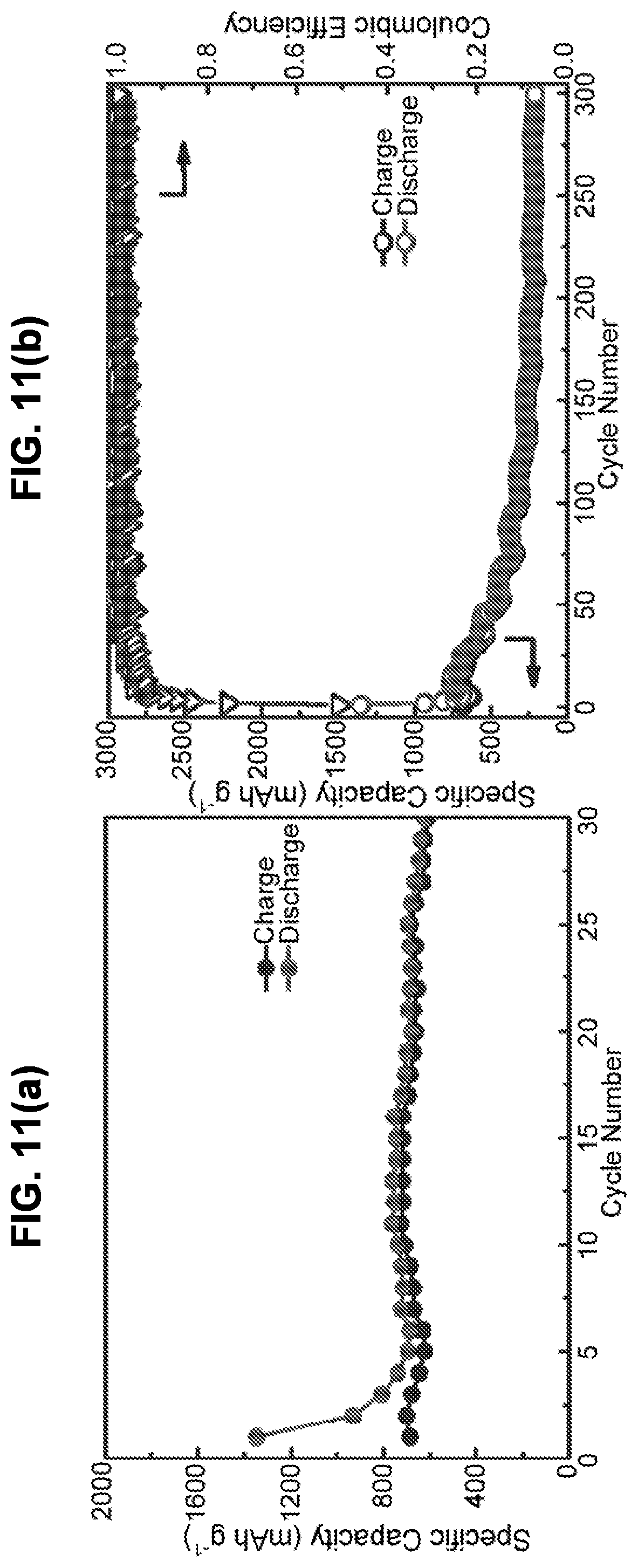
D00013
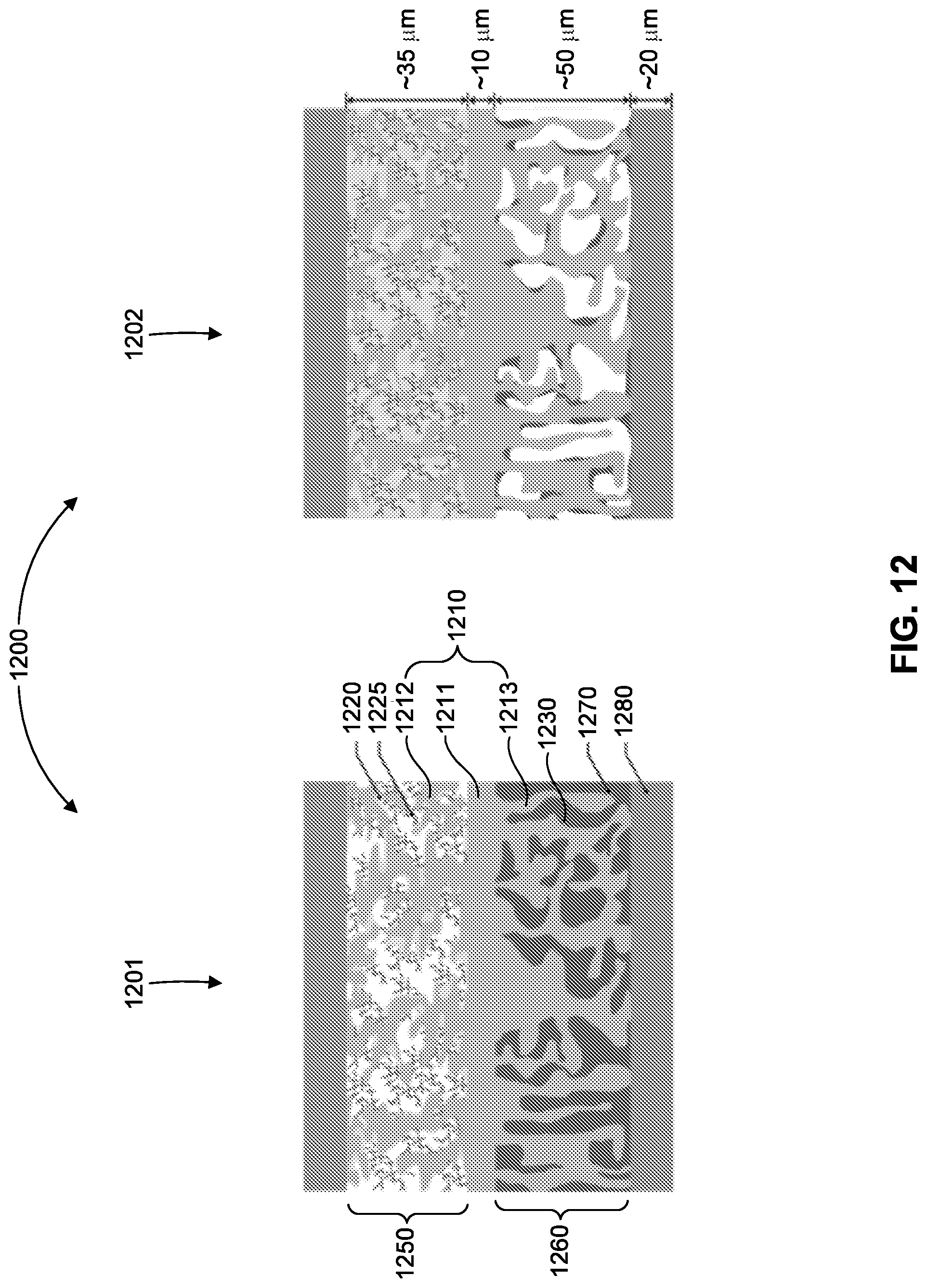
D00014
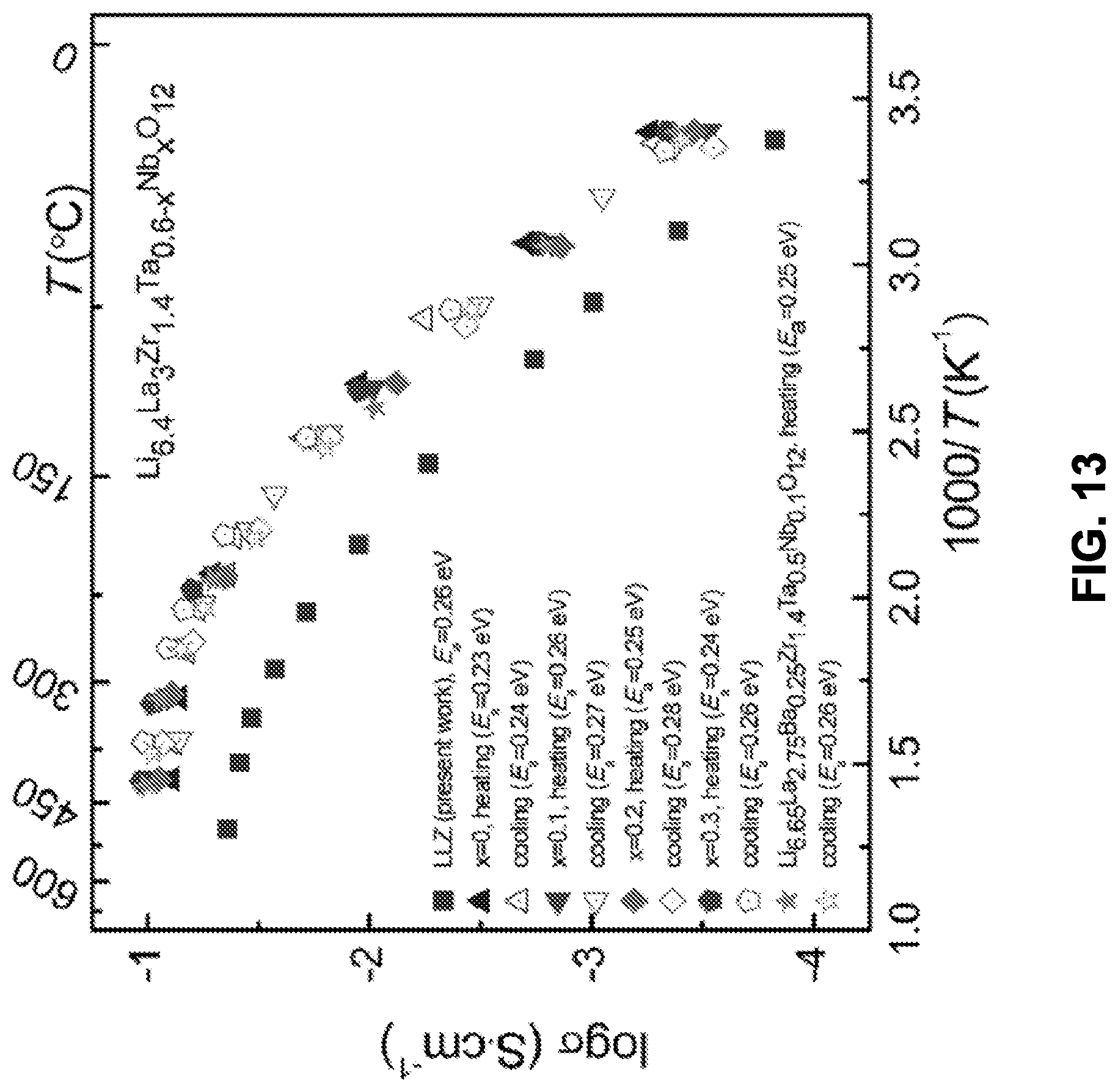
D00015

D00016

D00017
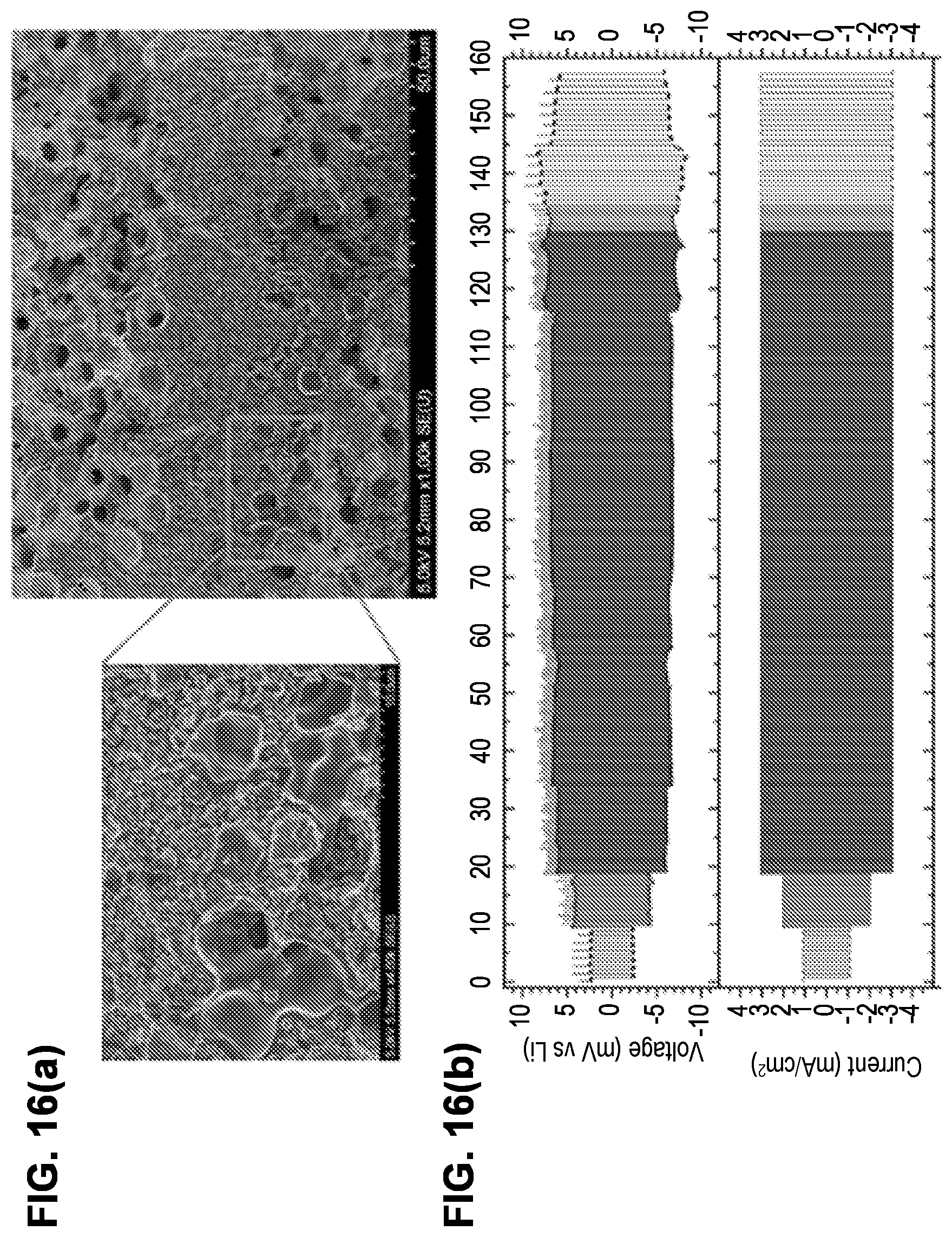
D00018
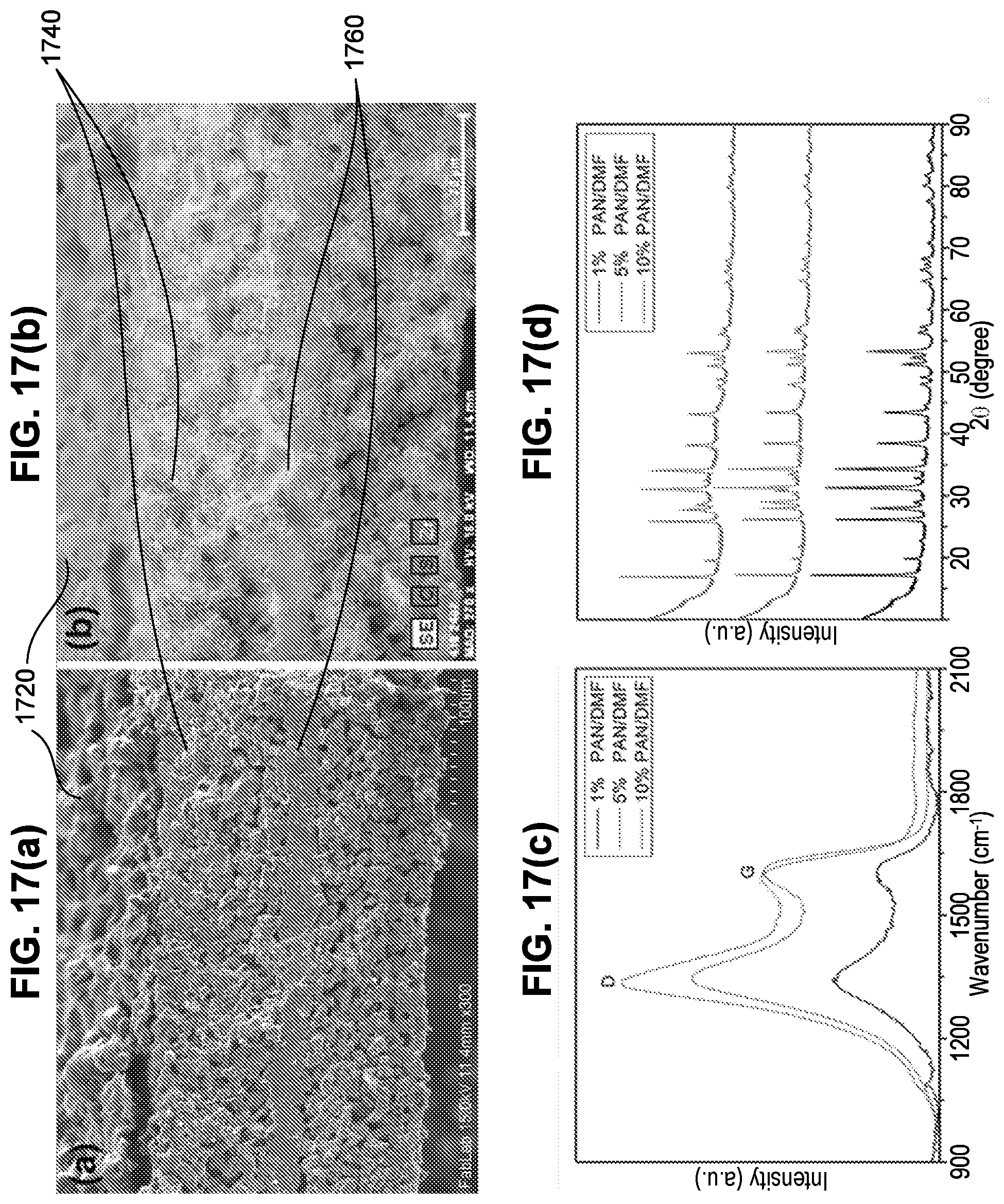
D00019
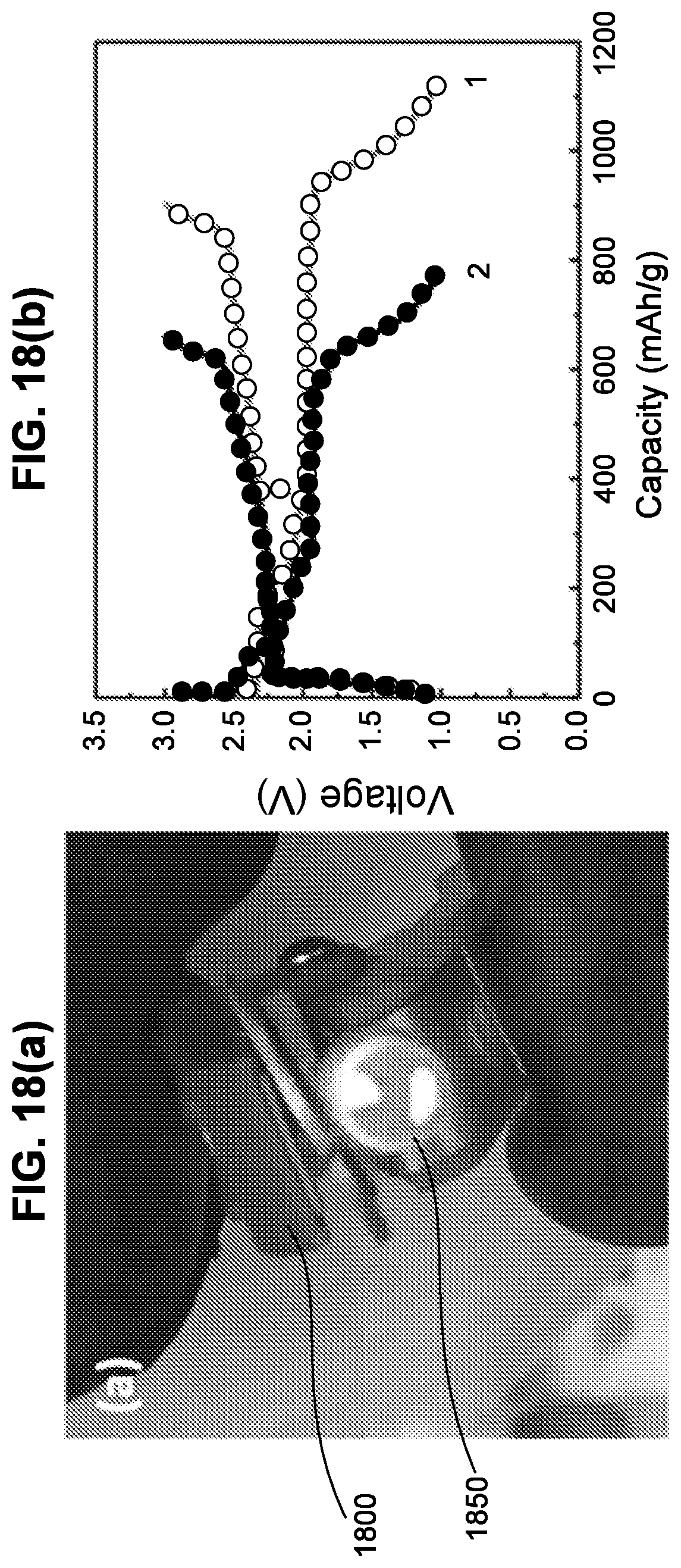
D00020
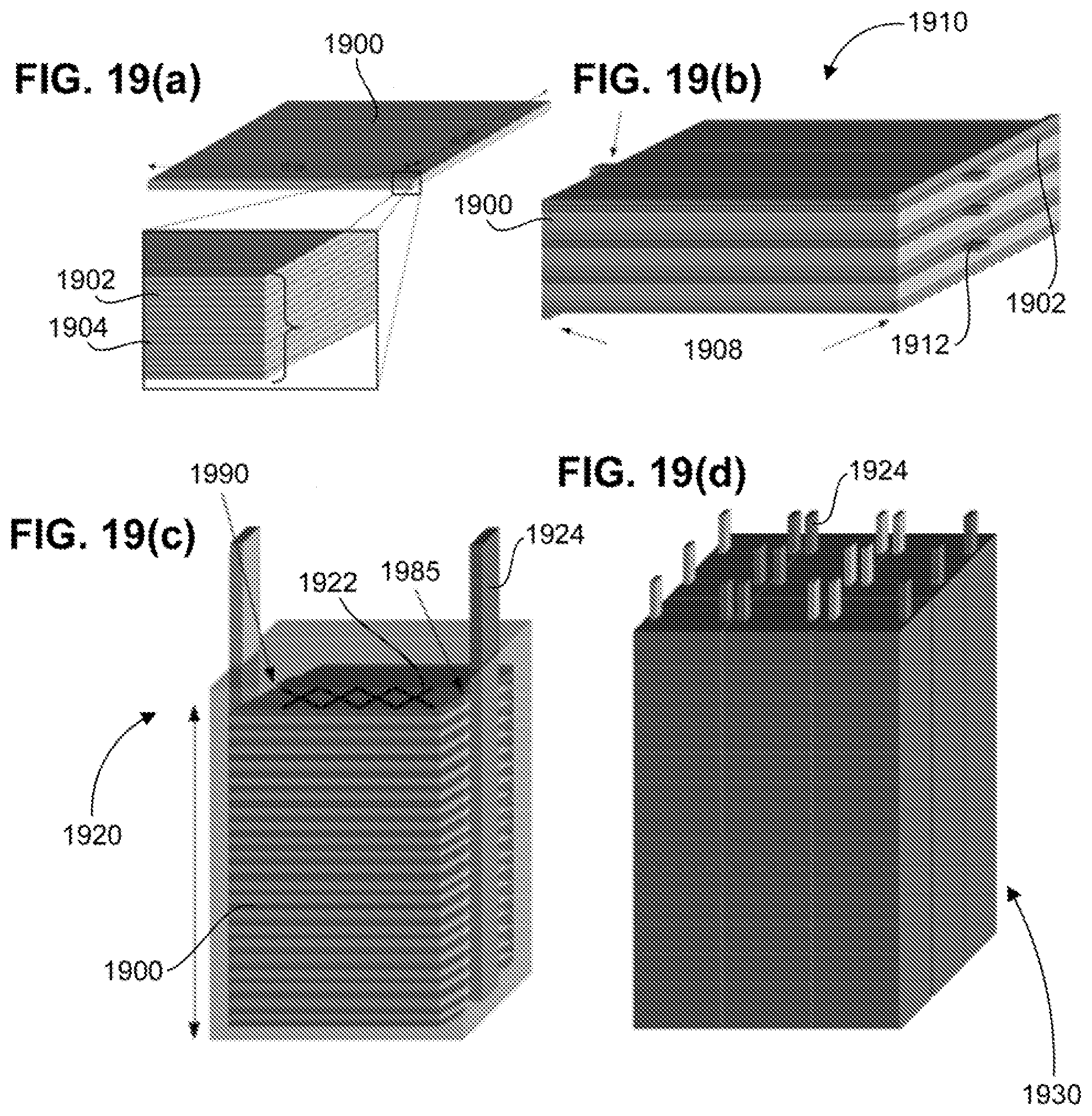
D00021
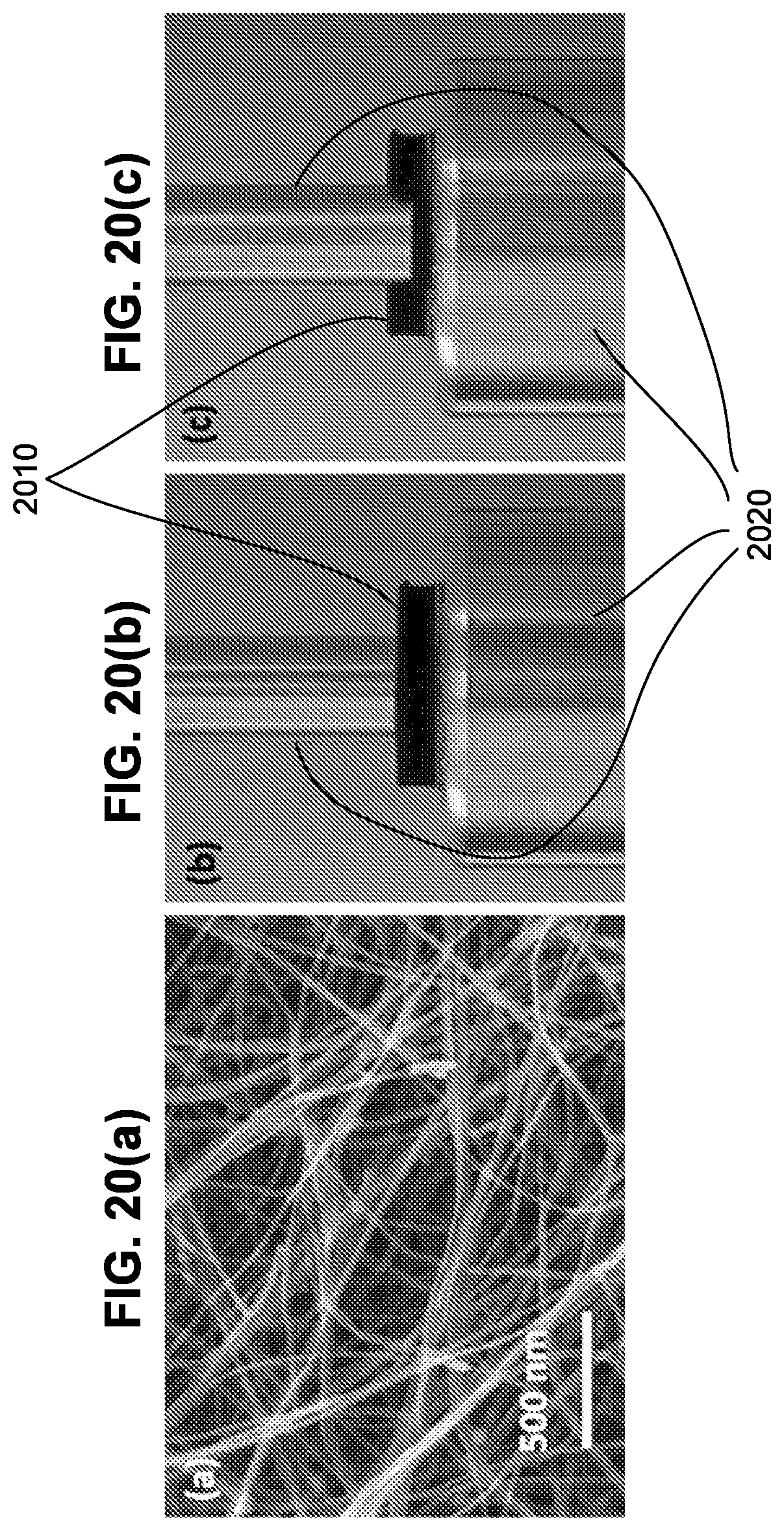
D00022

D00023

D00024
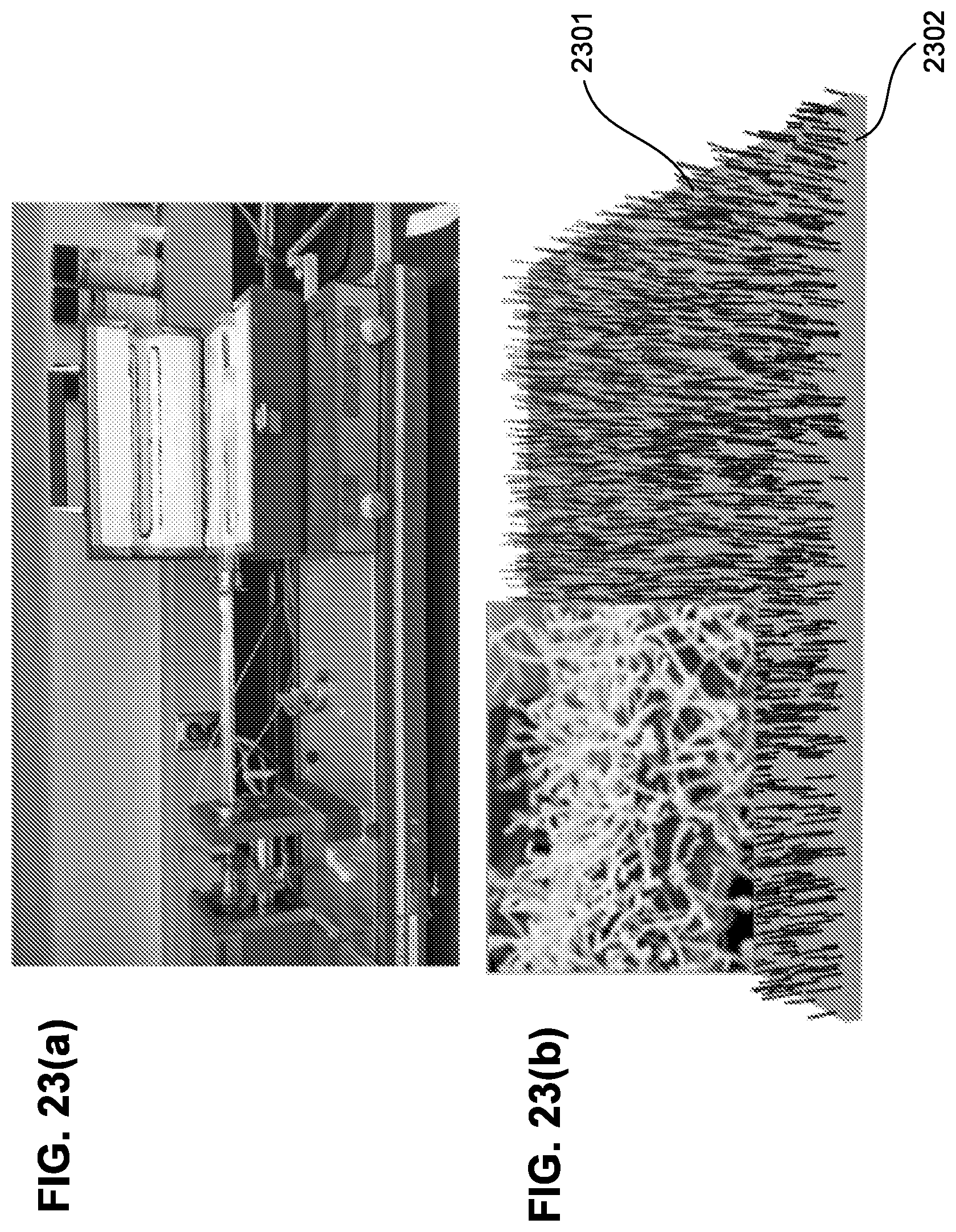
D00025

D00026
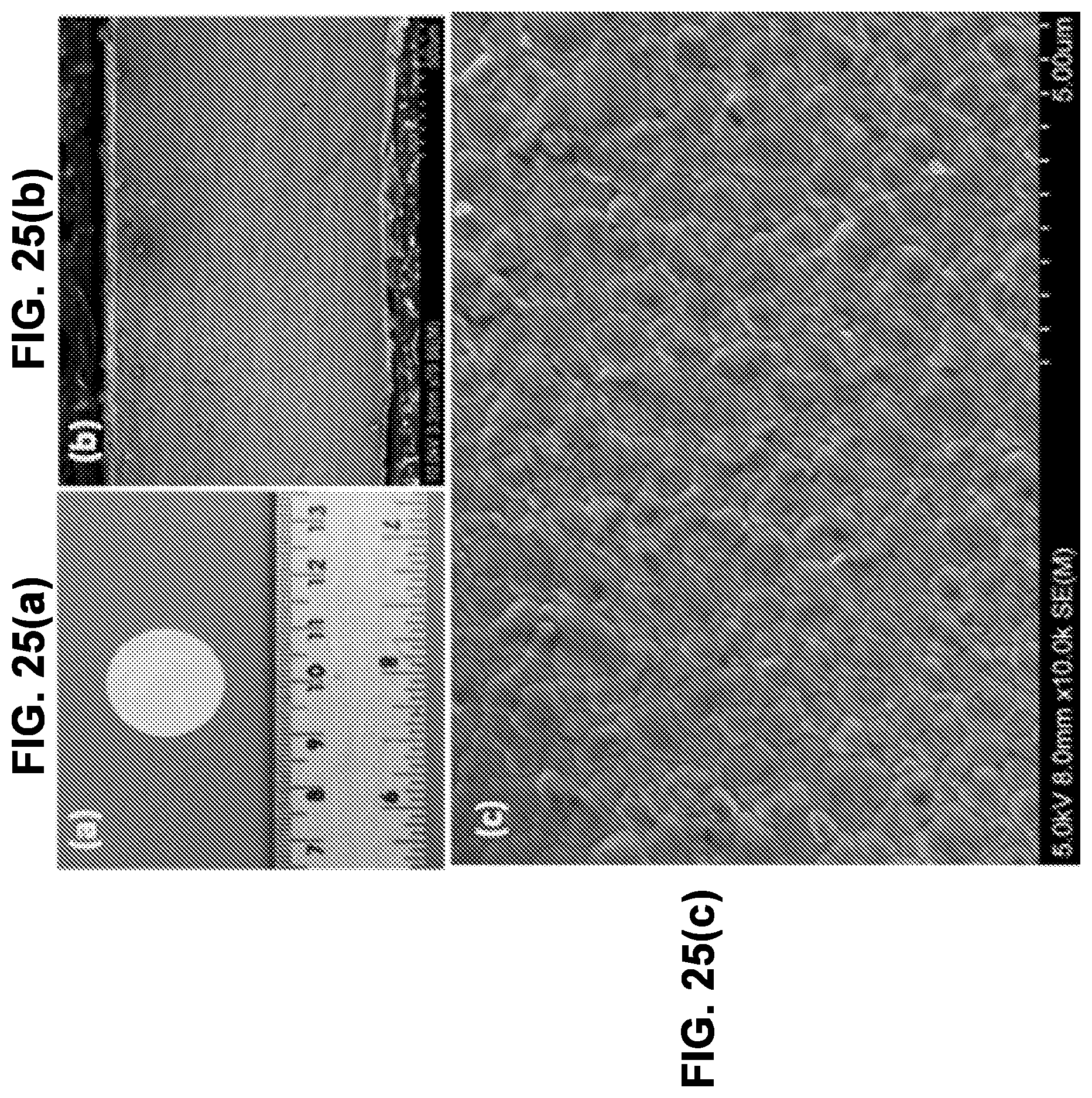
D00027

D00028
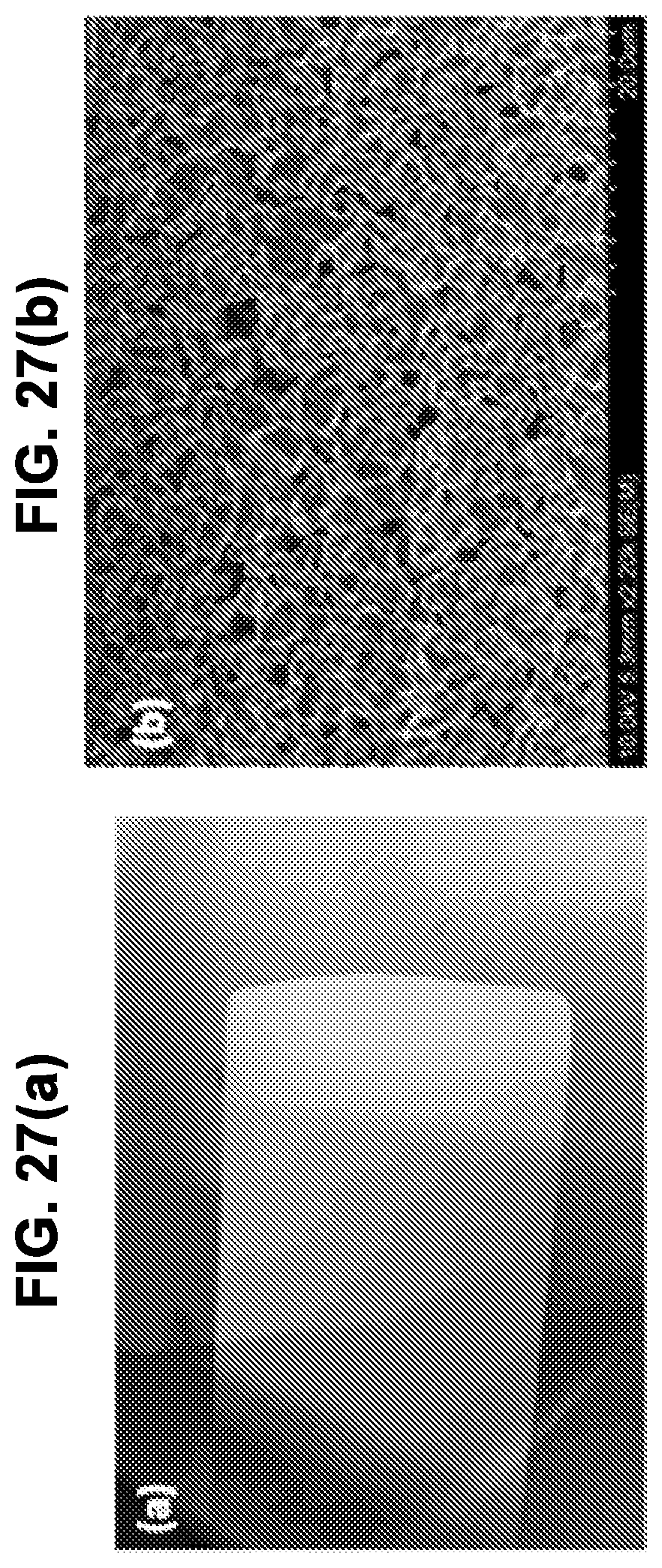
D00029
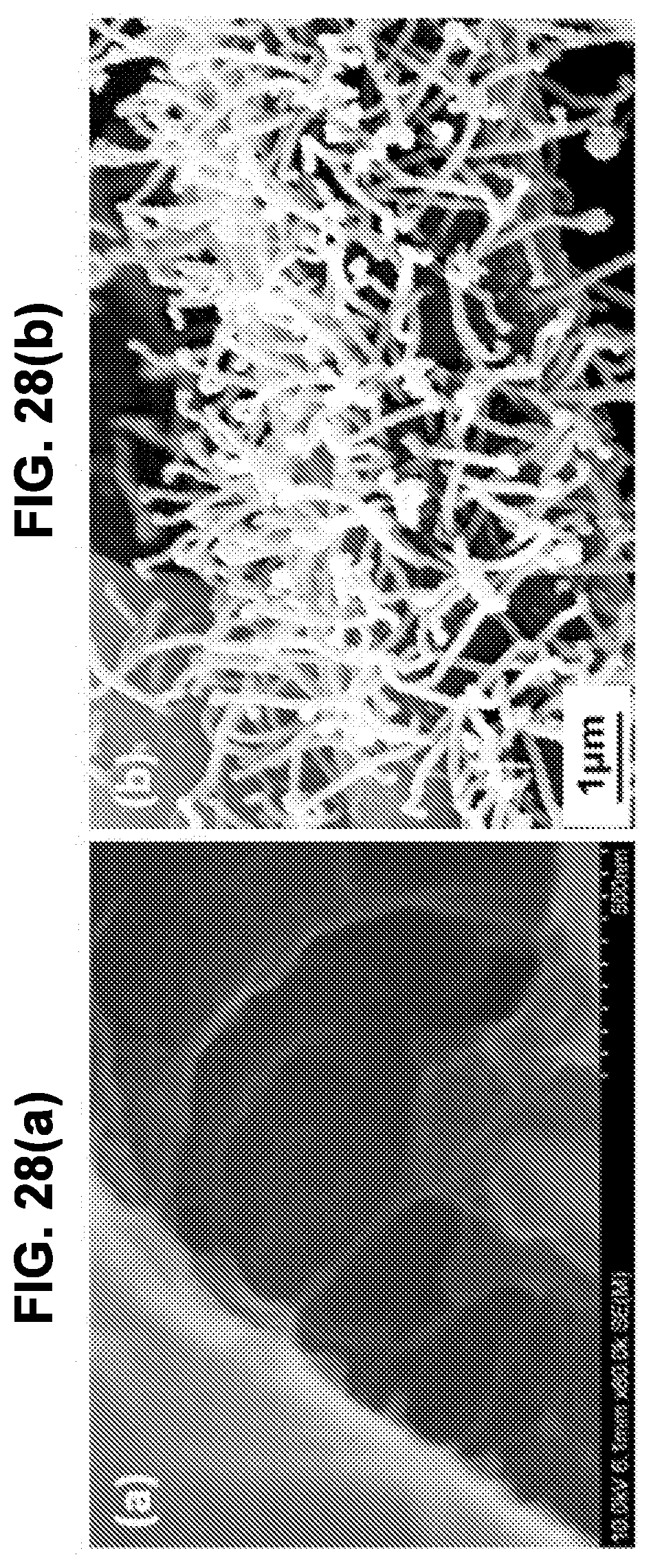
D00030
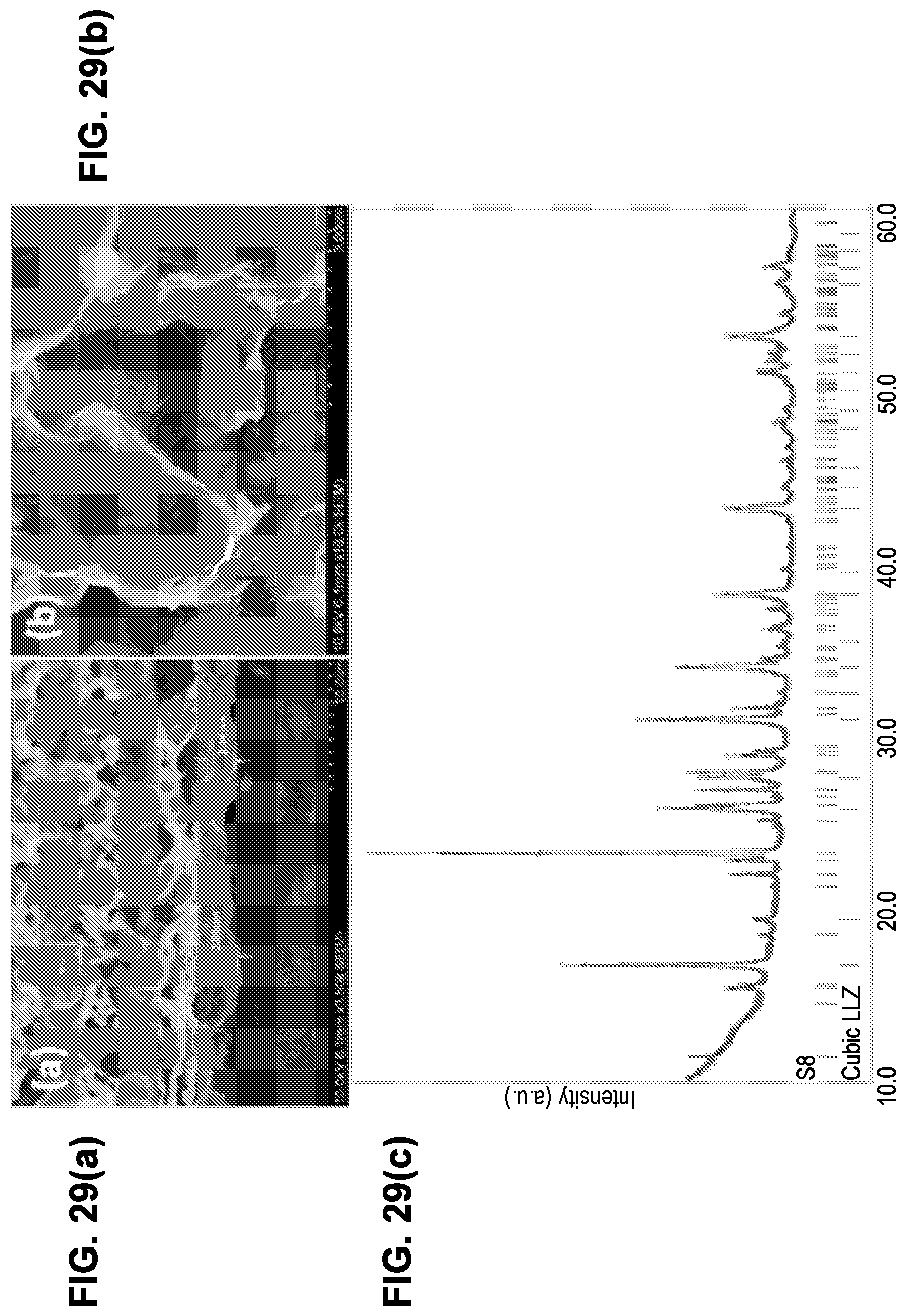
D00031

D00032
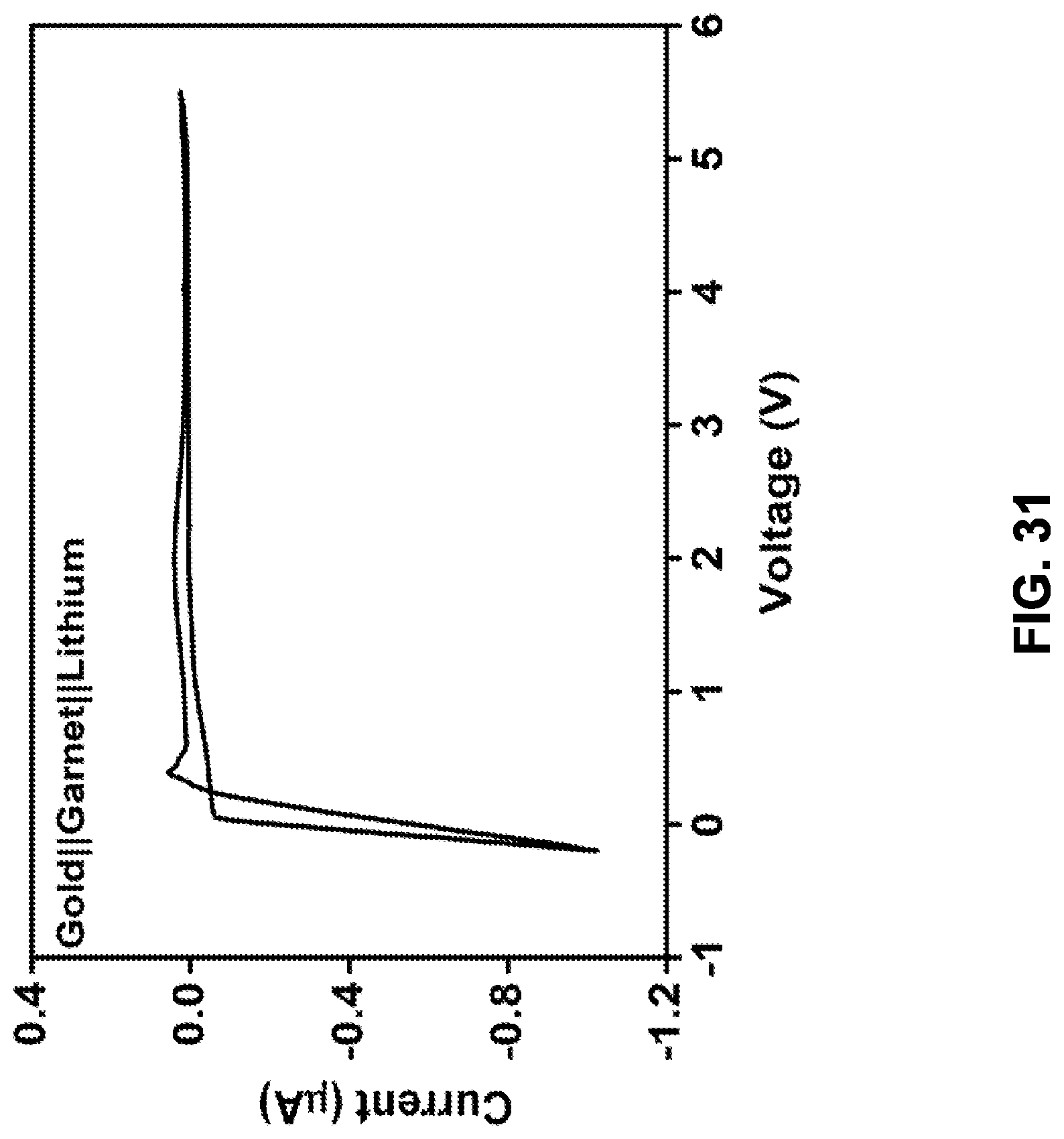
D00033
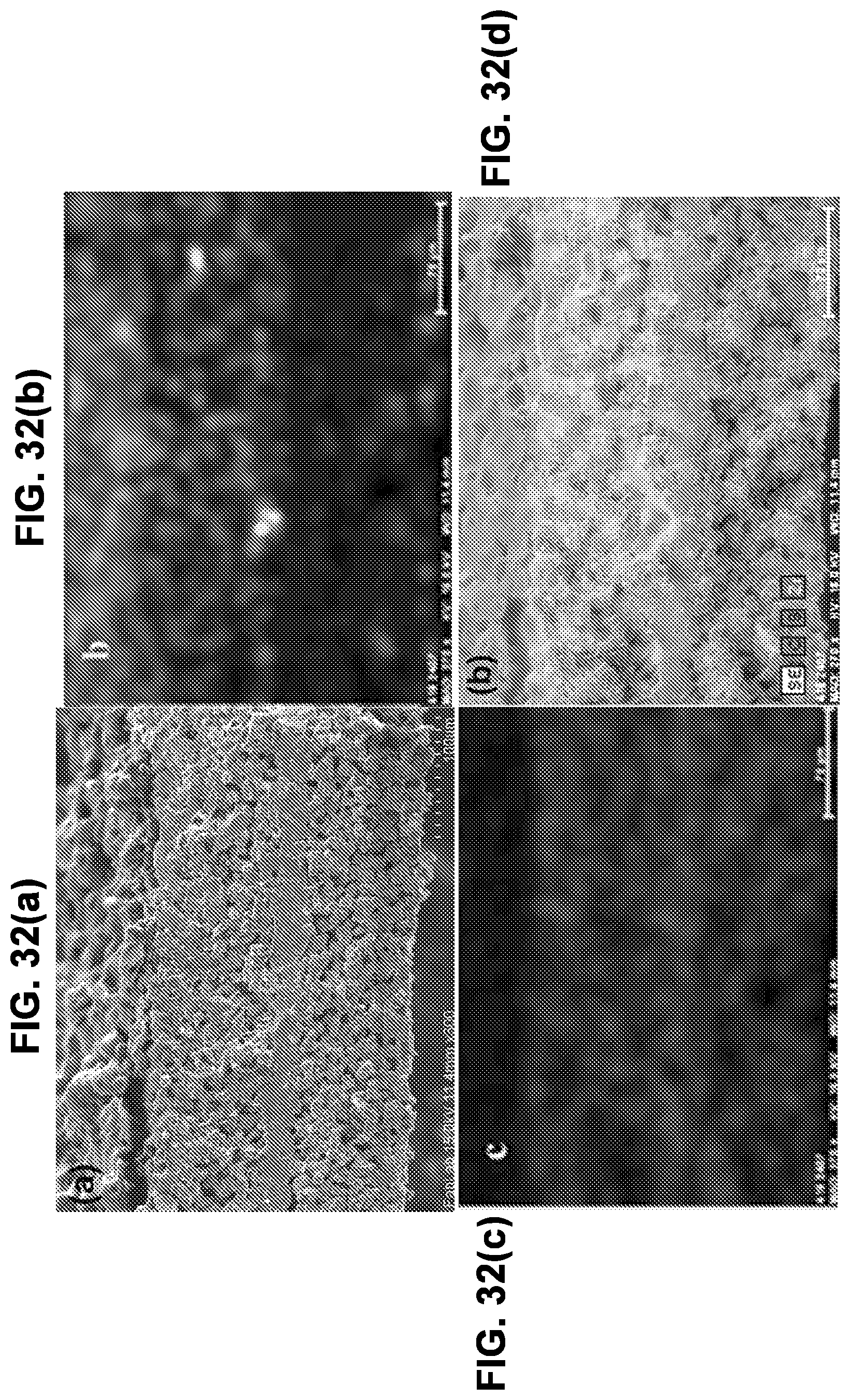
D00034

D00035
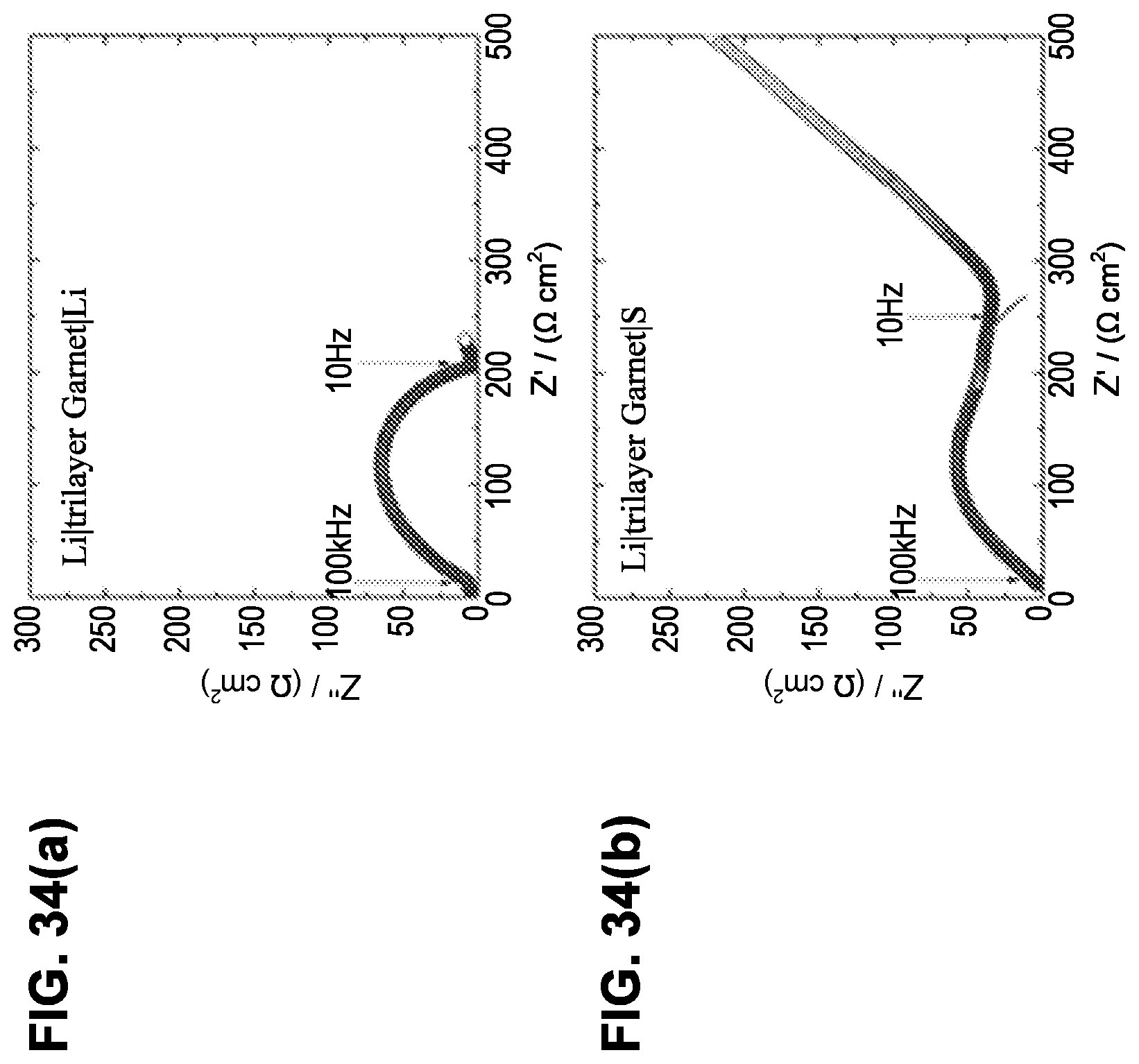
D00036
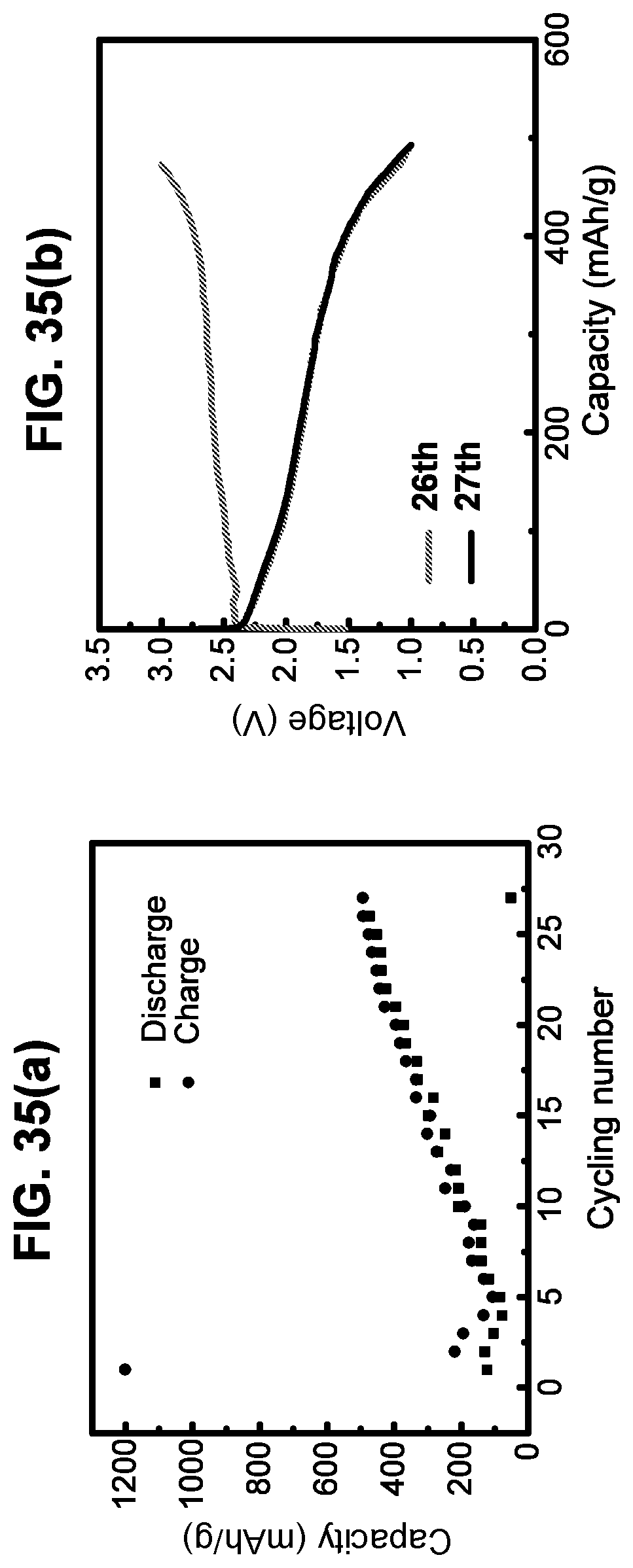
D00037
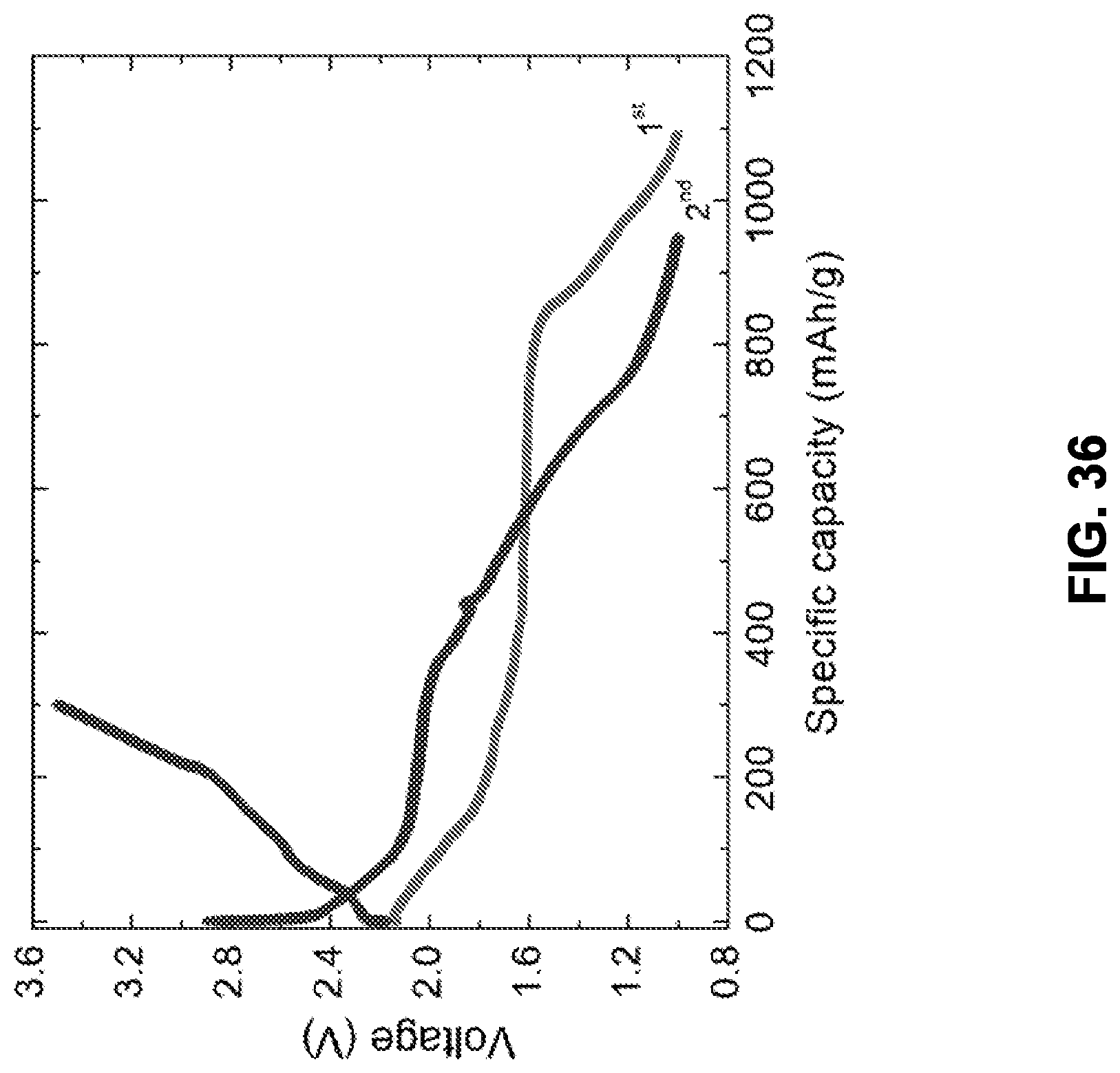
XML
uspto.report is an independent third-party trademark research tool that is not affiliated, endorsed, or sponsored by the United States Patent and Trademark Office (USPTO) or any other governmental organization. The information provided by uspto.report is based on publicly available data at the time of writing and is intended for informational purposes only.
While we strive to provide accurate and up-to-date information, we do not guarantee the accuracy, completeness, reliability, or suitability of the information displayed on this site. The use of this site is at your own risk. Any reliance you place on such information is therefore strictly at your own risk.
All official trademark data, including owner information, should be verified by visiting the official USPTO website at www.uspto.gov. This site is not intended to replace professional legal advice and should not be used as a substitute for consulting with a legal professional who is knowledgeable about trademark law.